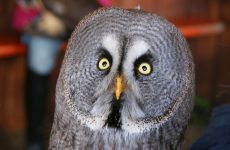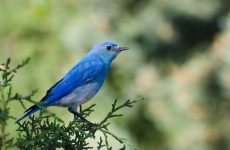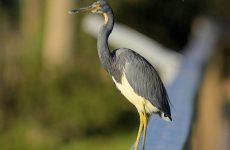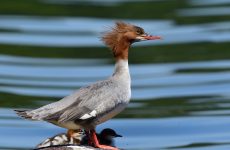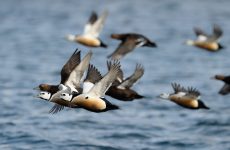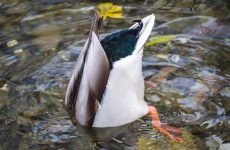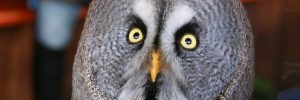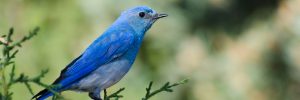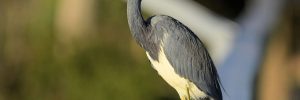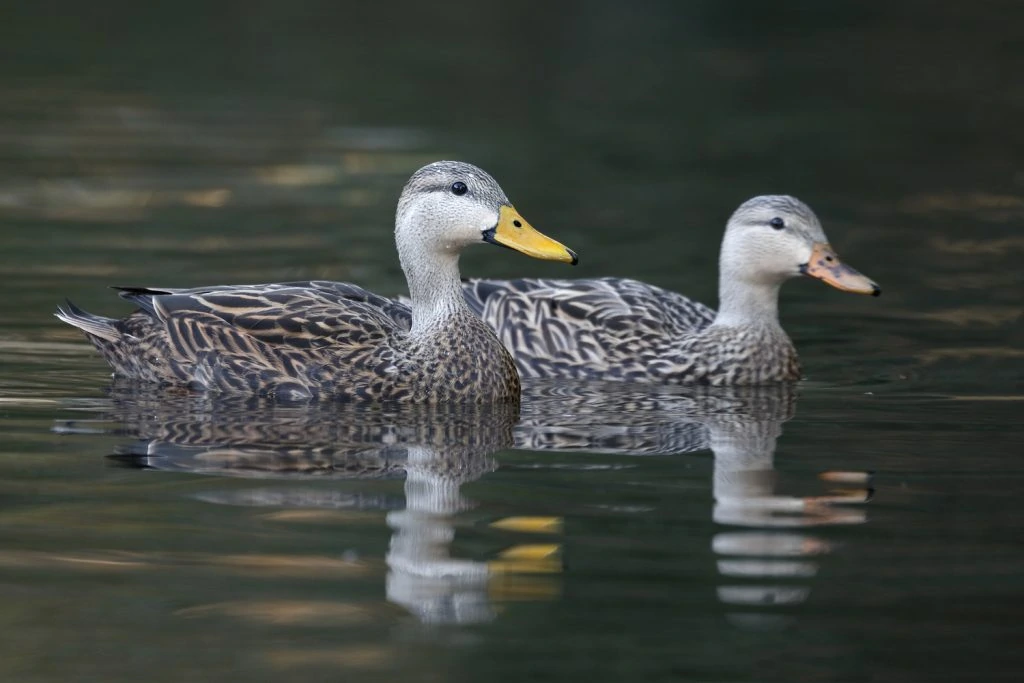
Most people know a few duck species, but I bet you’re surprised by the number of different types that can be spotted in the United States.
This guide will help you identify all the species of ducks that can be spotted in the United States with photo IDs and descriptions, audio recordings of their calls, fun facts, and more. Also, get a guide to help you identify ducks using clues such as ‘where is the white’ at the end of this article.
Ducks belong to many subfamilies, which also include swans and geese, but there is some debate and changing family groups for some species.
Ducks are omnivores and eat both plants and animals, especially insects, crustaceans, and small fish. They will eat plants both in the water and on land.
Ducks have hard pointed structures called lamellae around the edge of their beaks that look with teeth which they use to grasp vegetation and filter food through the water.
Male ducks are called drakes, and they are more colorful than females. Female ducks are either called ducks or hens. All domesticated ducks are descended from the mallard.
This guide will help you identify the types of ducks spotted in the United States that are classed as regularly occurring according to avibase and the American Birding Association and uses data collected from bird watchers on ebird to give real information about when these birds can be spotted.
Ducks In The United States By Season
Ducks in the United States all year: Mallard, Wood Duck, Gadwall, Northern Shoveler, Green-winged Teal, American Wigeon, Blue-winged Teal, American Black Duck, Northern Pintail, Cinnamon Teal, Muscovy Duck, Mexican Duck, Mandarin Duck, Garganey, Ring-necked Duck, Ruddy Duck, Redhead, Mottled Duck, Tufted Duck, Masked Duck, Hooded Merganser, Common Eider, Steller’s Eider, Fulvous Whistling-Duck
Ducks in the United States in summer: Spectacled Eider, Black-bellied Whistling-Duck
Ducks in the United States in winter: Eurasian Wigeon, Bufflehead, Lesser Scaup, Canvasback, Greater Scaup, Common Goldeneye, Red-breasted Merganser, Surf Scoter, Long-tailed Duck, White-winged Scoter, Black Scoter, Harlequin Duck, Barrow’s Goldeneye
Rare or accidental species in the United States: Falcated Duck, White-cheeked Pintail, Baikal Teal, Common Pochard, Smew, Common Shelduck
Types Of Ducks In The United States:
There are 18 types of dabbling ducks, 11 types of diving ducks, and 15 types of sea ducks that have been spotted in the United States.
Dabbling Ducks (18 Species)
Dabbling ducks are freshwater ducks that feed on the surface of the water or by tipping up their heads into the water and their rears into the air.
They sweep their heads from side to side while taking small ‘bites’ or ‘nibbles’ of the water to filter out plants. They also feed on land for seeds and grain or insects.
There is still some debate about whether some of these ducks should be included in a different subfamily, and these include Wood Ducks, Mandarin Ducks, and Muscovy Ducks.
1. Mallard
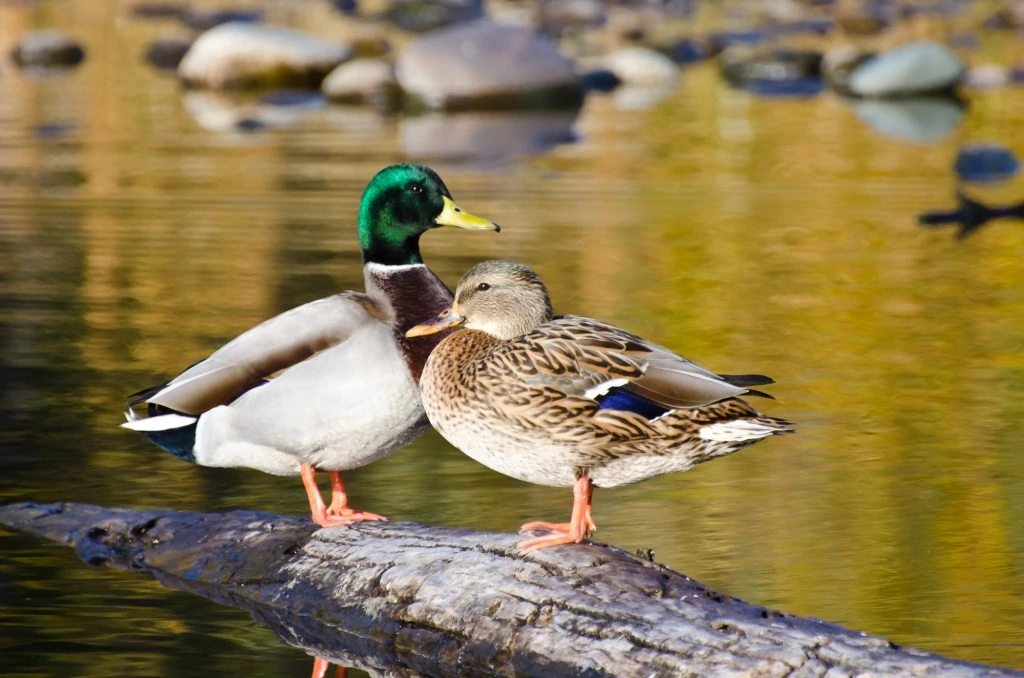
Mallards remain all year in most of the lower 48 and the western coast of Canada and Alaska. Those that breed in Canada and Alaska head south to the southern United States and northern Mexico.
They are recorded in 20% of summer and winter checklists submitted by bird watchers for the country.
Mallards are large ducks, and the males have striking green heads. They also have bright yellow bills and gray bodies with brown breasts and black towards the tail. They have a curl of tail feathers and a blue patch on the wings bordered with white which is called a speculum.
Females and juveniles are mottled brown with orange bills but still have the blue speculum.
- Anas platyrhynchos
- Length: 19.7 – 25.6 in (50 – 65 cm)
- Weight: 35.3 – 45.9 oz (1000 – 1300 g)
- Wingspan: 32.3 – 37.4 in (82 – 95 cm)
Mallards are one of the most commonly spotted and recognizable ducks that will happily be fed on ponds and rivers. They are dabbling ducks that feed on water plants and do not dive. They are very long-lived, and they have been recorded at 27 years old.
Mallard Calls:
Male Mallards don’t quack, only females do. Instead, the male makes a rasping sound.
Male Mallard Call
Female Mallard Call
Nests of Mallards are on the ground on land but close to the water. They are usually hidden under overhanging grass and made in a depression on the ground, filled with vegetation pulled from the surrounding area.
They lay up to thirteen eggs which take about 3 to 4 weeks to hatch, and the ducklings are ready to leave the nest almost immediately.
Fun Fact: Most domesticated ducks are descended from Mallards, and they have been hunted and bred for food.
2. Wood Duck
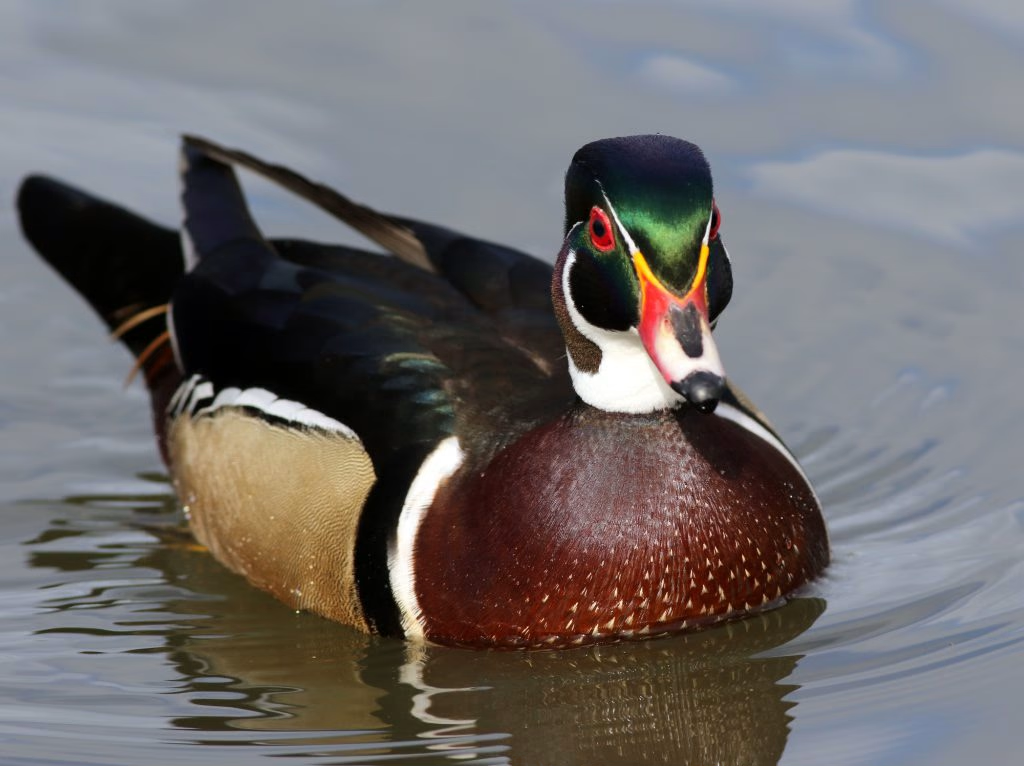
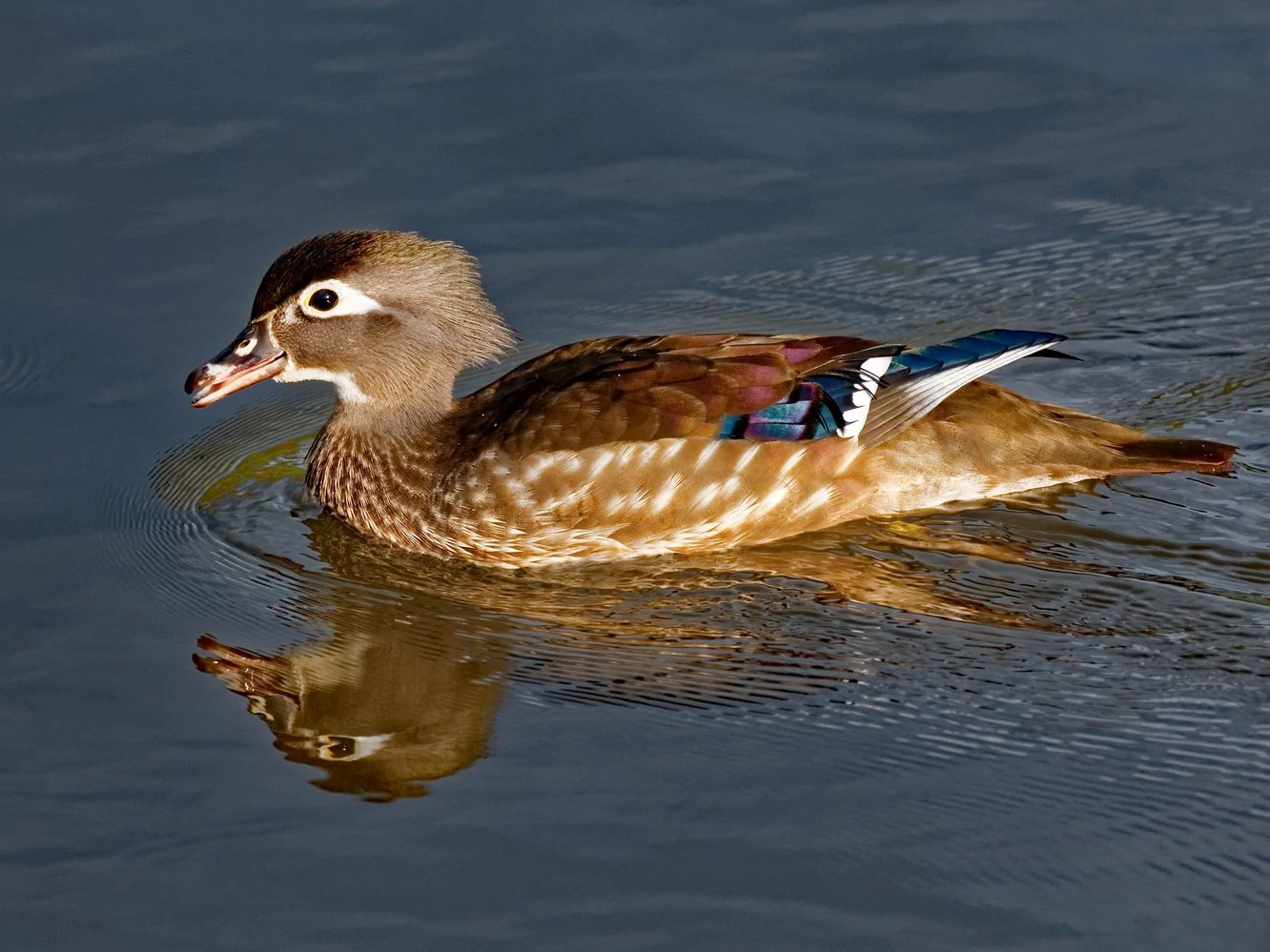
Wood Ducks are residents of eastern US states and along the Pacific Coast and parts of the northwest. Wood Ducks that breed in the north along the border with Canada migrate for winter to southern US states and Mexico.
They appear in 7% of summer checklists and 2% of winter checklists.
Male Wood Ducks have beautiful green heads with a striking crest at the back and black and white markings, and red eyes. They really are birds with great hairdos.
Their bodies are a checkerboard of colors, with reddish-brown chests, buff sides, brown backs and tails, white markings, and flashes of blue.
Females are brown with grayish-brown heads and white around their dark eyes. They have blue patches called speculum on their wings.
- Aix sponsa
- Length: 18.5 – 21.3 in (47 – 54 cm)
- Weight: 16.0 – 30.4 oz (454 – 862 g)
- Wingspan: 26.0 – 28.7 in (66 – 73 cm)
You can find Wood Ducks in wooded swamps, and they eat seeds, fruit, and insects, usually in the water, but they will also feed on land in fields and forests.
Wood Ducks Calls:
Male Wood Ducks make a rising whistle, and female Wood ducks make a distinctive 2-note call.
Male Wood Duck call
Female Wood Duck call
Nests of Wood Ducks are usually in tree cavities, very near to water, and may be up to 60 feet off the ground. Females line the nest with down feathers plucked from their breasts. They lay up to sixteen eggs, which take 4 or 5 weeks to hatch, and the young use their clawed feet to climb out before jumping out.
Fun Fact: Female Wood Ducks often lay their eggs in other Wood Duck nests to be raised by others.
3. Gadwall
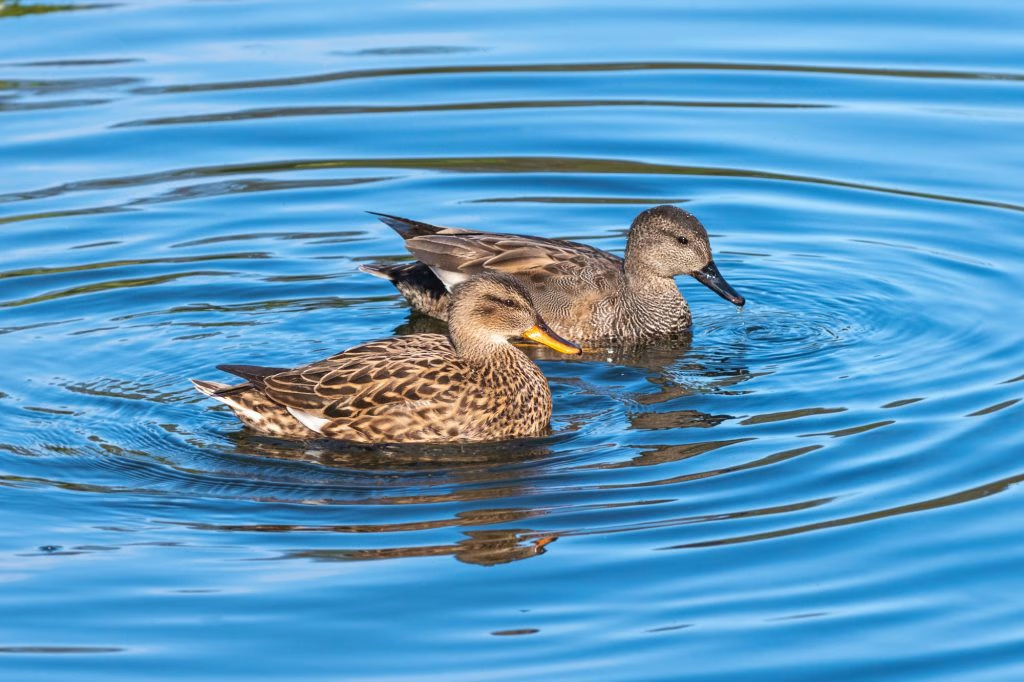
Gadwalls breed in the plains of the United States and Canada before migrating to central and southern US states and Mexico. Some remain all year on the West Coast.
They occur in 2% of summer checklists and 6% of winter checklists.
Gadwalls are large dabbling ducks that stand out despite their understated coloring. Compared to other bright and colorful dabbling ducks, Gadwalls are subtly colored with dark-brown heads, black, scaled patterns on the chest and shoulder, gray or white on their bellies, and black bottoms.
When in flight, a small, white patch can be seen on their wings. Females are generally brown all-over, with a more diffused scale pattern on their shoulder, back, chest and bottom.
- Mareca strepera
- Length: 19 – 23 in (48 – 58 cm)
- Weight: 35.27 oz (1000 g)
- Wingspan: 31 – 36 in (79 – 91 cm)
You can find Gadwalls in open wetlands, grasslands, and marshes with dense vegetation. In winter, you can see Gadwalls in saltwater marshes, city parks, reservoirs, and muddy estuaries.
Gadwalls feed themselves by dabbling in shallow water. They submerge their heads until they can reach for plants and other vegetation underwater. They may occasionally feed on insects, too.
Gadwall Calls: Male Gadwalls make short reedy whistles, followed by a quack. Females quack and sound similar to mallards.
Male Gadwall call
Female Gadwall call
Nests of Gadwalls are often hard to find because they’re hidden in dense vegetation near water. They are made with grass and weeds and lined with feathers. There may be as many as fifteen eggs in a nest. The female incubates them for about twenty-seven days until they’re hatched.
Fun Fact: Gadwalls sometimes steal food from other dabbling ducks as they surface from diving.
4. Northern Shoveler
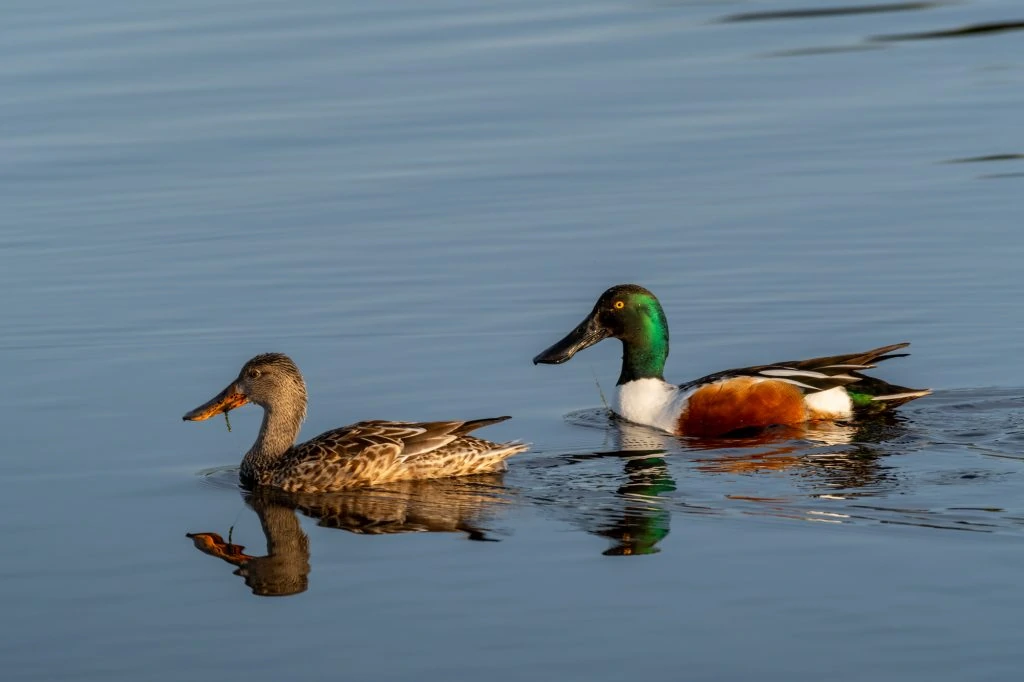
Northern Shovelers spend the winter in the southern half of the US and along the Pacific and Atlantic Coasts up to Canada. They breed in the western half of Canada and northwestern US states in the summer. Some also breed around the Great Lakes.
They are recorded in 2% of summer checklists and 6% of winter checklists.
Northern Shovelers are dabbling ducks, and males have green heads and large spoon-shaped black beaks that make them easy to spot. They have reddish-brown sides, white chests, and black backs. Males also have blue patches on the wings.
Females are mottled brown with a blue shoulder patch and large orange beaks.
- Spatula clypeata
- Length: 17.3 – 20.1 in (44 – 51 cm)
- Weight: 14.1 – 28.9 oz (400 – 820 g)
- Wingspan: 27.2 – 33.1 in (69 – 84 cm)
You can find Northern Shovelers in sociable groups in shallow, stagnant water.
Crustaceans, invertebrates, and some seeds make up the diet of shovelers, and they filter them out by stirring up the bottom and swinging their bills from side to side through the water. They then push the water out through comblike projections called lamellae along the edge of their bills, catching any food.
Northern Shoveler Calls: Male Northern Shoveler calls sound like ‘hook-hook’ or ‘took-took’. Females have a nasal quack.
Male Northern Shoveler call
Female Northern Shoveler call
Northern Shovelers nest on the ground in short vegetation close to water. They lay around ten eggs, which take 3 to 4 weeks to hatch. The ducklings are able to walk and swim immediately.
Fun Fact: Northern Shovelers will sometimes form large groups that swim in circles to help stir up the bottom for feeding.
5. Green-winged Teal
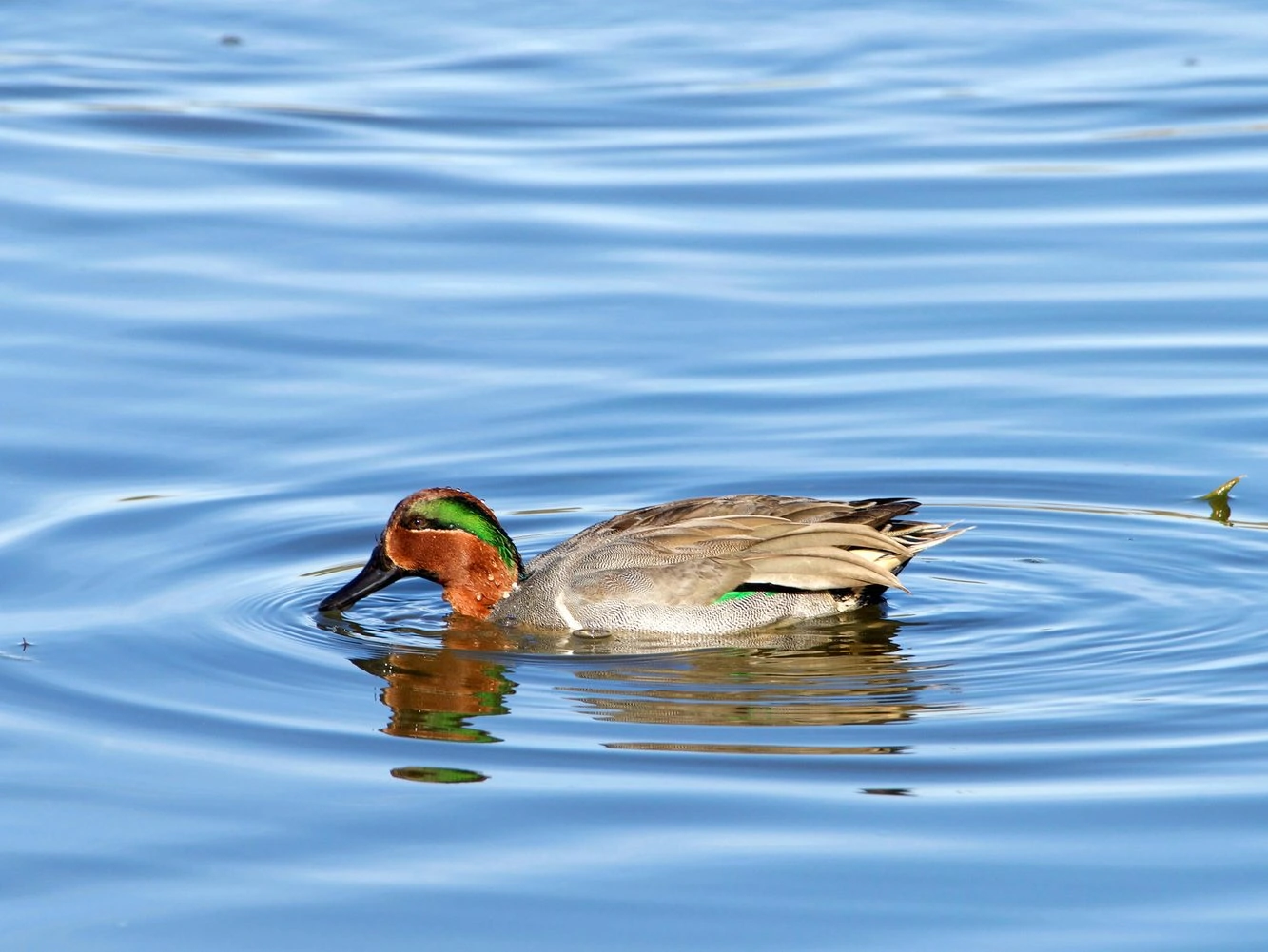
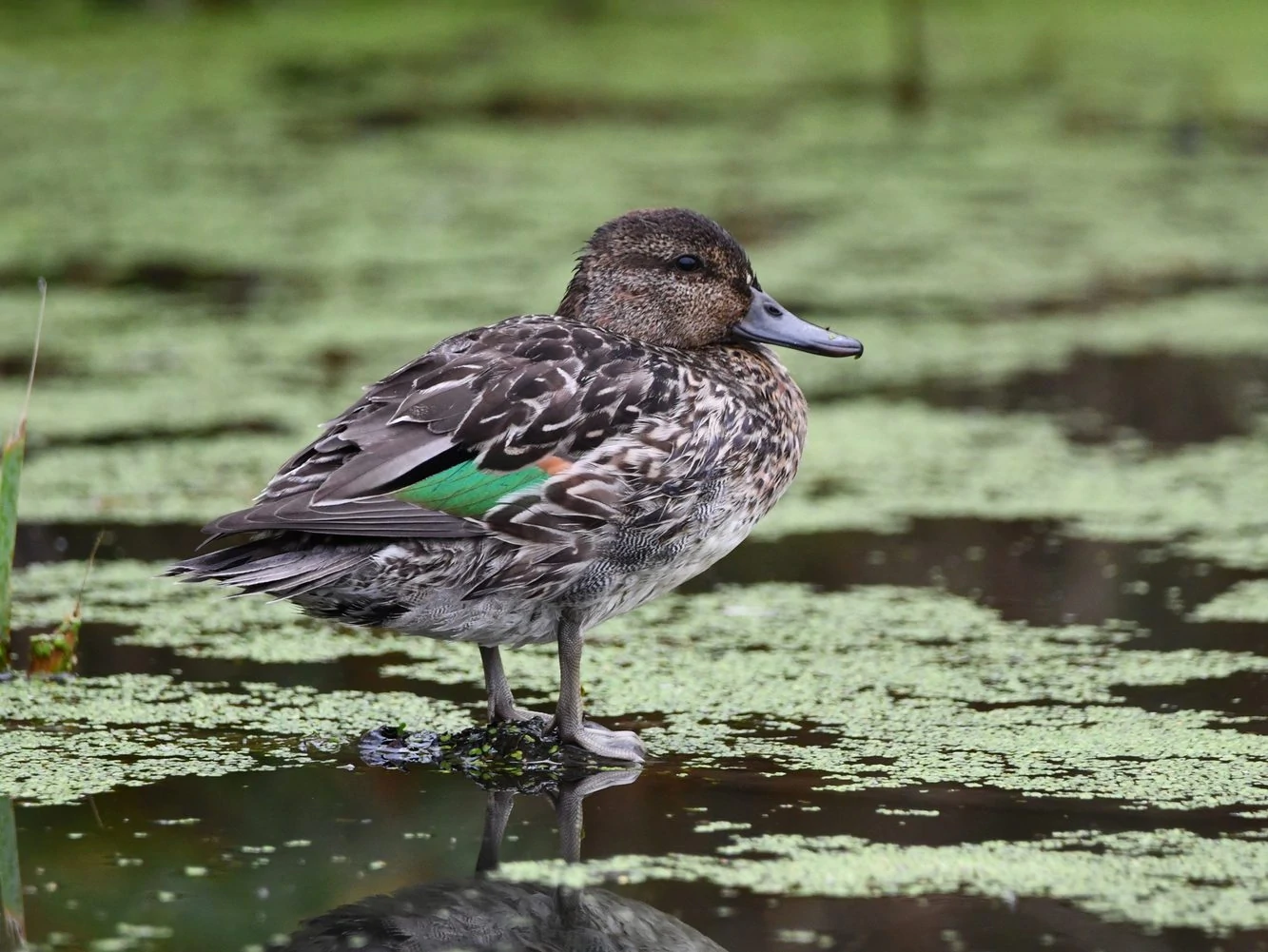
Most Green-winged Teals migrate from breeding grounds in Alaska, Canada, and northern US states to the southern US states and the Pacific Coast. However, some ducks remain around the Rocky Mountains all year.
They are most common in the United Stated during migration and appear in 7% of checklists during these times.
Green-winged Teals are small dabbling ducks. Males have a green stripe along the sides of their heads. The rest of their heads are brown, and they have grayish bodies.
Females are brown with a yellow streak along the tail. Both males and females have a green wing patch.
- Anas crecca
- Length: 12.2 – 15.3 in (31 – 39 cm)
- Weight: 4.9 – 17.6 oz (140 – 500 g)
- Wingspan: 20.5 – 23.2 in (52 – 59 cm)
You can find Green-winged Teals on flooded ground and shallow ponds in large flocks of up to 50 thousand. They feed on invertebrates and seeds.
Nests of Green-winged Teals are on the ground in dense cover such as grass or thickets.
Green-winged Teal Calls: Male Green-winged Teals whistle and chatter, and females have a high-pitched quack.
Male Green-winged Teal
Female Green-winged Teal
Nests of Green-winged Teals are on the ground in meadows and grasslands and near water. They lay up to nine eggs, which take around three weeks to hatch. The ducklings are ready to leave the nest almost immediately.
Fun Fact: Green-winged Teals don’t need to run across the surface of the water to take off. They can fly straight away as they are so agile.
6. American Wigeon
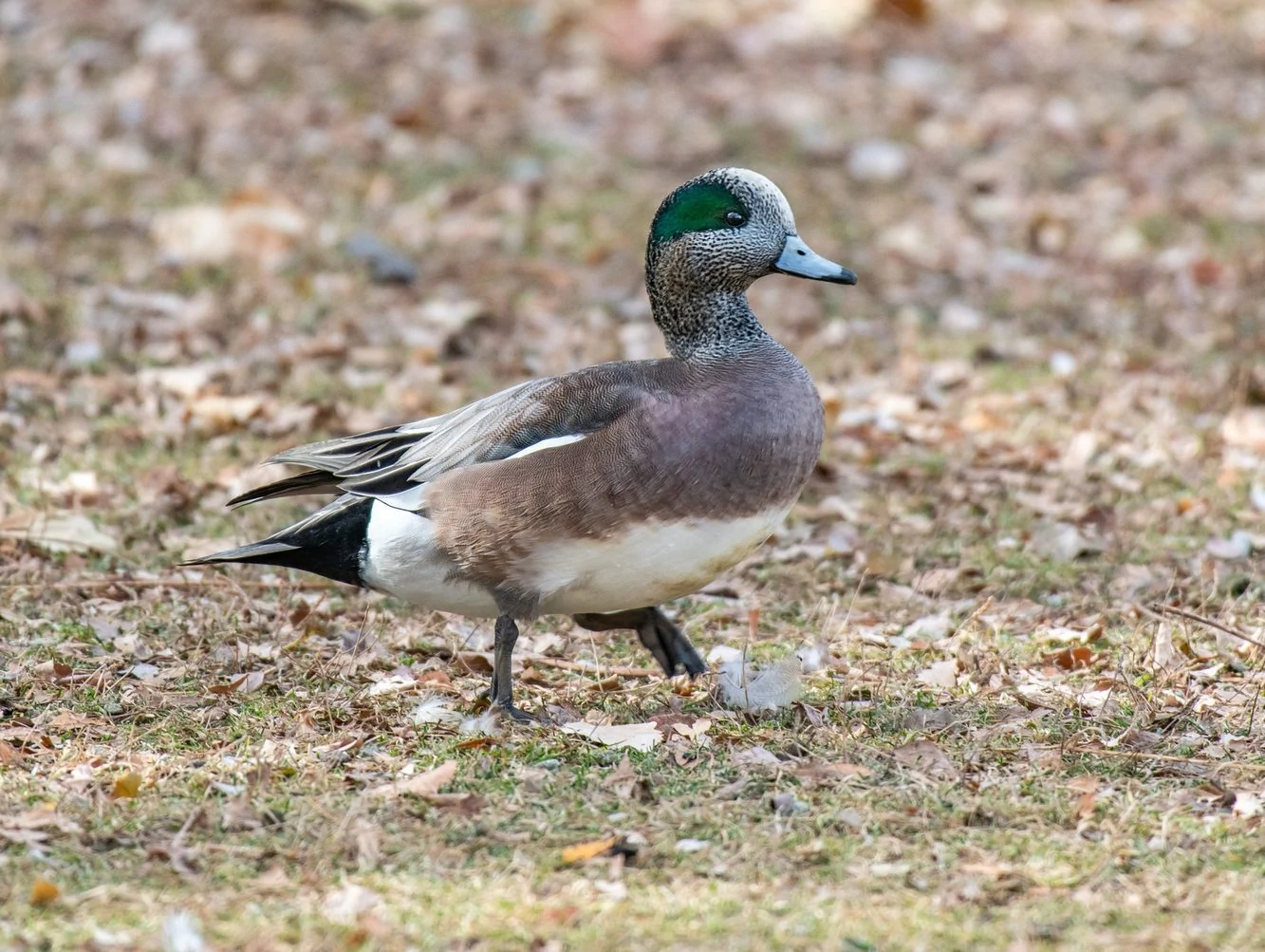
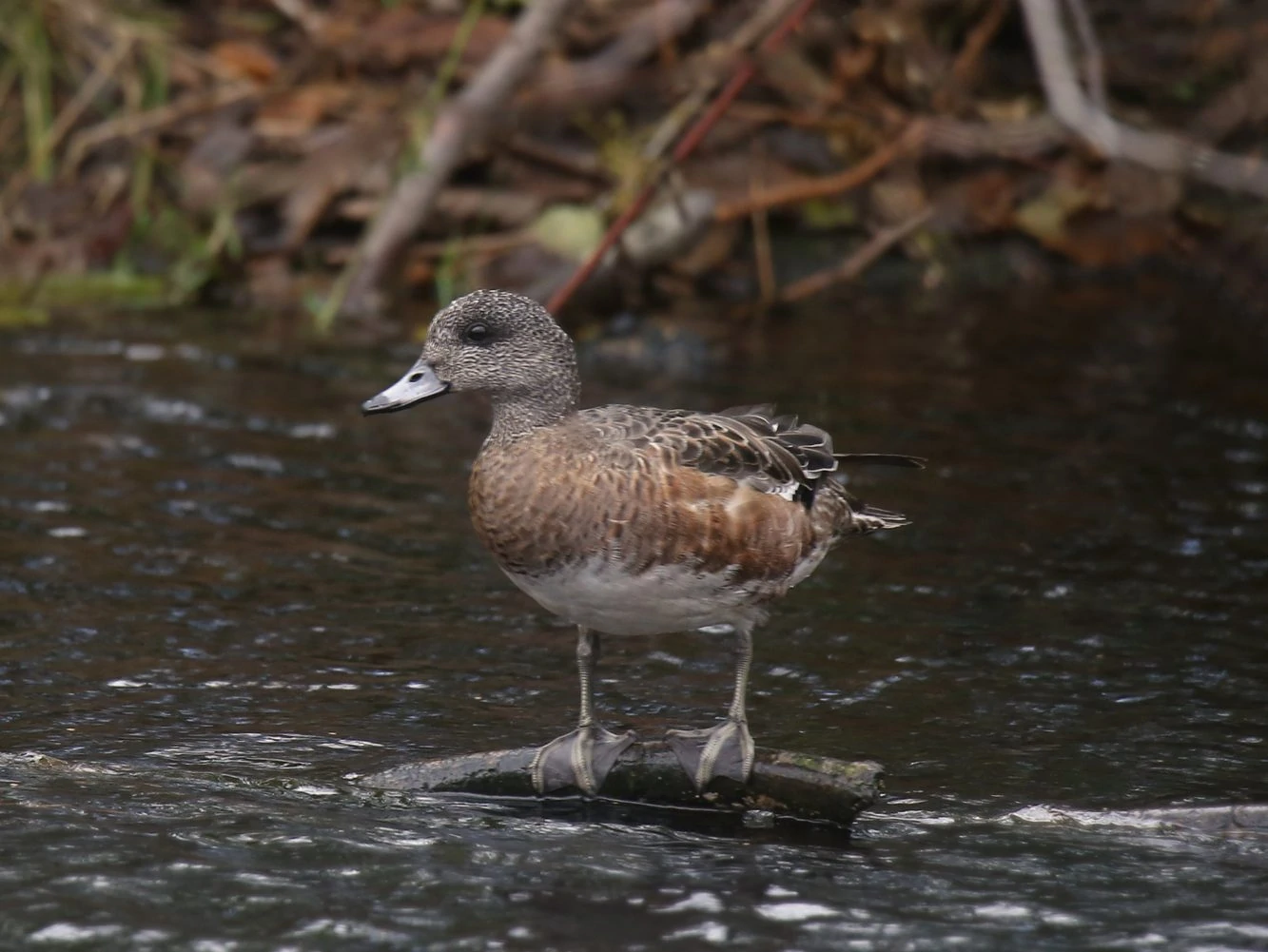
American Wigeons breed predominantly in Alaska, western Canada, and northwestern US states. They spend the winter in the southern and central US states and along the Pacific and Atlantic coasts.
They occur in 1% of summer checklists and 5% of winter checklists.
American Wigeons are small ducks with green stripes on the sides of their heads and with white caps on the males. The rest of them are grayish-brown.
Females are brown with grayish-brown heads. Male and females both have pale beaks.
- Mareca americana
- Length: 16.5 – 23.2 in (42 – 59 cm)
- Weight: 19.1 – 46.9 oz (540 – 1330 g)
- Wingspan: 33.1 in (84 cm)
You can find American Wigeons feeding on vegetation both in the water and on the land in wetlands, fields, and ponds. They will also eat insects and invertebrates.
American Wigeon Calls: Male American Wigeons give a high-pitched whistle, and females make a harsh grunt.
Male American Wigeon call
Female American Wigeon call
Nests of American Wigeons are on the ground, far from water in fields and grasslands. The female lines the depression in the ground with grass, reeds, and down feathers, then they lay up to 13 eggs which take 2 to 3 weeks to hatch. The ducklings leave the nest almost immediately.
Fun Fact: American Wigeons are known as ‘baldpate’ because their white stripe looks like a bald man’s head.
7. Blue-winged Teal
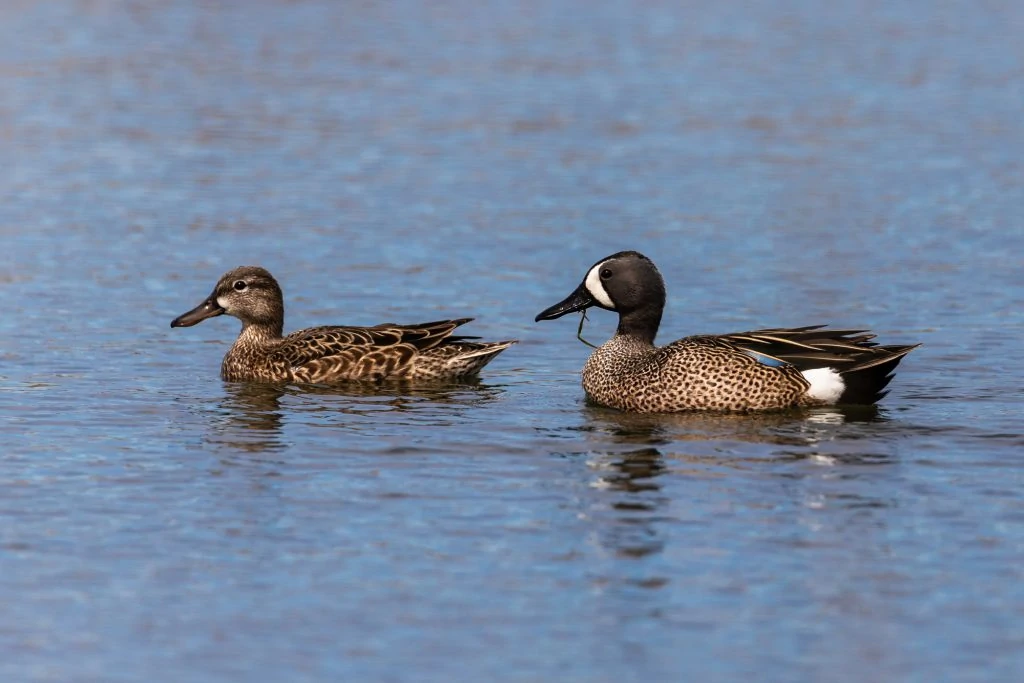
Blue-winged Teals are spotted in the United States all year. They breed in the north and migrate to the south for winter.
They are recorded in up to 2% of summer and winter checklists submitted by bird watchers for the country.
Blue-winged teals are small ducks from the Anatidae family. Their head is bluish-gray with a white crescent in front of their eyes. Their body is spotted brown from the chest to the tail.
When their wings are unfurled, there is a distinct blue patch on the shoulders bordered with green and white. Females have the same scaly, brown pattern on their bodies, but they have no distinctive white markings on their faces.
- Spatula discors
- Length: 15 – 17 in (38 – 43 cm)
- Weight: 19.18 oz (544 g)
- Wingspan: 23 -31 in (58 – 79 cm)
You can find Blue-winged Teals on shorelines with calm or sluggish water, so lakes and ponds with protruding trees and rocks are perfect. They also live around shallow water sources with abundant vegetation, like marshes and swamps. During the breeding season, you’ll find them in northern prairies and parklands.
Blue-winged Teals mostly eat aquatic plants that they find on the surface of their water. They may also eat aquatic insects, particularly during the breeding season.
Blue-winged Calls: They make high-pitched chattering calls, and females also quack.
Blue-winged Teals chattering calls
Female Blue-winged Teal Quack
Nests of Blue-winged Teals are often found in a hollow in the ground, sheltered behind tall grasses, and near a water source. They are built from grass and weeds and lined with down.
Females lay up to fifteen eggs that they incubate for 2 to 3 weeks. The young ducklings may be able to walk a few hours after hatching, but they can only fly after six to seven weeks.
Fun Fact: Because of their long, over-ocean migration patterns, Blue-winged Teals have the highest mortality rate among dabbling ducks.
8. American Black Duck
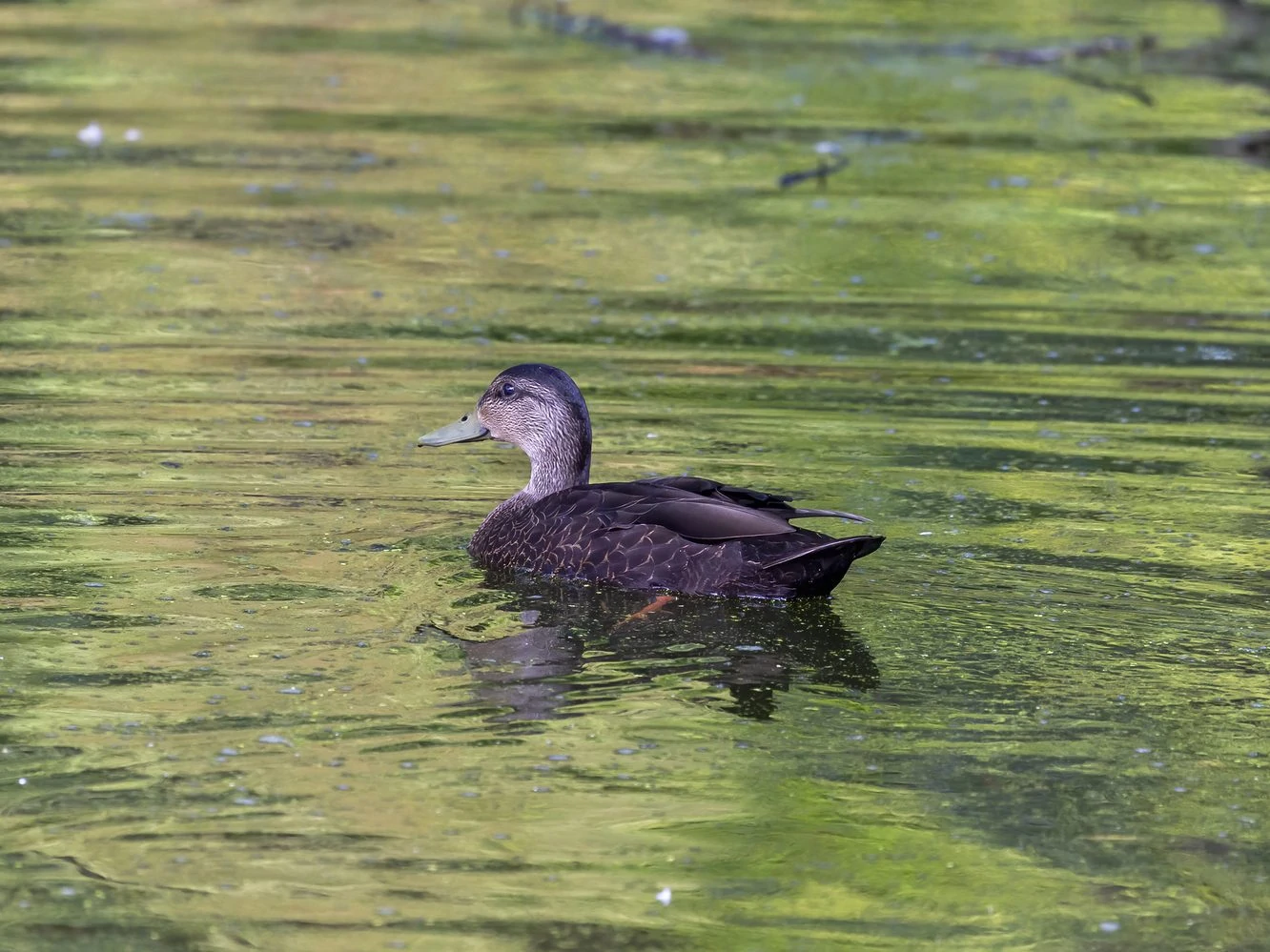
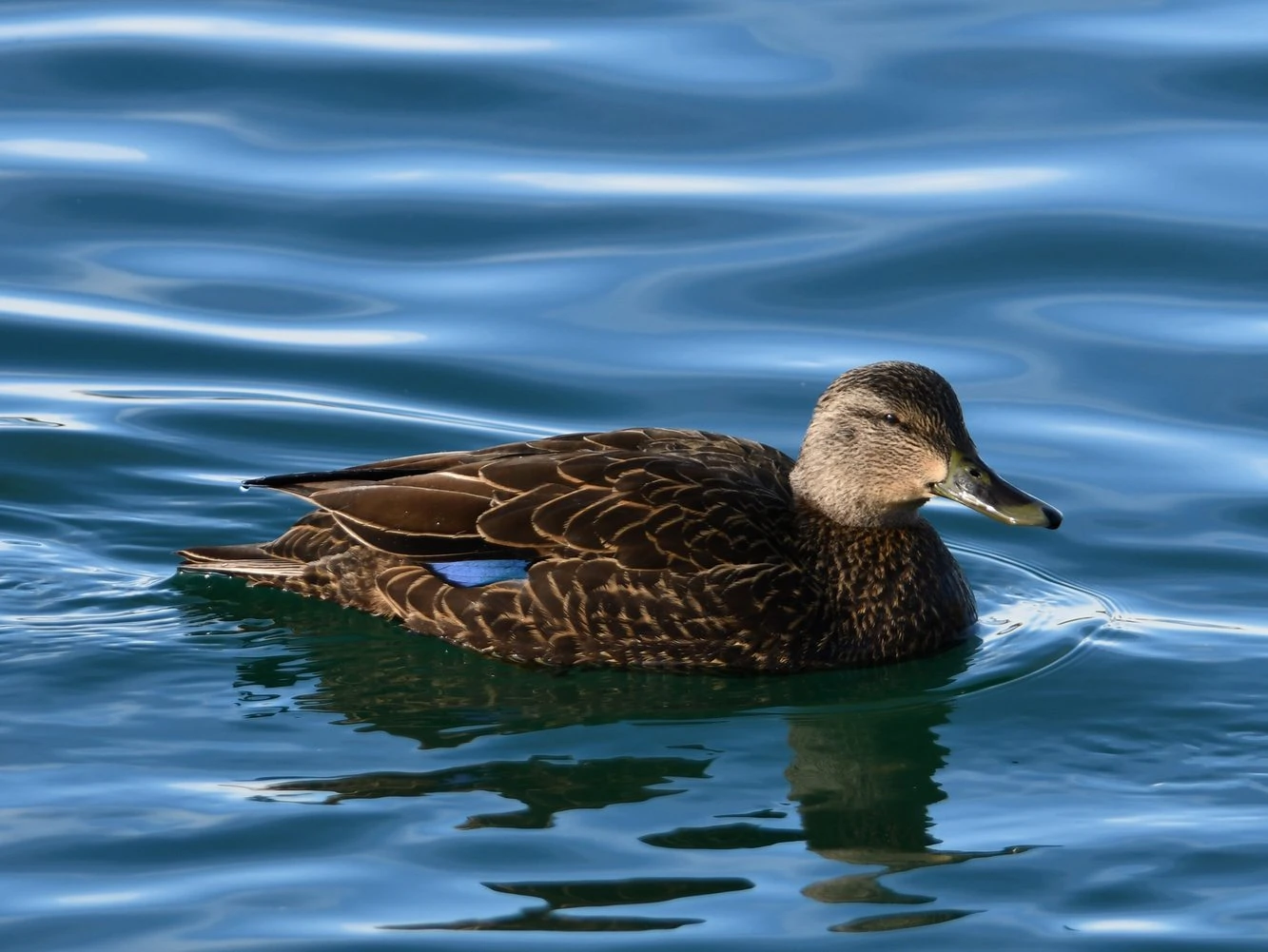
American Black Ducks are spotted in the east of the United States and are most common during winter in the northeast of the country. They appear in 4% of checklists at this time.
American Black Ducks are large, heavy ducks from the Anas family. They’re quite possibly the heaviest ducks in the species. Males and females have the same dark brown bodies and pale brown heads. Males have a yellow bill, and females have an olive one. The only bright colors on their bodies are the blue-purple patch on their wings and their red-orange legs.
- Anas rubripes
- Length: 19 – 23 in (48 – 58 cm)
- Weight: 49.6 oz (1406 g)
- Wingspan: 33 – 36 in (84 – 91 cm)
You can find American Black Ducks in many different habitats. Ordinarily, they inhabit salt marshes, lakes, ponds, and estuaries. They are also seen in forested swamps, beaver ponds, agricultural fields, and flooded woods. Also, they may reside in tidal marshes, and when they want to hide from hunters, they stay on conservation land.
American Black Ducks can look for food on both land and water. Aside from dabbling, they also graze on land. They eat aquatic vegetation, animals like snails, insects, mussels, small fish, and grasses and seeds from fields.
American Black Duck calls: Male American Black ducks have a more reedy call than the females’ loud quack.
Male American Black Duck
Female American Black Duck
Nests of American Black Ducks usually have six to fourteen eggs that both parents care for. However, the male will leave the responsibility to the female when they reach the 2nd half of the incubation period.
Incubation usually takes twenty-six days, and the newly-hatched chicks are brought to the water to learn to forage for food. It takes another six weeks for the young to learn how to fly.
Fun Fact: 11,000-year-old fossils of American Black Ducks have been discovered in Florida and Georgia.
9. Northern Pintail
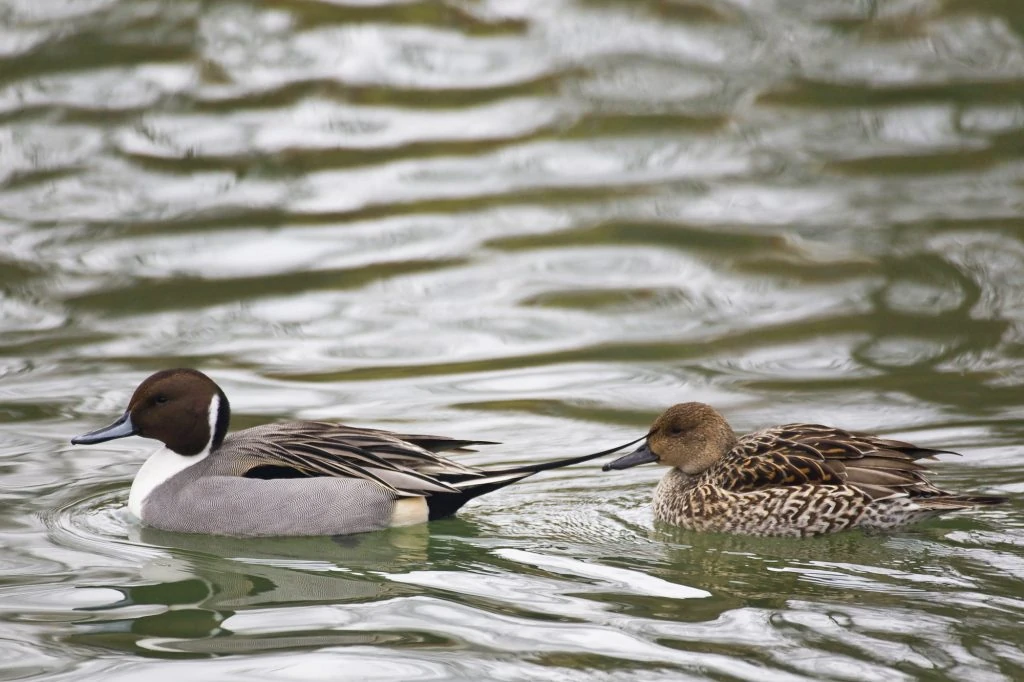
Northern Pintails breed in Canada, Alaska, and the Midwest before migrating to southern and coastal US states.
They occur in 3% of winter checklists.
Northern Pintails are ducks known for their long pointy tails. Males have a beautiful brown head, with a contrasting white vertical stripe down their neck. Their bodies are white, and they have gray, white, and black patterns on their back. When in flight, their wings display a green patch.
Females are brown with intricate scaled patterns on their bodies. They also have a brown patch on their wings.
- Anas acuta
- Length: 20 – 26 in (51 – 66 cm)
- Weight: 36.33 oz (1030 g)
- Wingspan: 29 – 35 in (74 – 89 cm)
You can find Northern Pintails living with other duck species in open wetlands, marshes, prairies, and even in agricultural fields. They forage on the edges of lakes and ponds but are known to dabble in open water with other ducks. During winter, they will migrate to coastal lagoons, sheltered estuaries, and brackish marshes.
Northern Pintails have a distinct advantage over ducks when dabbling for food. With their long necks, they can reach 12 inches deep into the water, much further than other ducks. They feed on seeds and roots of aquatic vegetation. They also eat seeds and grain from agricultural fields. During the breeding season, they eat more animals for protein, like aquatic insects and mollusks such as snails.
Northern Pintail calls:
Male Northern Pintail
Female Northern Pintail
Nests of Northern Pintails are usually found in shallow hollows on the ground, close to a water source. They are made with grasses and feathers and serve as home to at least twelve eggs.
The female incubates them for as many as twenty-five days and will lead the young to the water as soon as they’re hatched so they can feed on insects by themselves. They can fly in about fifty days but will not leave the nest until the female has completed molting.
Fun Fact: Because Northern Pintails are agile and speedy birds, they are often hunted as a challenge in game shooting.
10. Cinnamon Teal
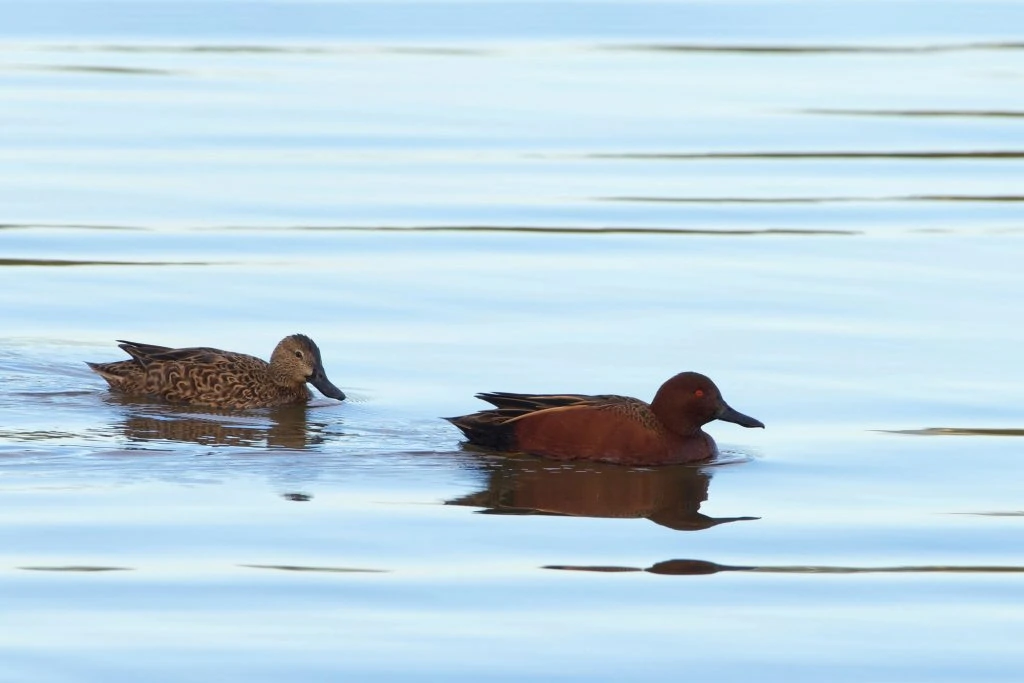
Cinnamon Teals are spotted in the west of the United States. They spend the breeding season in the north and migrate south for winter. They are recorded in 1% of summer and winter checklists.
Cinnamon Teal breeding males are the reason why these birds are named as such. They’re cinnamon-colored all over during the breeding season, and even their eyes are red. On their backs, they have a scaly reddish-brown patch. They have a pale blue shoulder and a white line that separates it from the greenish lower wing.
Males will molt this glossy coloring and will then look similar to the females in winter. Females are brown with a scaly pattern on their chest, belly, and back.
- Spatula cyanoptera
- Length: 14- 17 in (36 – 43 cm)
- Weight: 16.4 oz (465 g)
- Wingspan: 24 – 30 in (61 -76 cm)
You can find Cinnamon Teals in freshwater marshes and ponds. Cinnamon Teals belong to the Dabbling Duck family, so they live on food that they can find by skimming the surface of the water, especially in shallow water. They eat seeds, plants, and aquatic insects. They may opt to dabble just below the surface for submerged plants in deeper waters.
Cinnamon Teal calls:
Male Cinnamon Teal
Female Cinnamon Teal
Nests of Cinnamon Teals are built on the ground, usually sheltered among tall grasses and vegetation but still near the water. The nests are made with grass made even softer with down. There can be up to twelve eggs in a nest, and it takes up to twenty-five days for the eggs to hatch. After about 50 days, the young are able to fly on their own.
Fun Fact: Cinnamon Teals change breeding partners every year.
11. Muscovy Duck
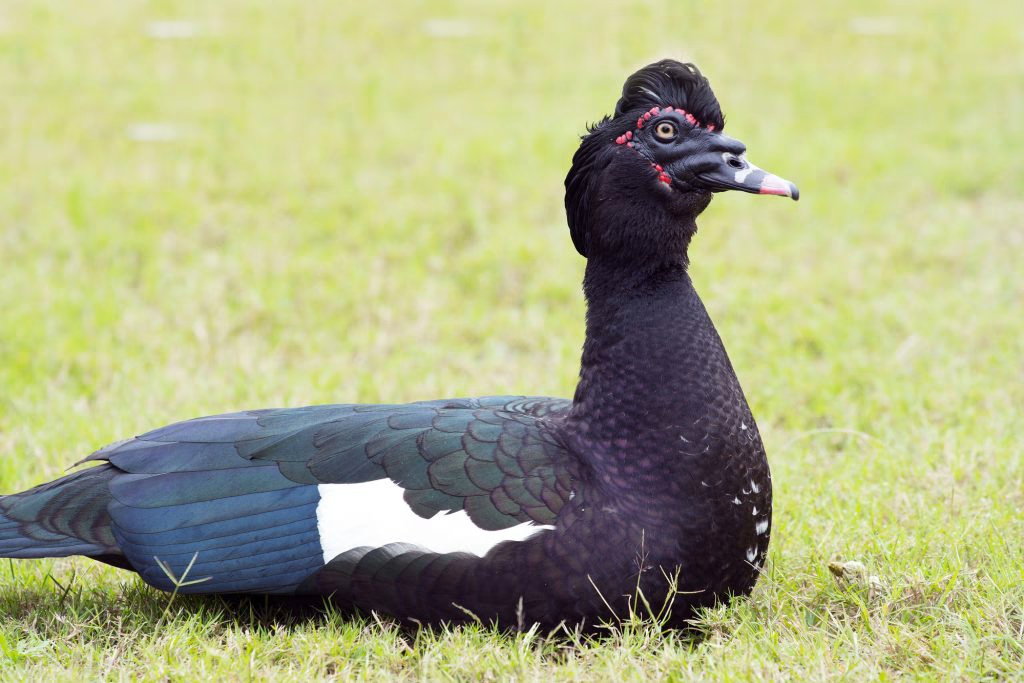
Muscovy Ducks are mainly spotted in the east of the United States, especially in Florida. Although there have been sightings all year, they are mainly spotted from December to February.
There are wild and domesticated Muscovy Ducks. Wild ducks are glossy, dark-colored, and with a less-obvious white wing patch. Males have a short crest on the nape.
Domesticated Muscovy Ducks may show a varied combination of dark brown, white, and black coloring. Both types of Muscovy Ducks have the same red, wart-like spots on their faces.
- Cairina moschata
- Length: 25 – 35 in (64 – 89 cm)
- Weight: 102.4 oz (2902 g)
- Wingspan: 54 – 60 in (137 – 152 cm)
Muscovy Ducks are predominantly from Mexico, Central America, and South America. However, escaped domesticated Muscovy ducks can be found in many areas.
You can find wild Muscovy Ducks in forests with a water source. Domesticated Muscovy Ducks live on farms and parks.
Wild Muscovy Ducks fend for themselves by wading in shallow wetlands for food. Domesticated Muscovy Ducks are comfortable being fed by humans in parks. They like “dipping” for seeds and plants.
Muscovy Duck call:
Nests of Muscovy Ducks can be found in tree hollows. They also like nest boxes. A female lays about ten eggs which she incubates by herself for a little more than a month. After birth, the female takes care of her newborns for an additional ten to twelve weeks.
Fun Fact: Muscovy Ducks have been domesticated for a long time because their meat has a stronger taste than other ducks.
12. Eurasian Wigeon
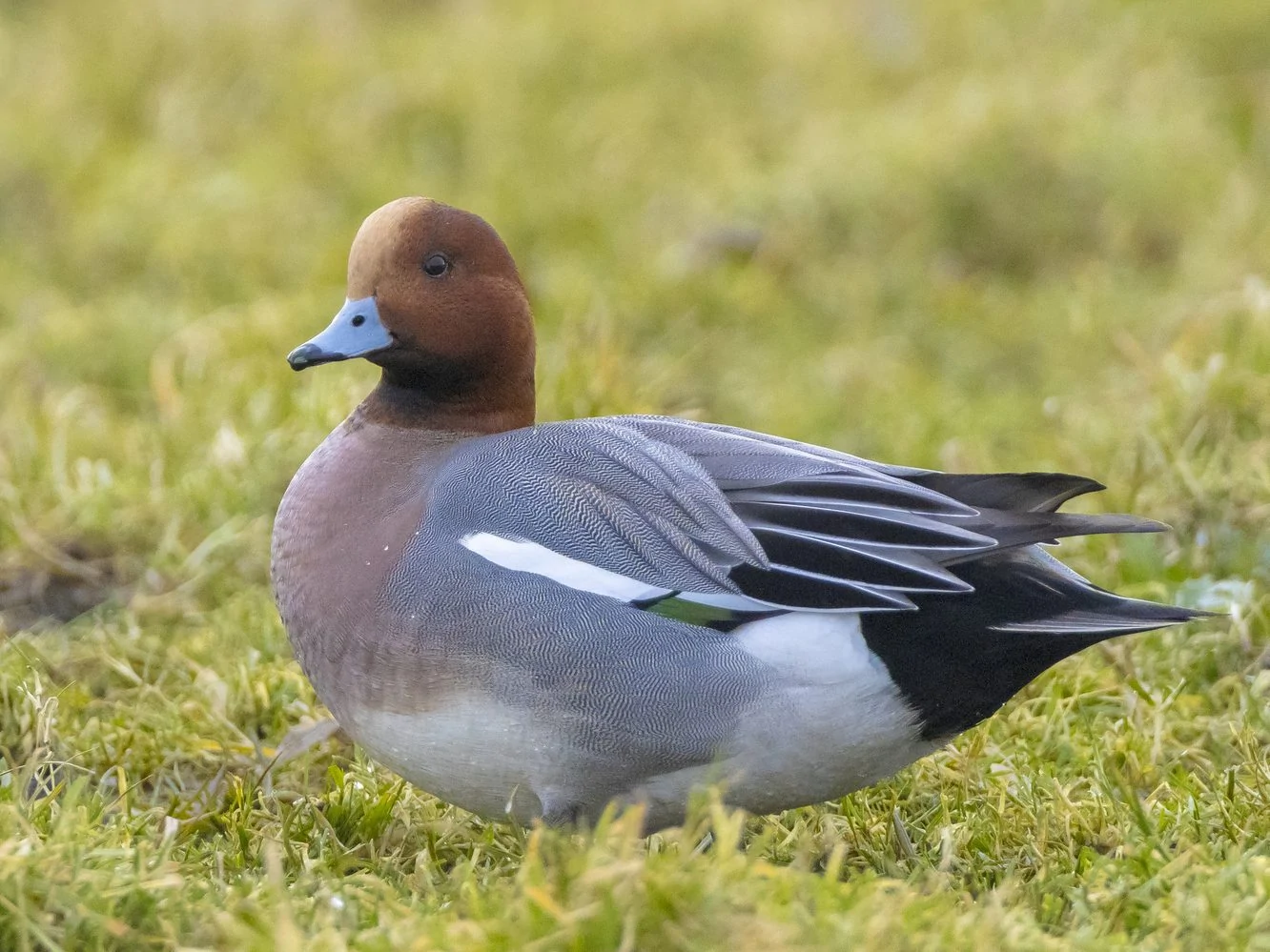
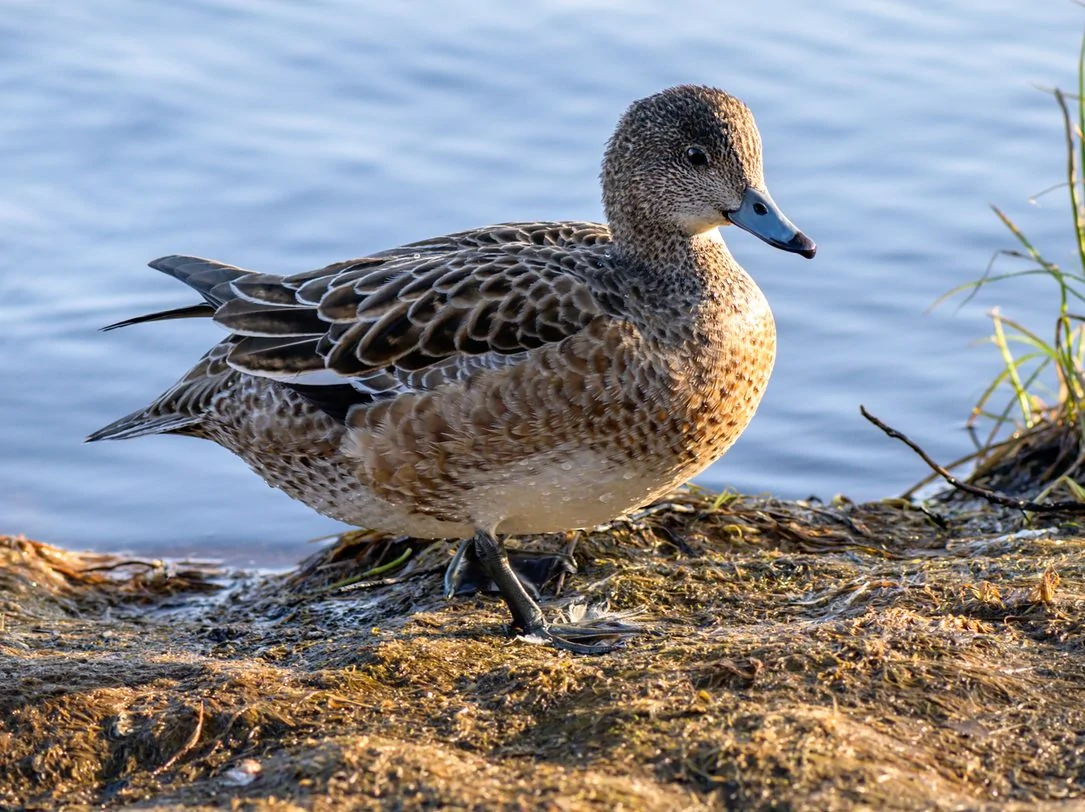
Eurasian Wigeons are mainly spotted in the United States from November to March, but some also hang around all year.
Eurasian Wigeons stand out among dabbling ducks because of the bright, creamy patch on their heads that contrasts with their cinnamon-red head and blue-gray bill. Their backs are gray as well as their sides. They have pinkish breasts, and their wings have white shoulder patches with a green layer at the bottom. Females are mostly brown, with scaly patterns all over and white bellies.
- Mareca penelope
- Length: 18 – 20 in (46 – 51 cm)
- Weight: 35.27 oz (1000 g)
- Wingspan: 30 – 32 in (76 – 81 cm)
Eurasian Wigeons can sometimes be spotted during winter in the US in a few areas.
You can find Eurasian Wigeons on wet grasslands, tidal flats, marshes, ponds, and lakes. Eurasian Wigeons usually join other dabbling ducks when they forage for food. They eat aquatic vegetation that is either submerged or just below the surface of the water.
Eurasian Wigeons also like to relax on land, and they are known to snatch food from other ducks as they surface from feeding.
Eurasian Wigeon calls:
Nests of Eurasian Wigeons are usually in shallow holes in the ground, protected by tall grasses and weeds. Females create the nests using grass and feathers and are often near the water. Females lay from seven to nine eggs. They incubate them for about twenty-five days, and then it takes around two months before the young can fly.
Fun Fact: The “Penelope” in the Eurasian Wigeon’s scientific name comes from Greek Mythology, after Odysseus’ wife, who was rescued by a duck when she was thrown into the ocean.
13. Mexican Duck
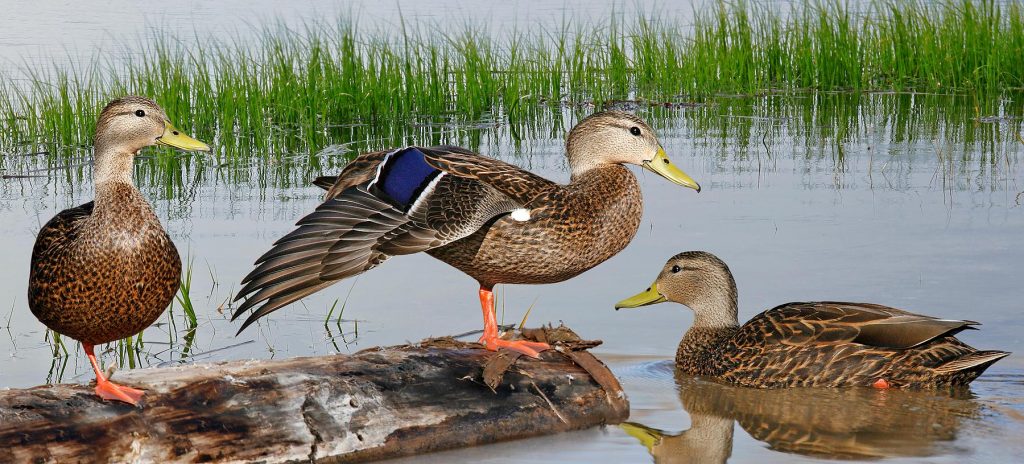
Nests of Mexican Ducks are normally found on the ground or riverbanks, hidden among tall grasses. The nests are made of grasses and lined with feathers. Females lay between four to nine eggs at a time and will wait for about twenty-six days for them to hatch.
Fun Fact: Mexican Ducks used to be on the Endangered Species List in the late 1960s but were removed in 1978. Today, they are in danger again because of the destruction of their habitat and over-hunting.
14. Mandarin Duck
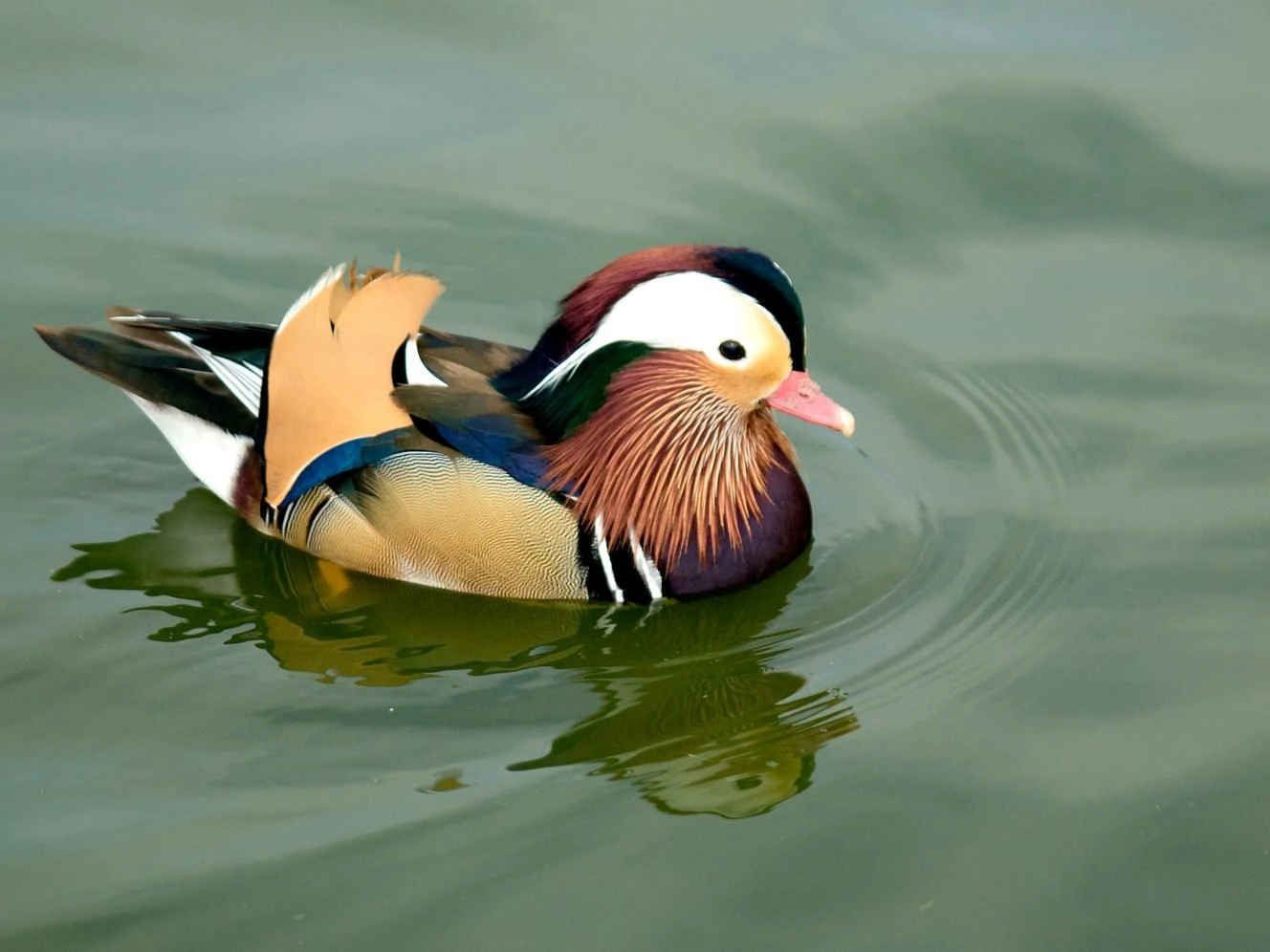
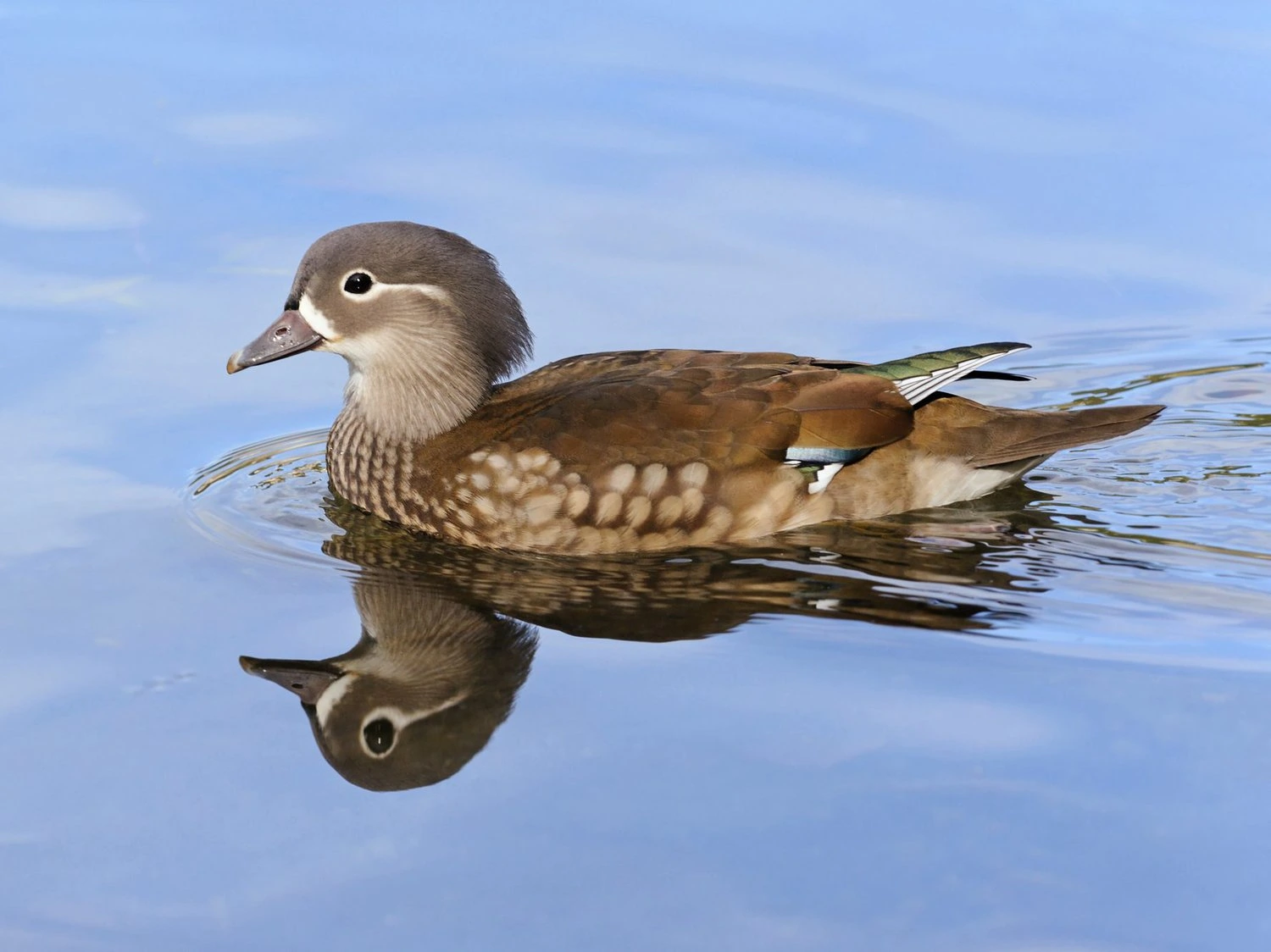
Mandarin Ducks are non-native species in the United States, and although they are not very common, there have been sightings here all year.
Male Mandarin Ducks are striking and extremely colorful and may be the reason why they’re often bred in captivity. They are a patchwork of color and have a long crest and throat feathers and orange ‘sail’ feathers that stick up at the rear.
During molting, the males resemble the females, but their bill is red, they don’t have a crest, and they have a less visible eye stripe.
Female Mandarin Ducks are pretty subdued compared to the males. Their heads are brownish-gray, with blue bills. Their bodies are mainly brown.
- Aix galericulata
- Length:16 – 19 in (41 – 49 cm)
- Weight: 15 – 24 oz (430 – 690 g)
- Wingspan: 26 – 30 in (65 – 75 cm)
Mandarin Ducks are originally from East Asia but have found their way to the United States after escaping captivity and then reproducing in the wild.
You can find Mandarin Ducks in dense woodland and forest edges near water when in their native habitat. In other areas, they are seen in marshes, coastal lagoons, lake edges, water meadows, and cultivated, wooded areas.
You may also spot them perched in trees, as they are one of the rare ducks that do.
Mandarin Ducks are omnivorous, which means they eat both plants and animals, and this changes depending on the season. In winter, they may have a limited diet of acorns and grains. In spring, they eat insects, snails, fish, and aquatic plants, and summer brings more choices like small fish, frogs, mollusks, and snakes.
Mandarin Duck calls:
Male Mandarin Duck
Female Mandarin Duck
Nests of Mandarin Ducks are found in cavities in trees that are close to water sources. They often use abandoned woodpecker nests but have been known to use nest boxes as well. The female lays between seven to fourteen eggs which she incubates for up to thirty days. The male guards the female and the nest but nothing more than that.
Fun Fact: In China, Mandarin Ducks are regarded as signs of fidelity and so are given as gifts at weddings. However, they are not monogamous and form new pairs each year!
15. Garganey
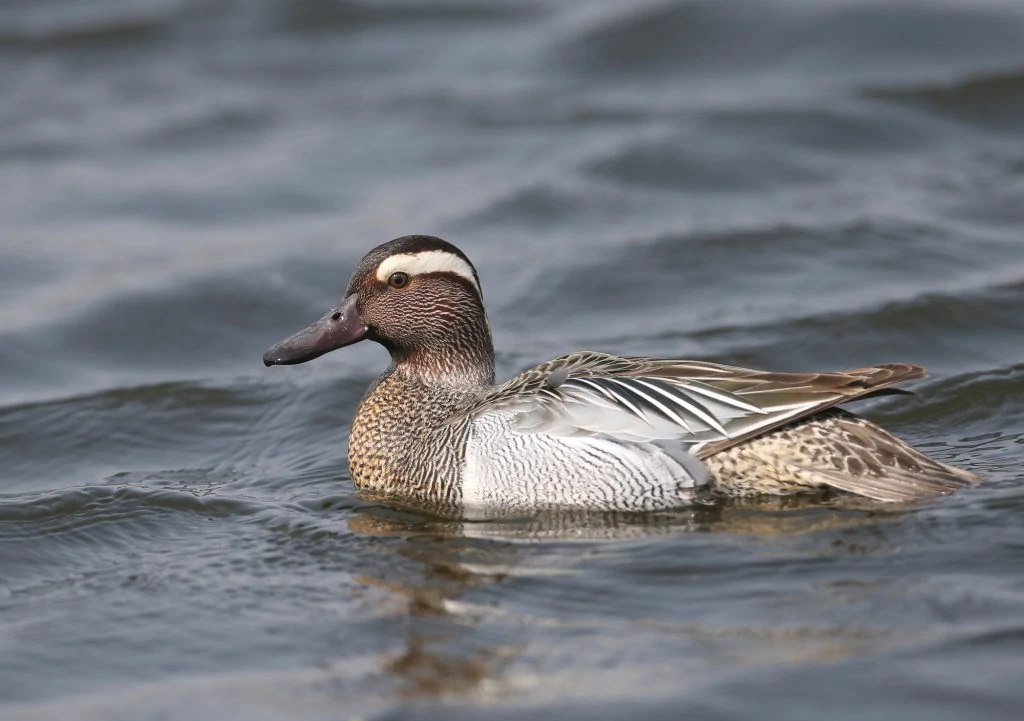
Garganeys are not very common in the United States, but they are recognized as regularly occurring and have occasional sightings in the country all year.
Garganeys are small dabbling ducks. The males are interestingly multi-patterned. The top of their head has a black line running to their neck, while a striking white line above the top of their eye weaves its way down to their back.
Their face and throat are brown and uniquely lined. Their back is striped gray, black, and white. Their belly is grayish-white. When in flight, a green or blue line with white borders appears on their wings.
Female Garganeys have different feather patterns. They have no vertical stripe from the eye. They are mostly dark brown all over, with a scaly pattern on their back, chest, and belly.
- Spatula querquedula
- Length: 14 – 16 in (36 – 41 cm)
- Weight: 18.34 oz (520 g)
- Wingspan: 23 – 25 in (58 – 64 cm)
Garganeys usually breed in Eurasia and winter in Africa and southern Asia, but some wander into Alaska.
You can find Garganeys around shallow freshwater lakes, reedy wetlands, and marshes with abundant vegetation on the edges.
Garganeys mostly feed on aquatic plants and insects. With their spatula-like bill, they are able to filter the water that passes through their bill to get at their food.
Garganey call:
Male Garganey
Female Garganey
Nests of Garganeys are often found on the ground close to shallow ponds and lakes filled with floating plant vegetation. Their nests are made with grass and plants that are hidden behind tall shrubs. There are about seven eggs per nest that the female incubates by herself. It takes twenty-four days for the eggs to hatch.
16. Falcated Duck
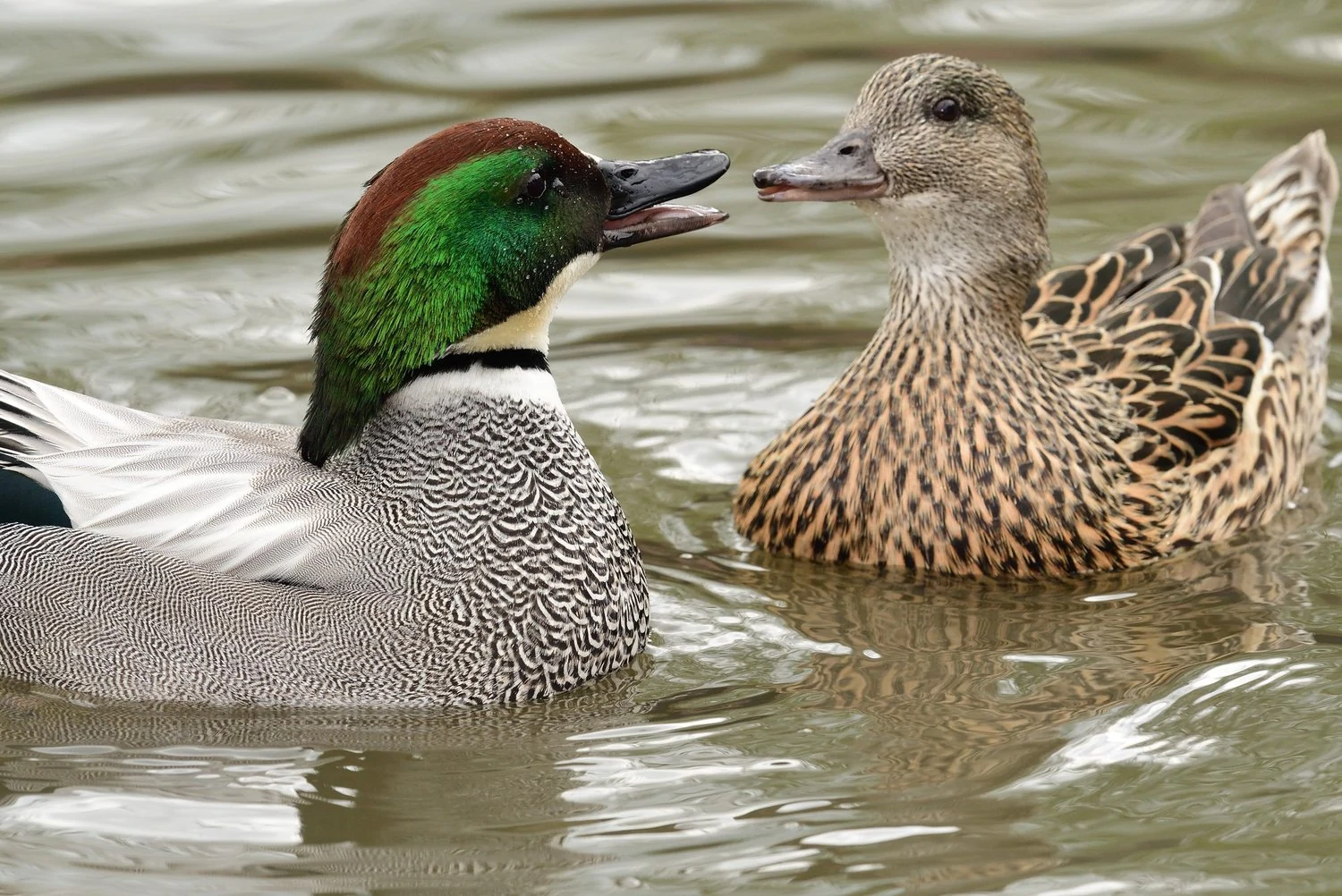
Falcated Ducks are considered near-threatened and rare species in the United States. They have only been spotted around California, Ohio, Oregon, Maryland, Texas, and Washington.
Male Falcated Ducks are instantly recognizable because of their glossy, red-brown, and green heads. Their throats are white with a distinct black “necklace” around them. Their bodies are mostly gray, with distinct black and white patterns.
On their breasts, they have scaled patterns. On their flanks and bellies, they have finer, scalloped patterns. They also have sickle-shaped feathers (hence their name, “Falcated”) that extend over their black rumps.
Females are mostly brown with scaled patterns all over. They have light brown heads with no sheen and no visible pattern. Their bellies are lighter in color than their heads. Juveniles resemble females but are paler brown.
- Mareca falcata
- Length: 19 – 21.5 in (48 – 55 cm)
- Weight: 25.6 oz (726 g)
- Wingspan: 31 – 36 in (79 – 91 cm)
Falcated Ducks are usually found in Eurasia, but they also wander into North America.
You can find Falcated Ducks among marshes and wetlands, water meadows, and lakes. Their species is considered “near threatened” on the IUCN’s Animal Red List due to hunting and habitat loss.
Falcated Ducks are versatile ducks when it comes to food. They will graze on land, foraging for grasses and other plants. They will dabble, tip, upend or dive to forage for food in the water. They usually eat aquatic plants, snails, insects, small fish, and even frogs.
Falcated Duck Call:
Male Falcated Duck
Female Falcated Duck
Nests of Falcated Ducks are found on the ground near water. Females build their nests out of grasses and plant material and are lined with down. Most of the time, they’re concealed in thick grasses, swamped shrubs, or in deadwood. The female lays six to ten eggs that take about twenty-six days to hatch.
Fun Fact: The Falcated Duck was once called the Falcated Teal.
17. White-cheeked Pintail
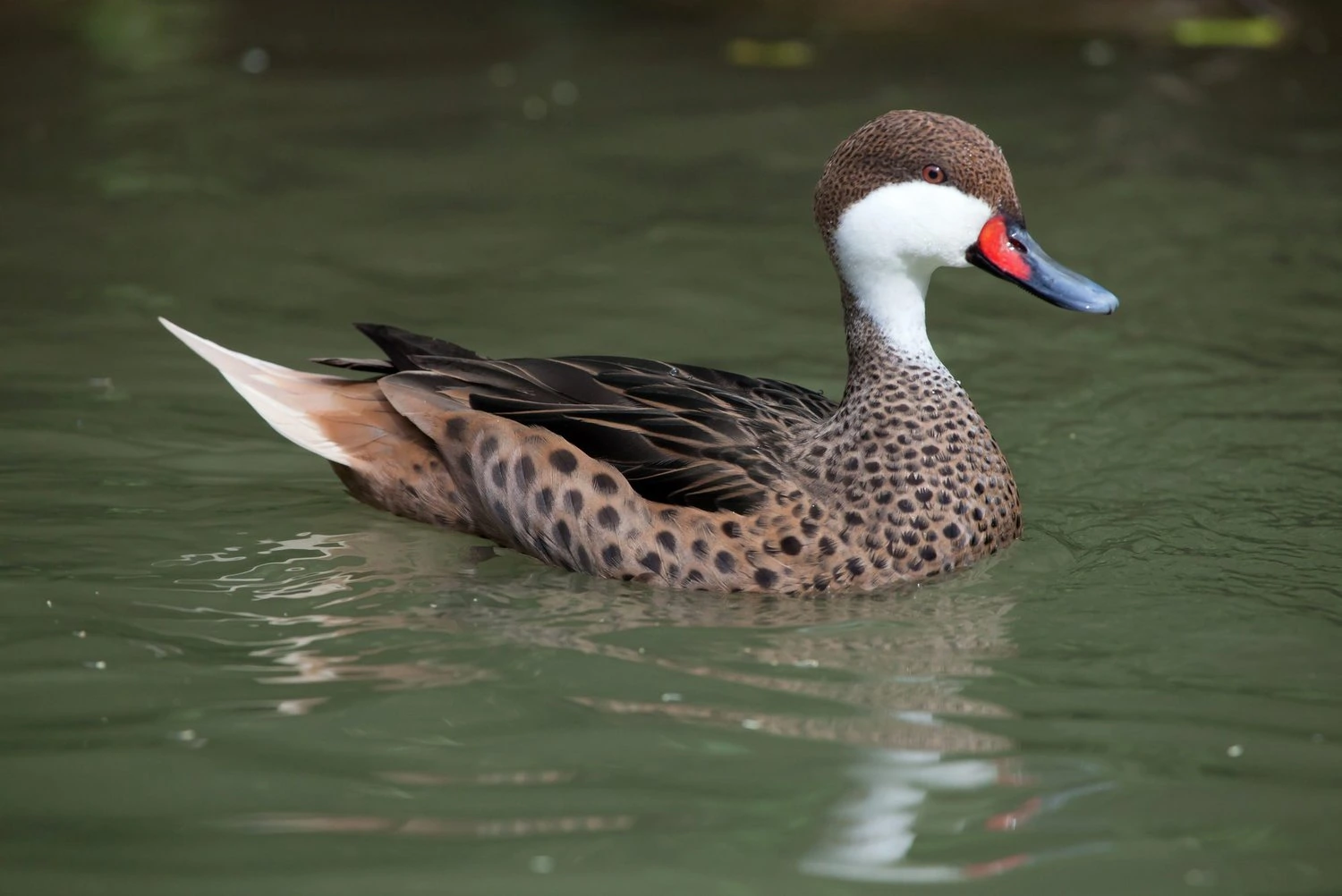
White-cheeked Pintails are considered rare or accidental species in the United States, but you might spot some in the east of the country.
The White-cheeked Pintail is a dabbling duck that also goes by the name Bahama Pintail or summer duck.
White-cheeked Pintails are beautiful ducks. Both sexes look the same. They both have brown, streaked foreheads and napes. They have a white patch on their cheek extending to their throat. Their bills are blue with a distinct red spot at the base. The rest of their bodies are covered with black and brown spots.
- Anas Bahamensis
- Length: 18 – 20 in (46 – 51 cm)
- Weight: 19.2 oz (544 g)
- Wingspan: 26 – 31 in (66 – 79 cm)
White-cheeked Pintails are usually found in the Caribbean and South America, but they also are found in southeastern US states.
You can find White-cheeked Pintails in saltwater habitats, like lagoons, rocky or sandy seashores, and mangroves. They may also be found near rivers, lakes, and ponds. On rare occasions, they may be found in brackish water and shallow marshes.
White-cheeked Pintails dabble in water for food. They usually eat seeds, algae, aquatic plants, particularly widgeon plants, and small invertebrates.
White-cheeked Pintail Call:
Nests of White-cheeked pintails are made of leaves and hidden among tall grasses and weeds and located near the water. When the eggs hatch, the young are led by the female to a safe water environment.
18. Baikal Teal
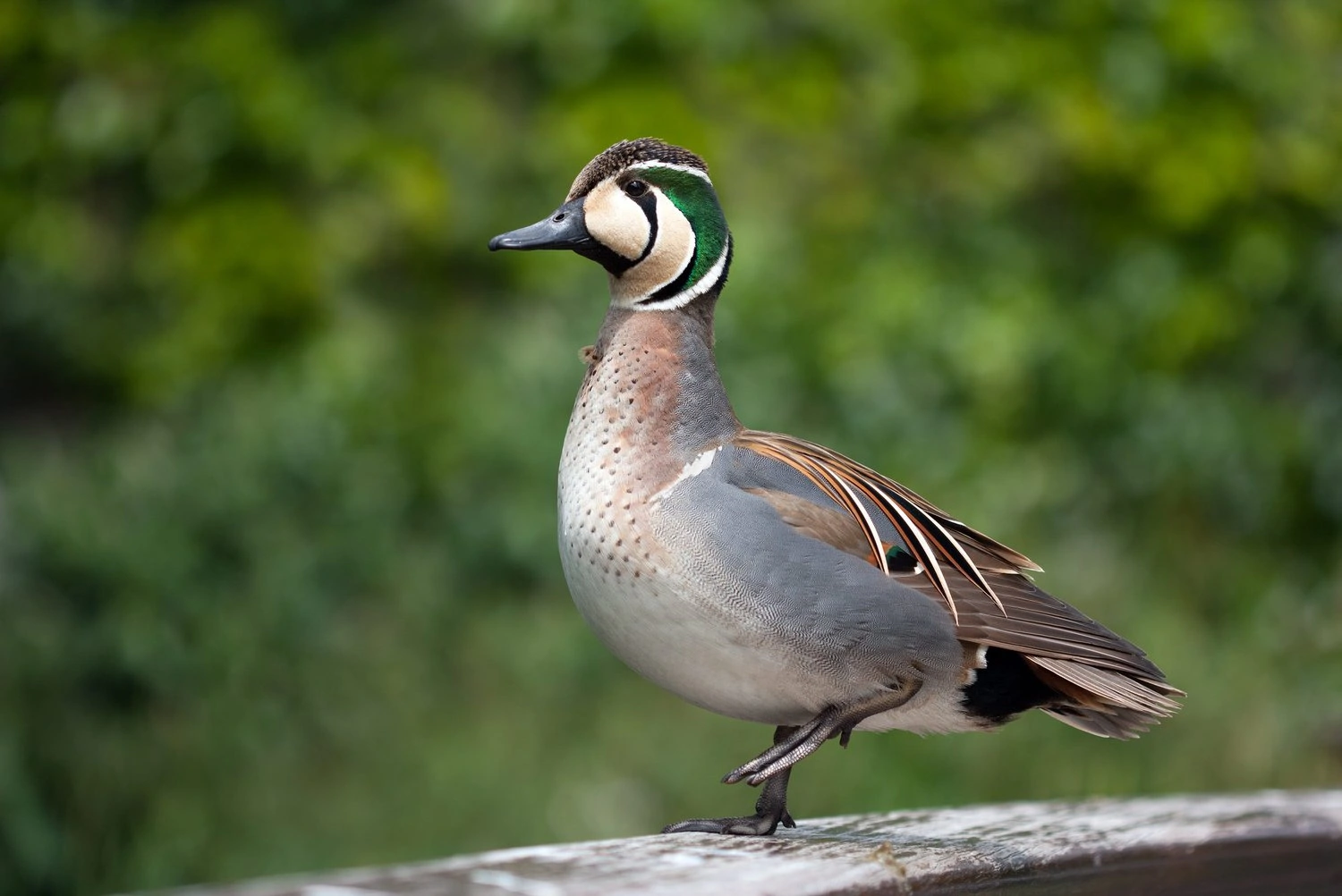
Baikal Teals are extremely rare in the United States and are considered accidental species in the country. However, there were recent sightings in Alaska in 2022.
Baikal Teals are also called bimaculate ducks or squawk ducks. Male Baikal Teals are uniquely patterned ducks which makes it easy to recognize them. They have white, green, pale brown, and black-colored heads with a striking pattern.
Their breasts are spotted in a pinkish-brown color. Their sides are gray and outlined with vertical white stripes. Their backs are dark brown with a scallop pattern, and they have long, pointed feathers that cover their wings.
Females and juveniles share the same coloring – dark brown on the top half and light brown on the lower half of their bodies. Their breasts and flanks have a spotted pattern, while their back is more scalloped. Females have a distinct white spot at the base of their bills.
- Anas formosa
- Length: 15 – 17 in (38-43 cm)
- Weight: 15.4 oz (436 g)
- Wingspan: 20 – 25 in (51 – 64 cm)
Baikal Teals usually breed in eastern Siberia and winter in Asia, but they wander into the United States and Canada.
You can find Baikal Teals near swampy, tundra areas during the breeding season. They spend winter in freshwater areas like lakes, rivers, and reservoirs. They also favor farmlands where they feed at night.
Baikal Teals are dabbling ducks, so they feed on underwater plants and invertebrates simply by tipping their bodies into the water. They would normally eat aquatic plant seeds, snails, and algae. When on agricultural fields, they consume grains and seeds.
Baikal Teal Call:
Nests of Baikal Teals are often found on the ground, either near the base of a tree or a shrub or near the water. The nests are made out of dried plants and lined with feathers. The female lays six to ten eggs which take twenty-one to twenty-five days to hatch.
Fun Fact: Baikal Teals used to be classified as “Vulnerable” due to hunting before 2011, but their numbers are now recovering.
Diving Ducks (11 Species)
Diving ducks are so called as they dive to the bottom of deeper water in search of food in freshwater, tidal lagoons, and estuaries. They are members of the Aythyini subfamily and are different from the sea diving ducks that are members of the Merginae subfamily.
Diving ducks’ legs are placed further back to help them swim and dive and so they do not usually walk on land as dabbling ducks do. They eat fish, aquatic plants, and shellfish.
19. Bufflehead
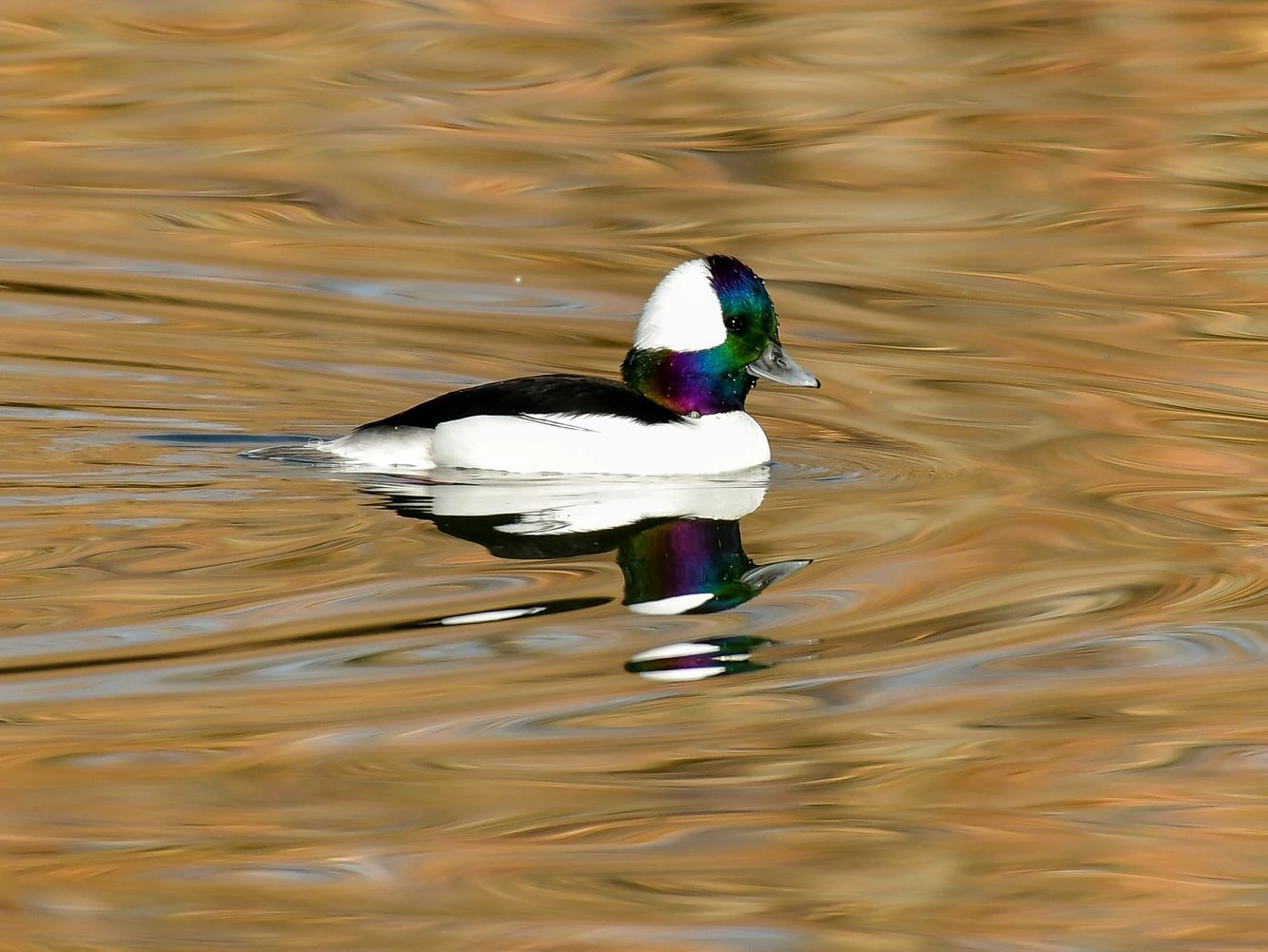
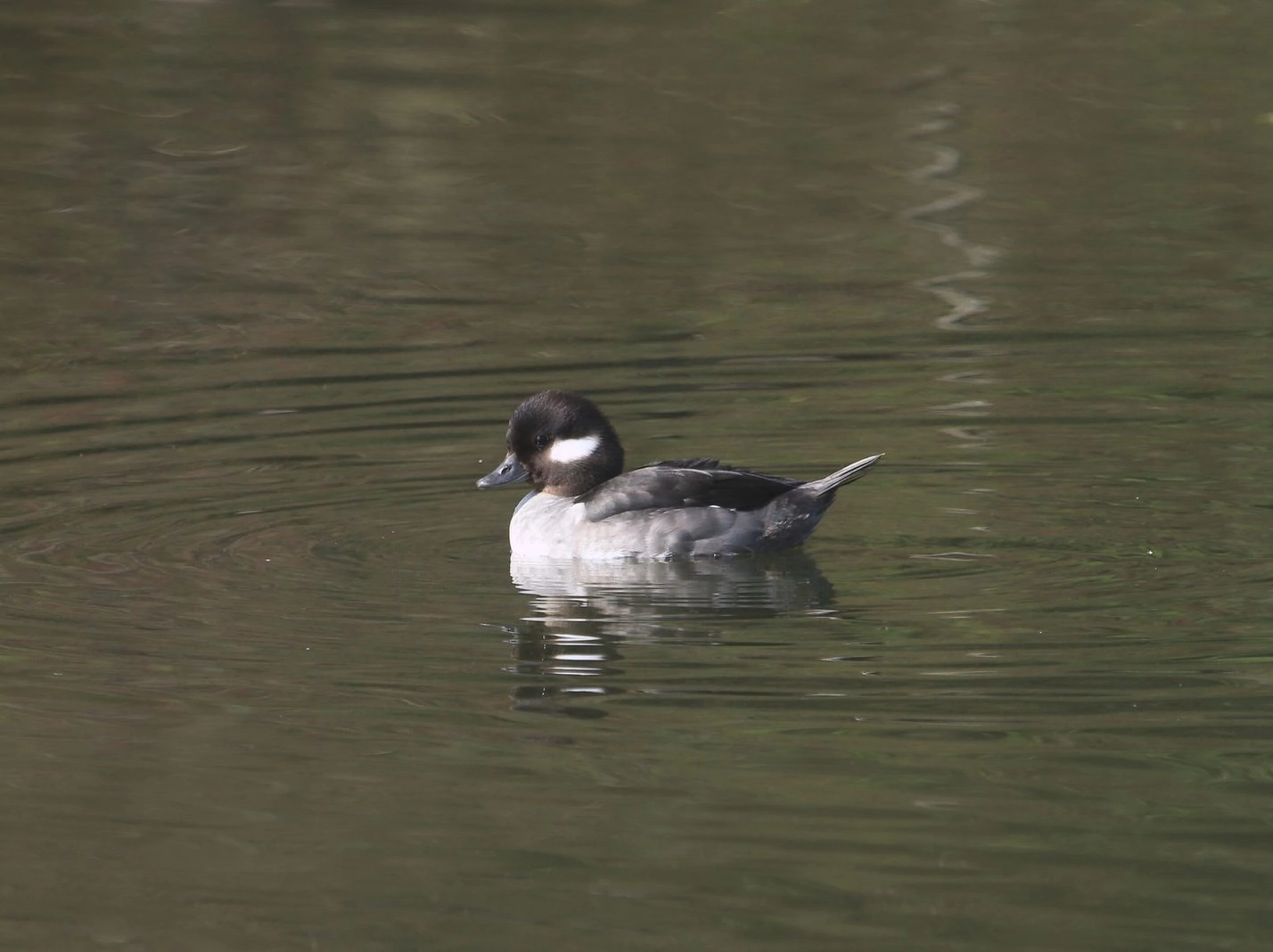
Buffleheads breed mainly in Canada before migrating to the US, northern Mexico, and Canada’s Pacific coast. They can be seen during migration in the Midwest and the Appellations.
Buffleheads are very common in the United States and are mainly spotted from October to May, but some are also spotted all year. They are recorded in 10% of winter checklists.
Buffleheads are small birds with bulbous heads, hence their name, “bullheaded,” from ancient Greek. Male Buffleheads are easily recognizable because of the huge white patch behind their eyes. This patch highlights the glossy green and purple colors on the crown, forehead, throat, and neck. The bottom half of their bodies are white, while the upper half is black.
Female Buffleheads look nothing like the males, except for the bulbous head. They have dark brown or black heads with a white patch below the eye. Their bottom half is gray, and their top half is black. Juveniles look similar to females with their brown heads and a white patch on the head.
- Bucephala albeola
- Length: 13 – 16 in (33 – 41 cm)
- Weight: 21.16 oz (600 g)
- Wingspan: 20 – 24 in (51-61 cm)
You can find Buffleheads in small lakes and ponds with nearby poplar and aspen forests during the breeding season. In the winter, they move to protected coastal waters or shallow bays and inlets.
Buffleheads mostly dive as they forage for food. They catch mollusks, crustaceans, and aquatic insects, which they eat while underwater.
Bufflehead Calls: Buffleheads are quiet birds and don’t make particularly loud calls. Males usually only make sounds around the breeding season and make chattering sounds or squeals. Females call to their young.
Male Bufflehead call
Female Bufflehead call
Nests of Buffleheads are often found in tree cavities, particularly those previously used by Northern Flicker woodpeckers. These are very small tree holes that are close to water. The female places several down feathers on the nest just enough to cover the eggs. She lays from six to eleven eggs that she incubates for thirty days.
Attract Buffleheads to your backyard by putting up nest boxes. There is a lot of nest competition with other goldeneyes, which drives Buffleheads to seek safer and better nesting areas.
Fun Fact: Buffleheads are monogamous ducks and may remain with their chosen mate for several years.
20. Ring-necked Duck
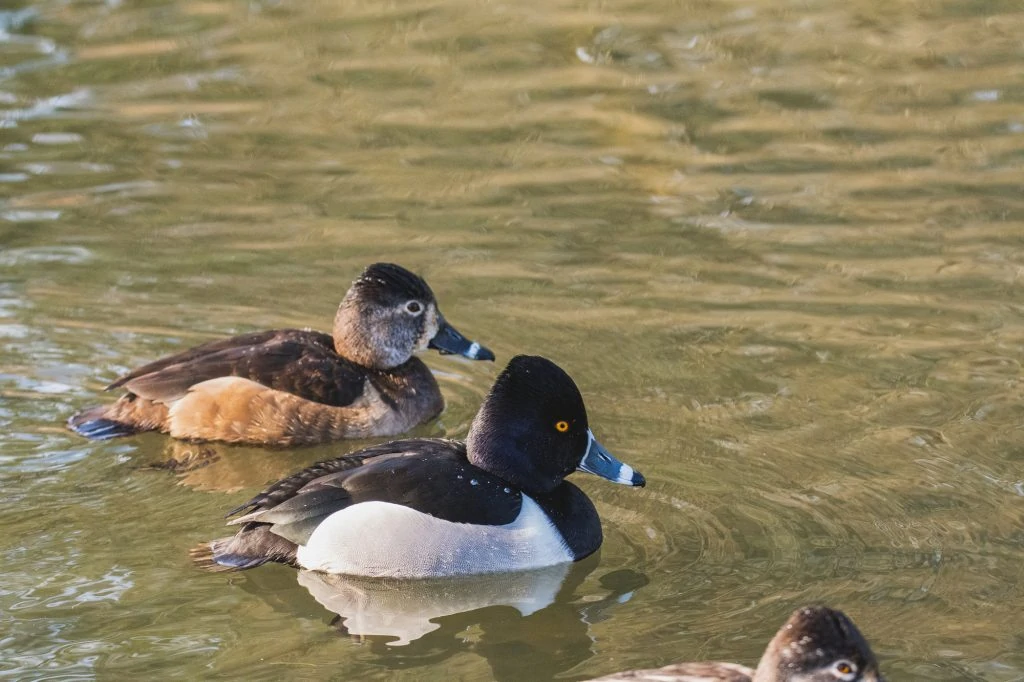
Ring-necked Ducks breed in Canada and northeastern US states before migrating to southern and western US states, Mexico, northern Central America, and the Caribbean.
Ring-necked Ducks are very common in the United States, and although they are spotted all year, their numbers increase in winter from October to May.
They appear in 1% of summer checklists and 6% of winter checklists.
Ring-necked Ducks are medium-sized ducks that have a steep black forehead, a gray bill fringed with white and a black tip, a black chest and back, and a white breast and belly. They have a cinnamon collar around their neck.
Females don’t show the ring and are mostly brown everywhere except for their gray faces and white outline around their eyes. Their bills also don’t have the white outline the males have, but they do have a white band near the black tip of their bill.
- Aythya collaris
- Length: 14 – 18 in (36 – 46 cm)
- Weight : 32.09 oz (909 g)
- Wingspan: 24 – 30 in (61 – 76 cm)
You can find Ring-necked Ducks in small, shallow ponds and rivers. Breeding habitats may include wooded lakes in forests.
You can find Ring-necked Ducks foraging on the surface and only occasionally diving below the water in small, shallow ponds and rivers. Even though they are diving ducks, they behave more like dabbling ducks.
They eat plants on the surface of the water and submerged plants like pondweed. They also eat wild rice and animals such as earthworms, leeches, and snails.
Ring-necked Duck Calls: A series of barking grunts
Nests of Ring-necked Ducks are bowl-shaped and built on shallow water with a lot of vegetation for cover. They are made with plant materials and can hold as many as ten eggs. The females incubate these eggs for about a month and stay with the young until they’re ready to fly.
Fun Fact: Though you may think that the ring around the Ring-necked Duck is used to easily distinguish them from other birds, you’d be mistaken. It’s hardly noticeable. Better to look for their steep, black forehead and blue-gray bill with the white band.
21. Ruddy Duck
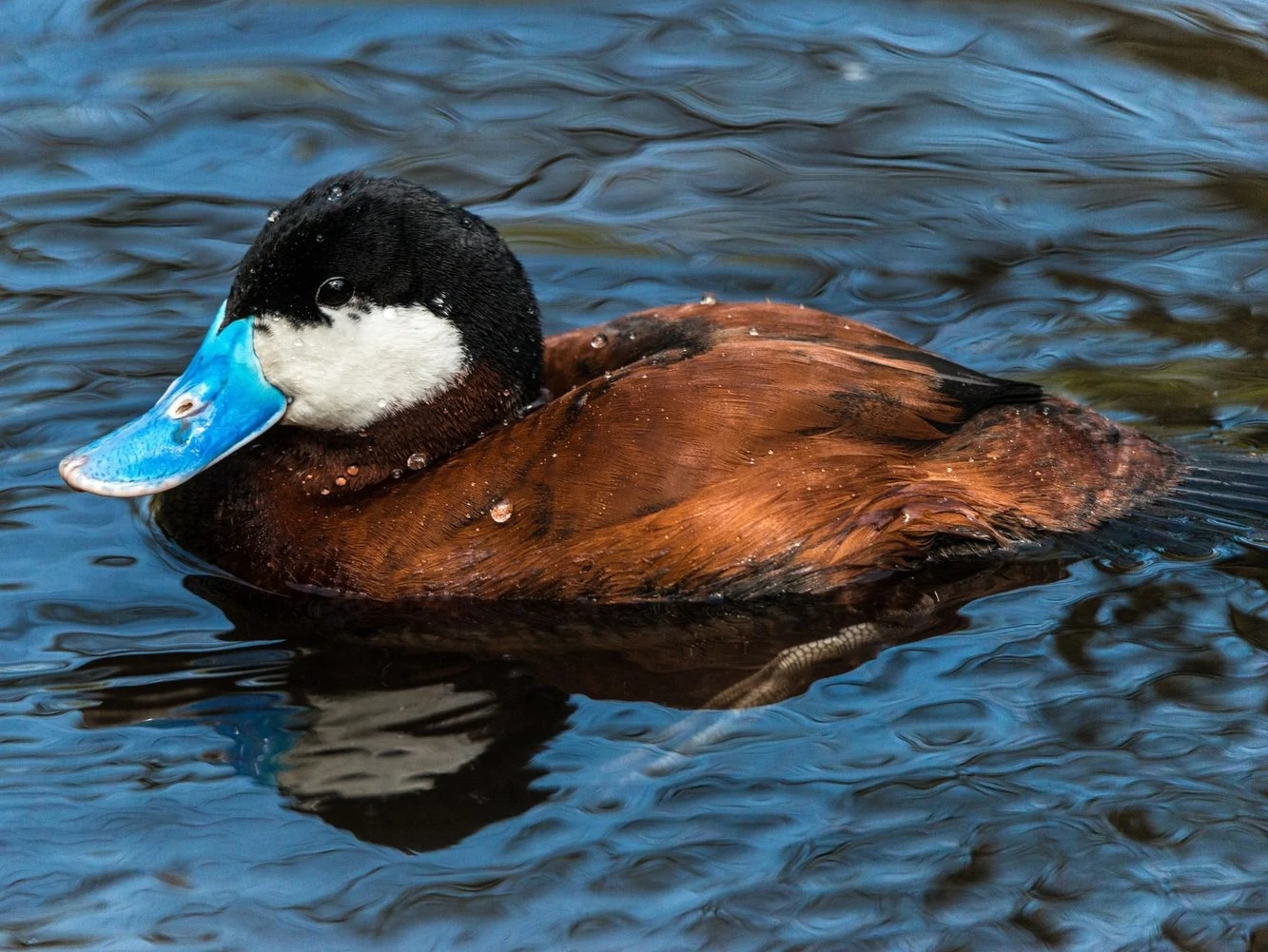
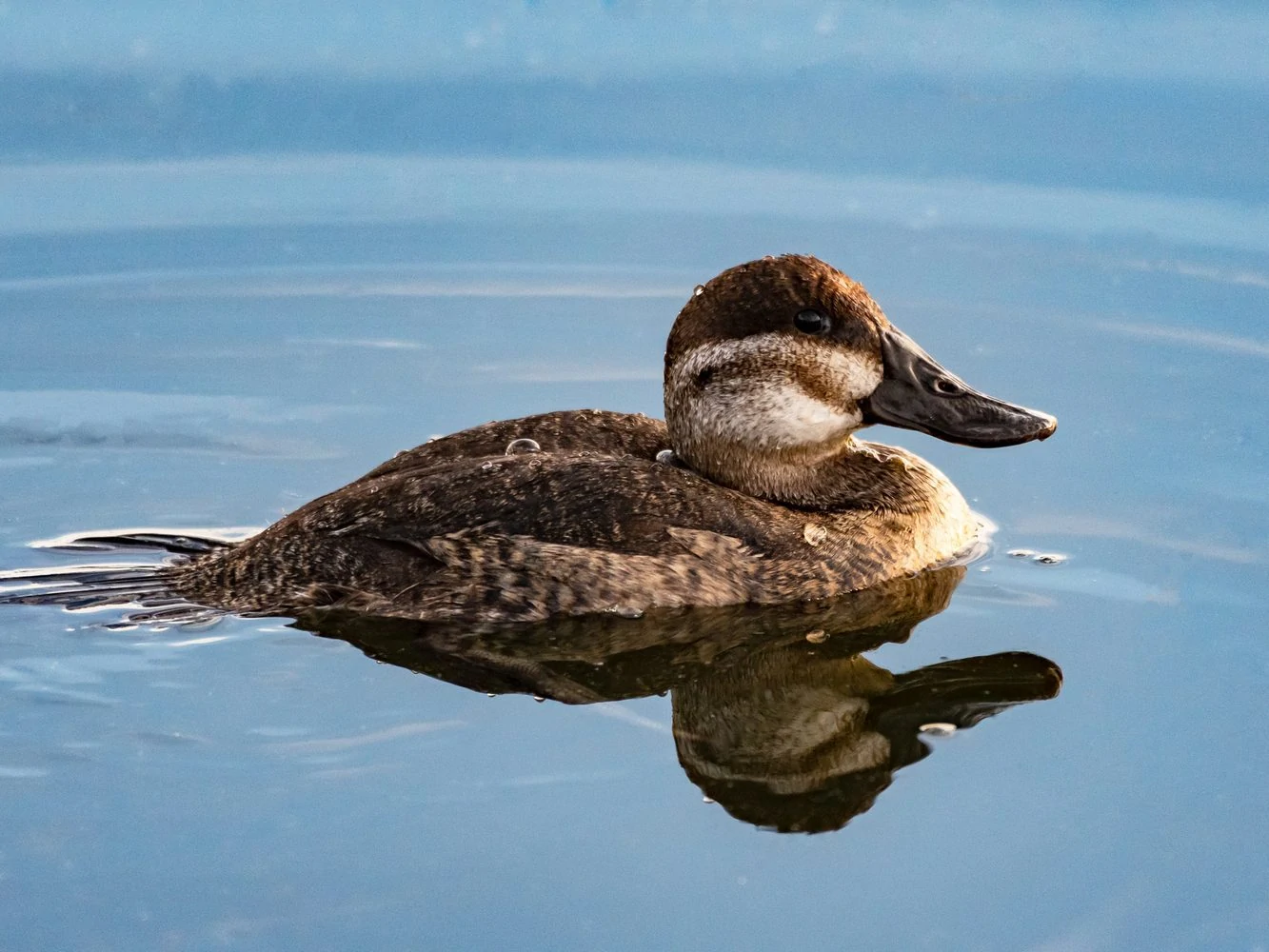
Ruddy Ducks breed in western US states and western Canada before migrating to southern US states and the east and west coasts of the US and also Mexico.
Ruddy Ducks are most common in winter from mid-October to January. They are recorded in 1% of summer checklists and 5% of winter checklists.
Male Ruddy Ducks certainly live up to their name. During the breeding season, Male Ruddy Ducks are bright reddish-brown compared to their dull, grayish coloring when non-breeding. They have black caps on their heads that extend down the back of their necks, large white cheek patches, and bright blue bills.
Females have dark brown caps and similar but grayish cheek patches. They also have a slightly faint brown, horizontal line across their cheeks. Their bodies are also grayish-brown like the non-breeding males.
However, non-breeding males have the same distinct pattern and coloring as breeding males with respect to their heads.
- Oxyura jamaicensis
- Length: 14 – 16 in (35.56 – 40.64 cm)
- Weight: 28.04 oz (795 g)
- Wingspan: 21 – 24 in (53 – 61 cm)
You can find Ruddy Ducks in freshwater marshes, lakes, and ponds with marshy borders and portions of open water during the breeding season. In winter, Ruddy Ducks prefer shallow, saltwater coastal bays and estuaries. If there are any ice-free lakes and ponds, Ruddy Ducks will most likely stay there as well.
Ruddy Ducks are divers and spend their time diving and swimming underwater for food. They feed on aquatic vegetation, like the seeds and roots of aquatic plants, and may also eat aquatic insects, shellfish, and crustaceans. They also skim the water surface and strain mud and water through their bills to eat, so they may eat small fish and mollusks too.
Ruddy Duck Call: Ruddy Ducks are relatively quiet, but during courtship, the males make display calls, and some sound like water bubbles. Females make a series of nasal grunts to call her young.
Male Ruddy Duck
Female Ruddy Duck
Nests of Ruddy Ducks are built by females to float on the water but remain hidden in dense marsh vegetation. Nests are made of grasses and cattails and lined with down. The female then anchors the floating nests to vegetation on the water.
Females lay five to fifteen eggs, some of them in other females’ nests. She incubates these for around twenty-five days. After hatching, the young head into the water where they can swim and dive immediately. Females look after them, but they essentially feed themselves. They can fly after around fifty days.
Fun Fact: In Europe, Ruddy Ducks are included in the list of Invasive Alien Species of Union Concern since 2016. This means that the species cannot be imported, bred, transported, commercialized, or intentionally released into the environment in the whole of the European Union.
22. Lesser Scaup
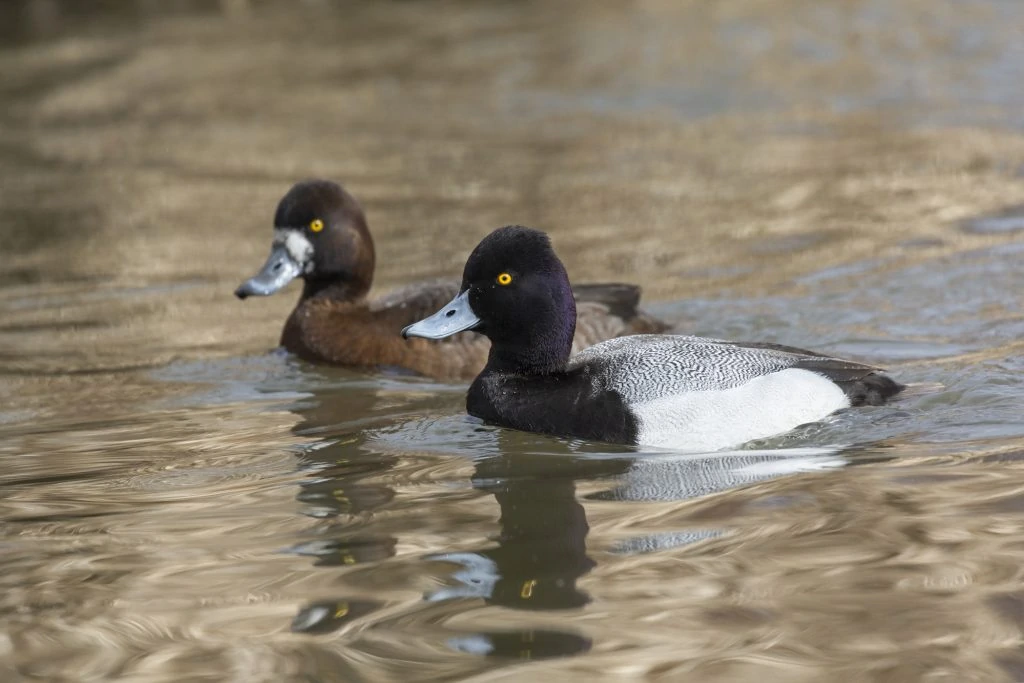
Lesser Scaups breed in northwestern US states, western Canada, and Alaska before migrating to southern US states, Mexico, and the east and west US coasts. They can be seen during migration across the rest of the US.
Lesser Scaups are mainly spotted in the United States from October to May and occur in 4% of winter checklists.
Lesser Scaups are medium-sized diving birds that are pretty similar and often mistaken for Greater Scaups. What makes them different is that Lesser Scaups have a small group of hairs at the tip of their heads. It makes their head look steeper than Greater Scaups.
Their heads, chests, and bottoms are all black with a purple sheen. Their eyes are golden yellow. Their sides are white, and their backs are grayish with an intricate pattern.
Females have dark-brown heads, a white patch on their face next to their bills, gray sides, and are brown all over, and no extra tuft of hair on the head like the males.
- Aythya affinis
- Length: 15 – 18 in (38 – 49 cm)
- Weight: 40.77 oz (1155 g)
- Wingspan: 24 – 33 in (61 – 84 cm)
You can find Lesser Scaups in large lakes, rivers, ponds, and reservoirs. They usually flock together by the thousands during winter, and they often look like floating vegetation when viewed from afar.
Lesser Scaups feed primarily on mollusks and clams that they find after diving into the water and sifting through the bottom. They also dabble in the water for plant vegetation like bulrushes, wild celery, wild rice, and pondweeds.
Recently, they have begun to feed on zebra mussels in Lake Erie, which may endanger their health because these animals are filter feeders and contain environmental contaminants.
Lesser Scaup calls: Male Lesser Scaups are quiet and only make soft gurgle calls. However, females are much louder and make harsh grunts.
Male Lesser Scaup
Female Lesser Scaup
Nests of Lesser Scaups are usually found on the ground very close to the water. Females may share their nests with others, so one nest may contain eggs from more than one female. The nests themselves are scraped and lined with plants and feathers.
One female may lay up to eleven eggs, but the nest may contain up to twenty-six eggs, including those from other females. Incubation lasts only three weeks, and the young immediately head to the water after hatching.
The young are cared for by the females, but they can feed themselves. In about fifty days, they are able to fly and migrate with the others.
Fun Fact: An adult Lesser Scaup may pretend to be dead when in the jaws of a predator like the Red Fox.
23. Redhead
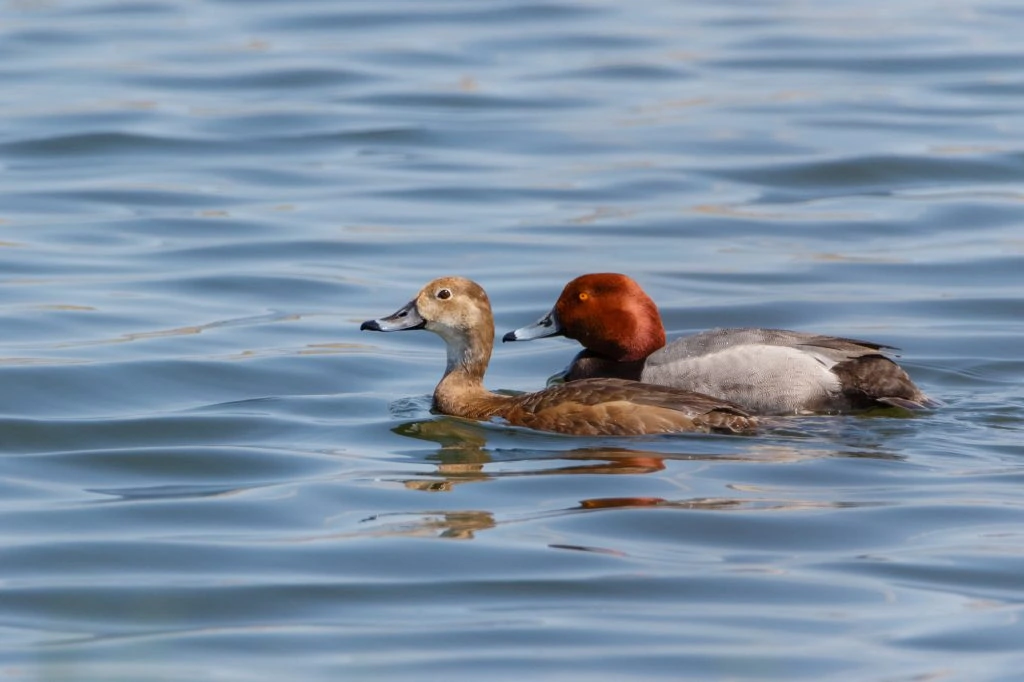
Redheads breed in western Canada, Alaska, and western US states before migrating for winter to southern US states, the east coast of the US, Mexico, and the Caribbean.
They appear in 1% of summer checklists and 3% of winter checklists.
Redheads are exactly what these medium-sized diving birds are. They have a striking red head, contrasting with a black throat and chest and a gray body. Their bill is blue-gray with a black tip. Females share the same bill but are otherwise brown all over.
- Aythya americana
- Length: 18 – 22 in (46 – 56 cm)
- Weight: 43.03 oz (1219 g)
- Wingspan: 29 – 35 in (74 – 89 cm)
You can find Redheads in marshes, open lakes, reedy ponds, and bays where the water is deep enough to dive and root out plant vegetation. In winter, they migrate to coastal shorelines with calm waters or in reservoirs and estuaries.
Redheads dive for food, but they don’t go as deep as other ducks. Their movement may be more similar to dabbling. They eat a lot of plant vegetation when it’s not the breeding season. Their food includes seeds, tubers of pondweeds, water lilies, and grasses. Breeding season means they eat a lot of animals like mollusks, insects, and small fish.
Redhead Calls:
Male Redhead
Female Redhead
Nests of Redheads are formed by the females over or near the water. They are thick and bulky, made out of plant stems, cattails, and sedges. Redheads lay nine to fourteen eggs, but there are times when they lay their eggs in other ducks’ nests. Incubation of the eggs lasts for about a month.
Fun Fact: Redheads can form large flocks of thousands in two Gulf of Mexico bays during winter.
24. Canvasback
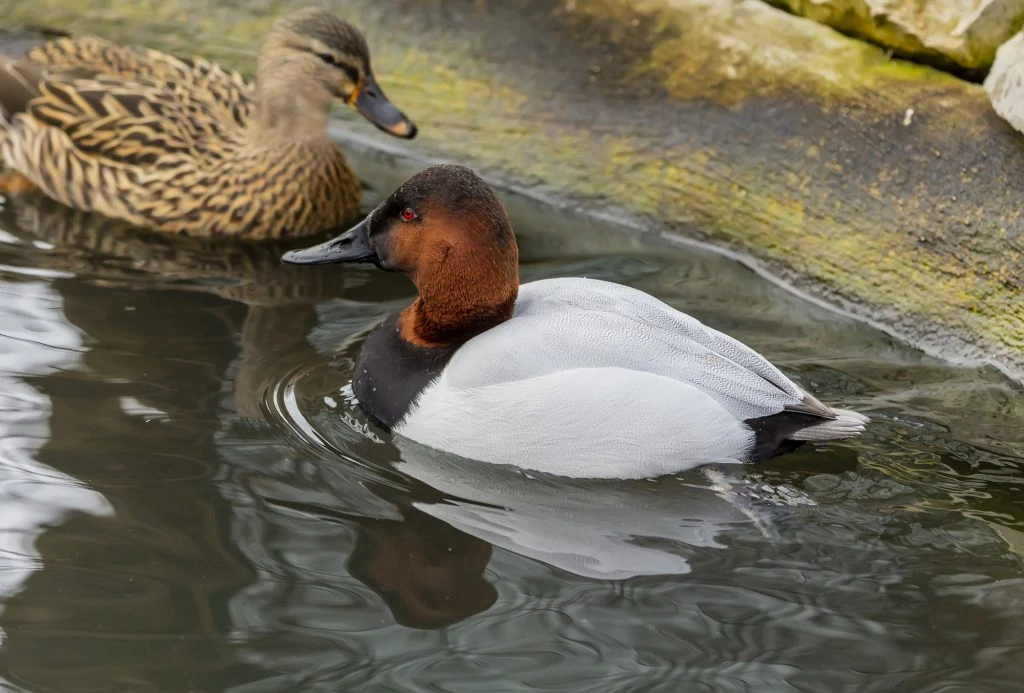
Canvasbacks breed in western Canada and some areas in northcentral states before migrating to southern US states, Mexico, and the east and west coasts of America.
Canvasbacks mainly spend winter in the United States and are generally spotted from October to May. They occur in 2% of winter checklists.
Male Canvasbacks are easily recognizable ducks from the Anatidae family because of their red eyes and sloping reddish-brown heads and throats. Their chest is black, but their bellies and backs are white or grayish. Their bottom is black too. Females are mostly brown in the head, throat, and chest, but their backs and bellies are brown and gray.
- Aythya valisineria
- Length: 19 – 24 in (48 – 61 cm)
- Weight: 58.48 oz (1657 g)
- Wingspan: 28 – 36 in (71 – 91 cm)
You can find Canvasbacks in prairie marshes, deep-water marshes, lakes, bays, and ponds. They usually join large flocks with other birds, but their white bodies and sloping heads easily make them stand out. In winter, they prefer to live in freshwater lakes and coastal waters.
Canvasbacks are diving ducks, so they typically forage for food in open water. Their webbed feet are perfect for diving as they root out tubers and other plant food at the bottom of marshes, lakes, and ponds. They may occasionally dabble for seeds, buds, roots, snails, and insect larvae, too. Their favorite food is the tubers of Sago Pondweed.
Canvasback call:
Nests of the Canvasbacks are bulky and strong, made of reeds and grass that may be found on open water or on marshes with lots of plant vegetation and protective cover. The female lays five to twelve eggs that take about a month to hatch. It takes about sixty to seventy days for the ducklings to be able to fly and fend for themselves.
Fun Fact: The word “valisineria” in the Canvasbacks’ scientific name comes from Vallisneria americana, or wild celery, which is their favorite food during the non-breeding period.
25. Greater Scaup
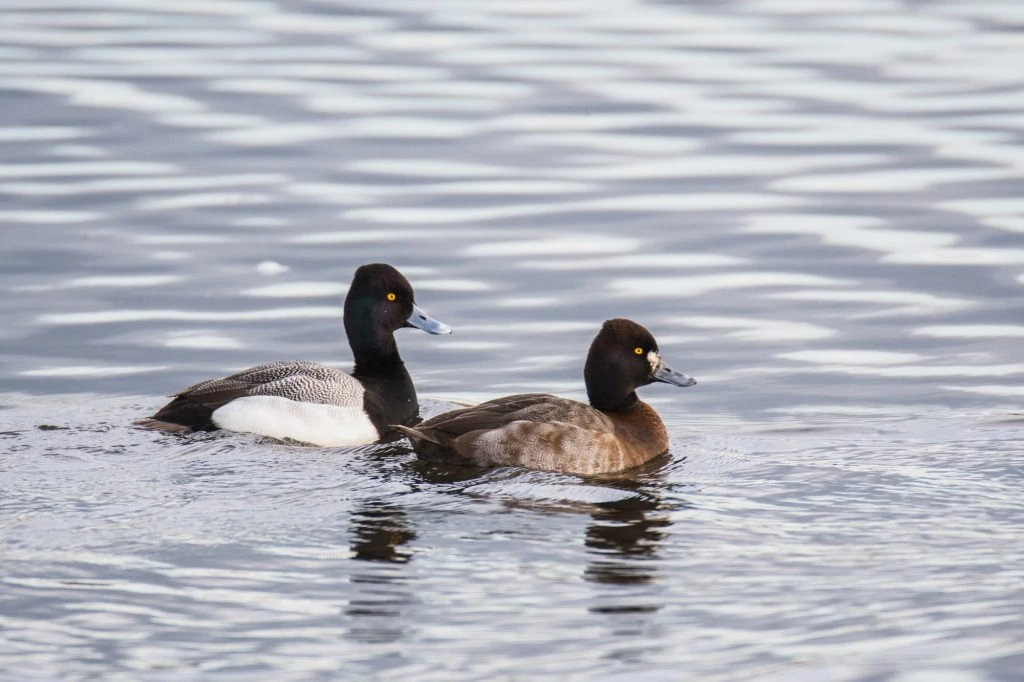
Greater Scaups breed in the north of Canada and in Alaska before migrating to the Pacific and Atlantic Coasts for winter, but more on the Atlantic side.
Greater Scaups are mainly spotted in the United States from October to April and appear in 2% of checklists at this time.
Greater Scaup males are ducks with iridescent dark green heads with blue bills, gray barred backs, and white sides. From a distance, they look black and white. Males molt after the breeding season and have mottled brown and gray bodies with darker heads.
Females are brown with a white patch between each eye and bill. Both males and females have yellow eyes. Greater Scaups look very similar to Lesser Scaup except with rounder heads.
- Aythya marila
- Length: 15.3 – 22.1 in (39 – 56 cm)
- Weight: 25.6 – 48.0 oz (726 – 1360 g)
- Wingspan: 28.4 – 31.1 in (72 – 79 cm)
You can find Greater Scaups in shallow lakes and ponds during the breeding season. In winter, they migrate towards the coast and can be found in bays and shores, but also on the Great Lakes. They form huge ‘rafts’ of birds out at sea.
Greater Scaups are diving ducks that eat invertebrates and plants at the bottom of lakes and the sea. They will push their open bills into the soft mud while swimming forward and quickly close it on any prey.
Greater Scaup call:
Greater Scaup flight call
Nests of Greater Scaup are on the ground, near water, and they add grass and down feathers to the small depression. They sometimes lay their eggs on floating mats of vegetation. They lay up to thirteen eggs which take around twenty-five days to hatch. The young leave the nest almost immediately.
Fun Fact: Greater Scaups can dive up to 23 feet underwater to hunt on the bottom for food.
26. Mottled Duck
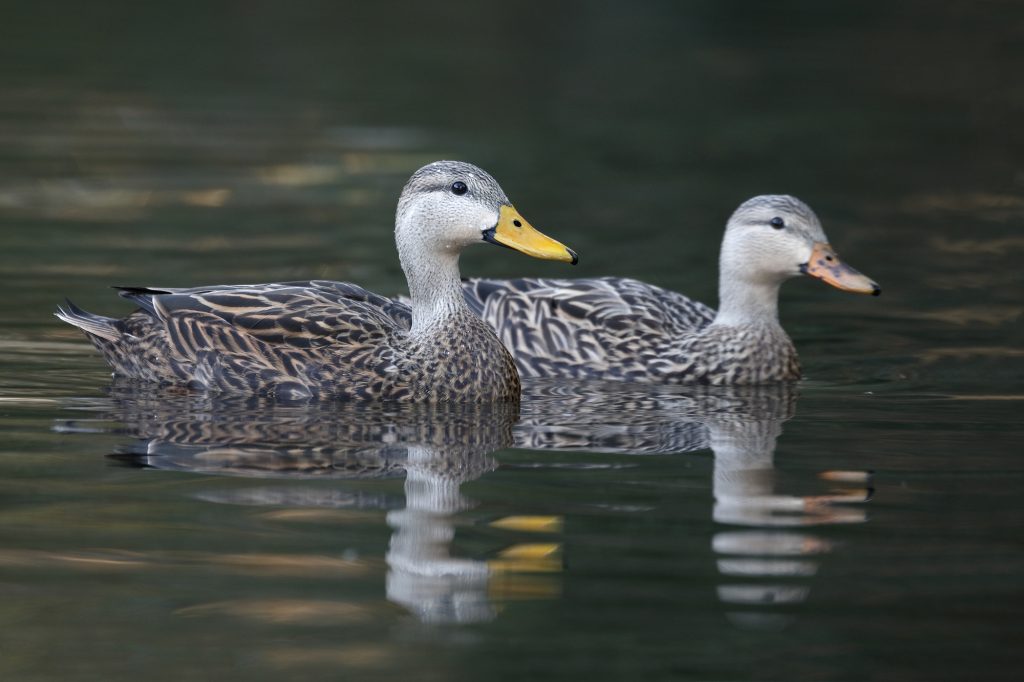
Mottled Ducks are year-round residents of the Gulf coast, but they may move inland depending on food availability.
Mottled Ducks are medium-sized, non-migratory birds from the Anatidae family. Males and females both have light brown heads with a horizontal dark line across the eyes.
Their bodies are dark brown with a scalloped pattern from chest to bottom. They both have a striking blue-purple patch on their wings. The difference is that males have a bright yellow bill while females are a dull olive color.
- Anas fulvigula
- Length: 20 – 22 in (51 -56 cm)
- Weight: 36.8 oz (1043 g)
- Wingspan: 30 in (76 cm)
You can find Mottled Ducks in shallow coastal marshes, flooded agricultural lands, irrigation ditches, and wet prairies.
Mottled Ducks dabble in shallow water for food. They mostly eat snails, fish, crabs and shrimp, and aquatic vegetation. They also eat grains, seeds, grass, and berries.
Mottled Duck call:
Nests of Mottled Ducks are commonly found hidden in the ground, among lush vegetation, and definitely near the water. The female makes the nests out of grasses and lines them with feathers to prepare for as many as twelve eggs. After about twenty-seven days, the eggs hatch.
Mottled Duck ducklings are born able to take care of themselves, and the females only have to lead them to their food source. It may take up to seventy days before they’re able to fly.
Fun Fact: Interbreeding with wild Mallards may cause the disappearance of pure-bred Mottled Ducks.
27. Tufted Duck
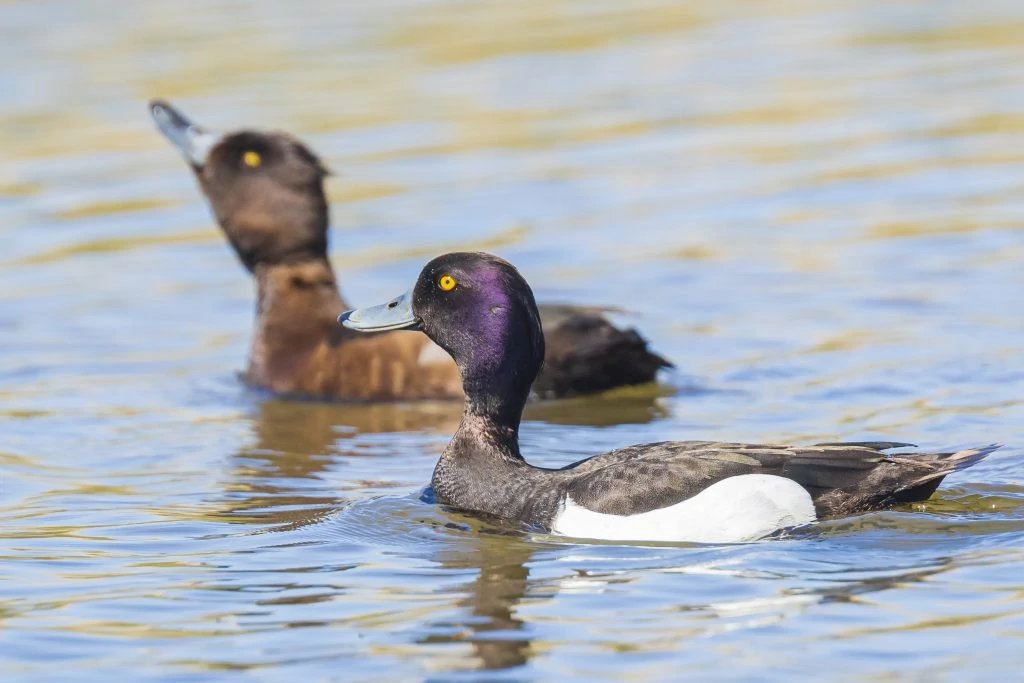
Tufted Ducks are not very common in the United States, but they are recognized as regularly occurring, but there have been sightings here all year, especially along the west and east coasts.
Tufted Ducks are small diving ducks with long, thin crests behind their head. They have a blue-gray bill and brilliant yellow eyes that stand out against their black head.
Males’ upper half of their bodies are glossy black with a purple color, and the lower half is white. Their webbed feet are black as well.
Females have a shorter crest, dark brown on the breast and back, lighter brown on the sides, and white on their bellies. In flight, both their bodies have a white stripe on their wings.
- Aythya fuligula
- Length: 17 – 18 in (43 – 46 cm)
- Weight: 35.97 oz (1019 g)
- Wingspan: 30 – 35 in (76 -89 cm)
Tufted Ducks are usually found in Eurasia, but they wander to the coasts of the US and Canada, mainly in winter.
You can find Tufted Ducks in large lakes and bays, marshy wetlands, lakes, and ponds with dense vegetation. They’re also found on coastlines, shorelines, and sheltered ponds.
Tufted Ducks are agile divers reaching up to ten feet below the surface of the water. They feed on roots, seeds, and buds of plants and eat occasional animals like small fish, clams, snails, and insects.
Tufted Duck call:
Male Tufted Duck
Female Tufted Duck
Nests of Tufted Ducks are built on the ground, hidden behind tall grass, weeds, and other plant vegetation. They are made of grass and lined with feathers. The females lay as many as ten eggs, and they take twenty-eight days to hatch.
Fun Fact: Tufted Ducks have slowly begun to expand their reach because of the creation of artificial lakes that are suitable habitats for them.
28. Masked Duck
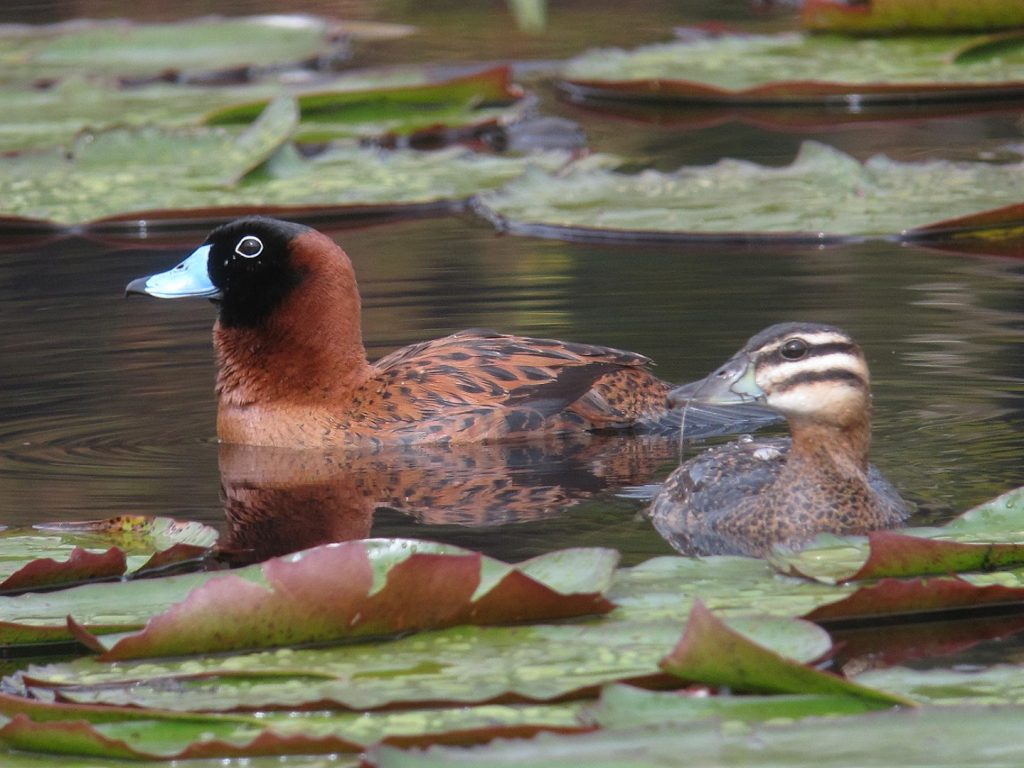
Masked Ducks are not often spotted in the United States, but they do not migrate and have been spotted around the south.
Masked Ducks are rarely seen, stiff-tailed ducks and are the only members of the genus Nomonyx. They are aptly named for Male masked ducks have an obvious black face mask, bright blue bills, and russet bodies with black streaks on the back and sides.
Female Masked Ducks don’t have an obvious mask, but they do have a black cap and two horizontal black lines across their face. One is across the eyes, and one is under the eye, right on the cheek line. They have blue-gray bills and reddish-brown bodies with a mottled pattern on their backs and sides.
- Nomonyx dominicus
- Length: 13 in (33 cm)
- Weight: 12.8 oz (363 g)
- Wingspan: 17 in (43 cm)
You can find Masked Ducks in freshwater marshy ponds surrounded by lots of trees for cover. They are also seen in mangrove swamps, rice fields or plantations, and lagoons.
Masked ducks feed mainly at night on various seeds, roots, and leaves of aquatic vegetation. They also eat aquatic insects and crustaceans. They mostly do short dives and tip up instead of deep diving, like other ducks.
Masked Duck call:
Nests of Masked Ducks are mostly found among marsh vegetation in shallow water. The nests are made of reeds and grasses with a lining of down feathers. The female lays four to ten eggs and will sometimes lay her eggs in other females’ nests. It takes about 4 weeks to incubate the eggs with the male staying nearby.
Fun Fact: Masked Ducks swim very low in the water, with only their head and their neck showing above the water.
29. Common Pochard
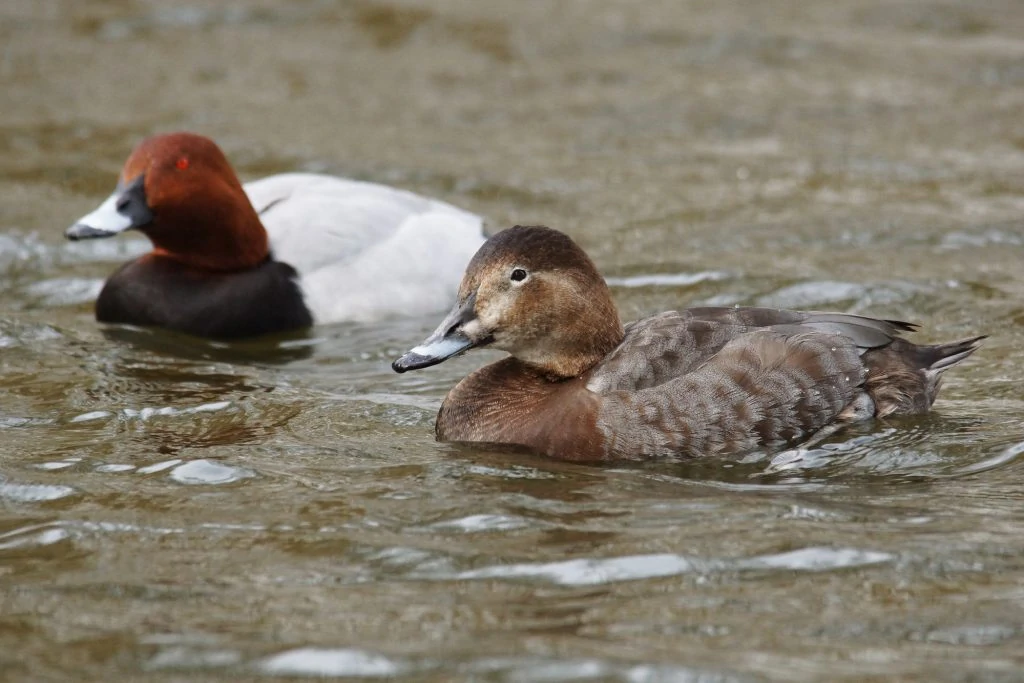
Common Pochards are considered vulnerable and rare species in the United States. They have been spotted around California, Florida, New York, and Vermont.
Common Pochards are medium-sized, elegant-looking birds. Males have bold, red heads and throats, long black bills with a gray band in the middle, black bellies, white backs and flanks, and black tails. They also have red eyes.
Females are less striking, but their pattern combinations are stunning. They are mostly brown and have a scalloped pattern, gray-brown colored backs, and flanks. They do share the same long, black bill with the gray band as the males.
- Aythya ferina
- Length: 16.5 – 23 in (42 – 58 cm)
- Weight: 28.8 oz (816 g)
- Wingspan: 29 – 35 in (74 – 89 cm)
Common Pochards are usually found in Eurasia and Africa, but they occasionally wander into Alaska.
You can find Common Pochards in different types of water habitats, like lakes, reservoirs and hardly-moving rivers, and marshes. They prefer areas with dense vegetation along the shoreline and a water depth that’s suitable for diving. They may also be occasionally found in brackish water areas, but they much prefer freshwater habitats.
Common Pochards dive and swim underwater for food. They may keep their head underwater while feeding on seeds, stems, leaves, and roots of aquatic plants. They may also eat algae and aquatic insects, mollusks, small fish, and crustaceans.
Common Pochard Call:
Male Common Pochard
Female Common Pochard
Nests of Common Pochards are shallow depressions concealed in thick vegetation on the ground, built out of grass stems and feathers, and very close to water. The female lays six to twelve eggs that she incubates for twenty-five days.
Fun Fact: Male Common Pochards look very similar to Redheads. The difference lies in the color of their eyes. Male Common Pochards have red eyes while Redheads have yellow eyes.
Sea Ducks (Diving Ducks) (15 Species)
Sea ducks are members of the subfamily Mergini that are different from other diving ducks. They spend the majority of their time out at sea in winter and often breed in the far north.
30. Hooded Merganser
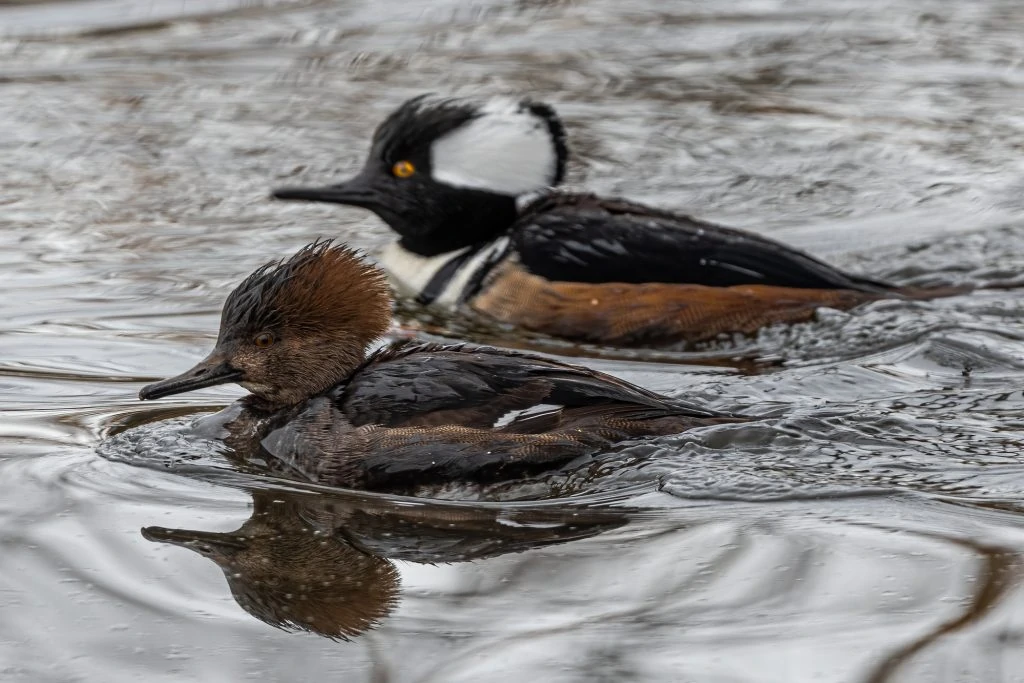
Hooded Mergansers live in eastern US states all year, but those in eastern Canada migrate for winter. They also spend all year in southwestern Canada. They can be spotted during migration in the Midwest and in winter in southern US states and the West Coast.
They are recorded in 1% of summer checklists and 6% of winter checklists submitted by bird watchers for the country.
The Hooded Merganser is the second smallest species of Merganser and the only Merganser that lives entirely in North America.
Male Hooded Mergansers are striking ducks because of the crests on their head that they can raise or lower, which then changes the shape of their head and the pattern of the crest. When open, the crests are huge white patches, but when closed, they are a thick white line.
Apart from the white crests, their heads are black, and they have golden yellow eyes. Their bodies are black, except for their cinnamon-colored flanks and white chests. They have two black bars on their chests, and their lower backs have white stripes.
Females have the same crest, but theirs is reddish-brown. Their bodies are brownish-gray all over, lighter on the bottom and darker on top. Their eyes are somewhat duller than the males. Juveniles have brownish crests, black top half, and brownish-gray on their bottom half.
- Lophodytes cucullatus
- Length: 16 – 19 in (41 – 48 cm)
- Weight: 32.09 oz (909 g)
- Wingspan: 24 – 26 in (61 – 66 cm)
You can find Hooded Mergansers in freshwater lakes, ponds, and slow-moving rivers. They prefer to breed in small, forested ponds and estuaries with lots of aquatic vegetation. During migration, they visit a wide range of habitats, like open water, coastal bays, and tidal creeks. In winter, they are found in brackish swamps, saltwater bays, and inlets.
Hooded Mergansers forage by diving underwater. They catch their prey with their serrated and hooked bill. They will eat aquatic insects, fish, and crustaceans, particularly crayfish. In forested regions, they may eat snails, frogs, aquatic plants, and seeds.
Hooded Merganser Call: They are usually silent, but male Hooded Mergansers will make a frog-like croak during courtship, and females make a flight call.
Male Hooded Merganser call
Female Hooded Merganser call
Nests of Hooded Mergansers are often found in tree cavities that are about ten to twenty feet above the ground. They are usually beside or close to a water source and lined only with down feathers. Females lay seven to fifteen eggs and will incubate them all at the same time after the last egg has been laid. The incubation period usually takes just over thirty days.
Within twenty-four hours after hatching, the young jump to the ground from the nest and head to the closest water source. They can swim on their own and are able to find their own food. The female will still tend to them and lead them to areas with abundant food but only for a few more weeks.
Fun Fact: Hooded Mergansers are able to see underwater, which helps them when they forage for food.
31. Common Merganser
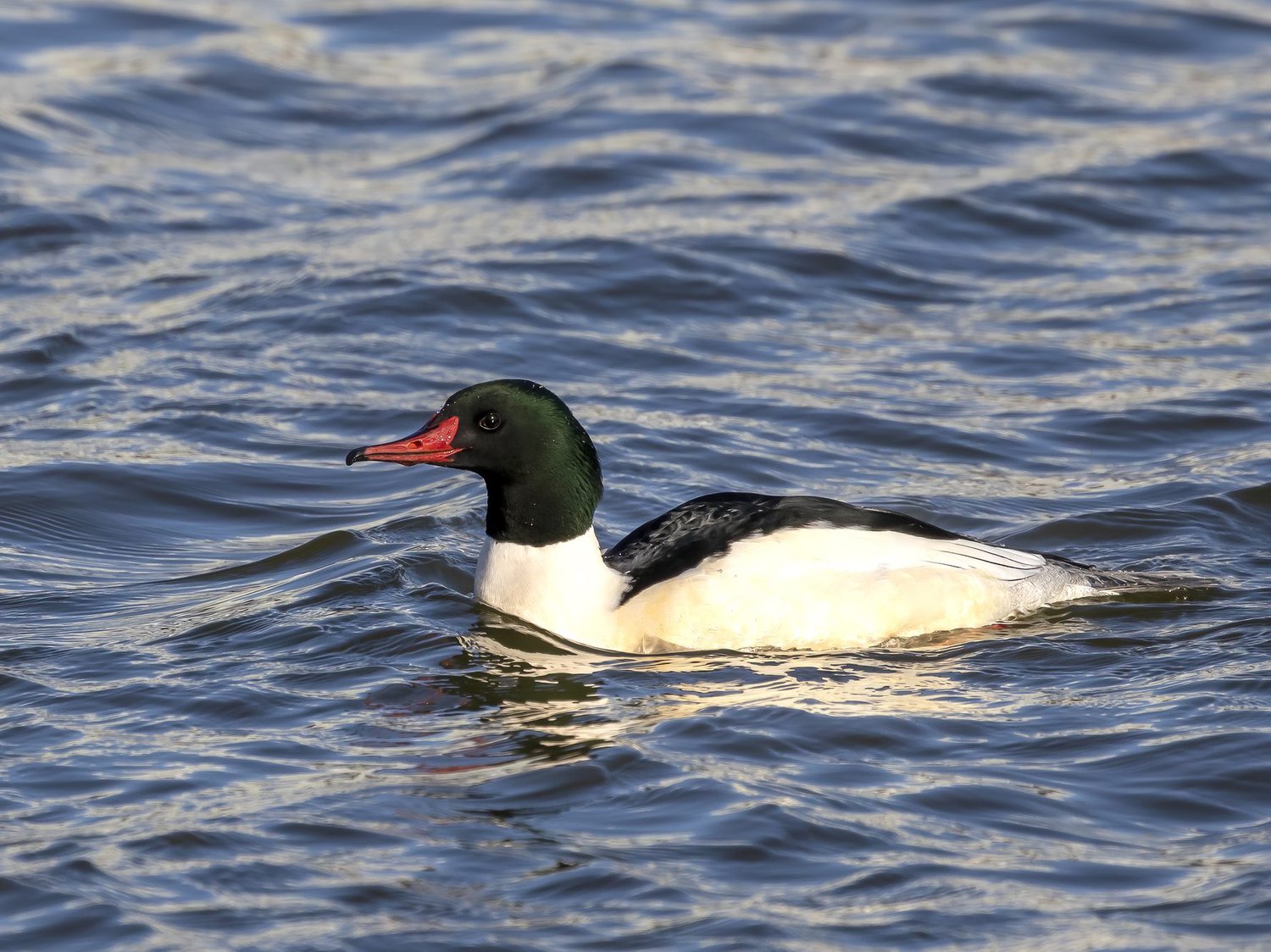

Common Mergansers breed in Canada and migrate to the US. Some remain all year in northeastern and northwestern US states.
They appear in 1% of summer checklists and 5% of winter checklists.
Male Common Mergansers are simple-patterned birds but striking nonetheless. They have black heads with a glossy green sheen, dark eyes, bright-red, long, serrated bills, white bodies, and black backs. While they do have a crest, it’s not often visible.
Females have a more prominent reddish-brown crest. They have the same red, serrated bill as the males. They also have a white chin patch, and their breast and bellies are white, their backs are gray. Juveniles resemble females.
- Mergus merganser
- Length: 22 – 27 in (56 – 69 cm)
- Weight: 60.8 oz (1723 g)
- Wingspan: 31 – 37 in (79 – 94 cm)
You can find Common Mergansers in freshwater lakes and ponds. They are also found in small rivers and shallow shorelines and even sitting on rocks in the middle of a stream. While they prefer freshwater habitats, they sometimes visit saltwater regions too, like coastal estuaries and harbors.
Common Mergansers are diving ducks, and they love to eat fish, particularly the adults. Their serrated bills make it easy for them to capture and hold these fish as well as mussels, crustaceans, and other aquatic creatures. Gulls often follow them when hunting to steal the fish from them.
Common Merganser Calls: They are usually fairly quiet, but Male Common Mergansers give alarm calls, and females make a series of grunting calls to their young.
Male Common Merganser call
Female Common Merganser call
Nests of Common Mergansers are usually found in a tree cavity in mature forests. They often use abandoned tree holes and line them with down feathers. They also use nest boxes where available. If there are no tree cavities, they use crevices on cliffsides.
Females lay six to seventeen eggs and have been known to lay eggs in other nests of the same species. They incubate these eggs for around thirty days. When the young hatch, they immediately head for the water to feed themselves. The female may assist them in finding food, but otherwise, they fend for themselves.
Fun Fact: Common Mergansers are also called “sawbills,” “fish ducks,” or “goosanders.”
32. Common Goldeneye
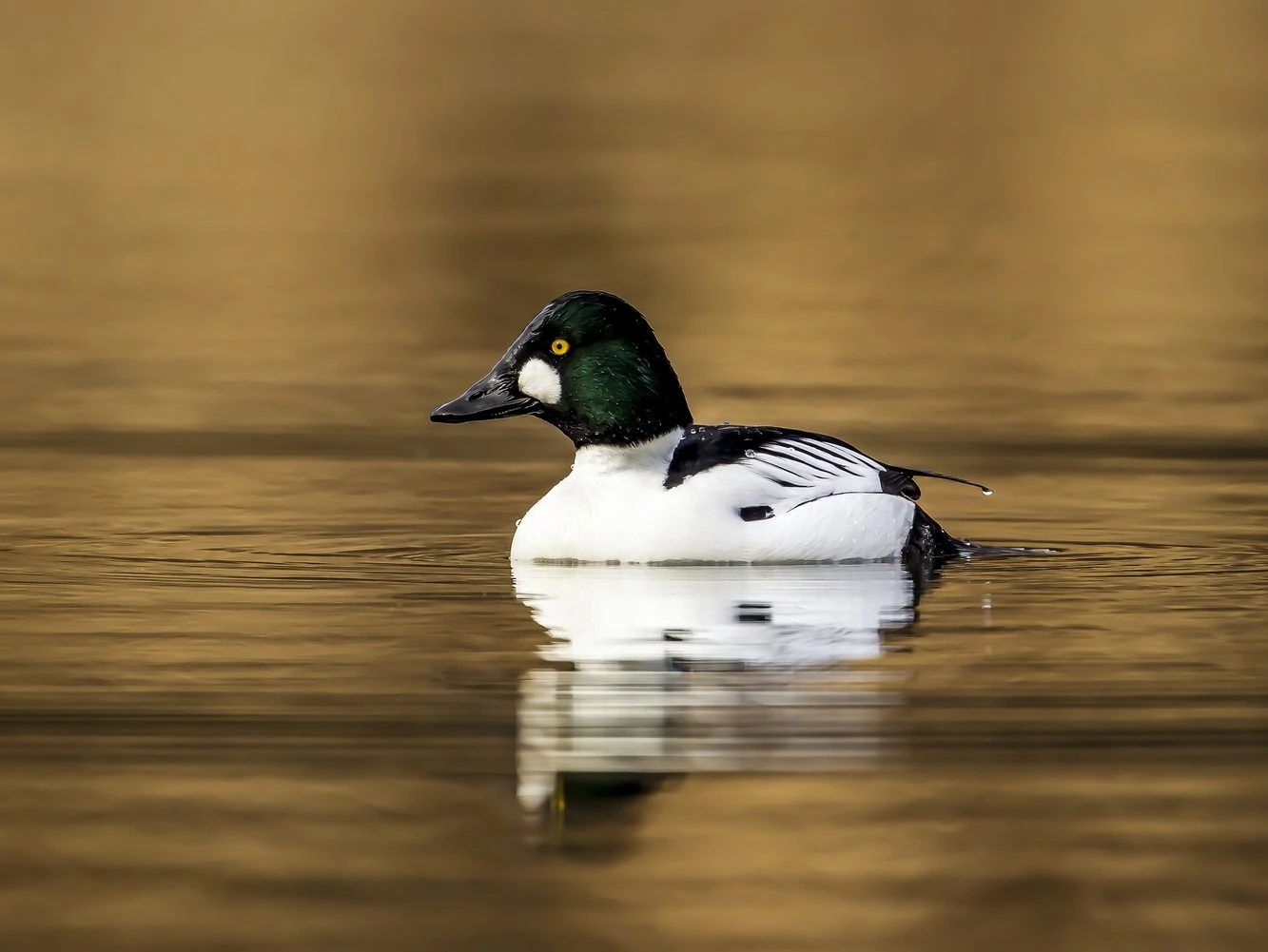
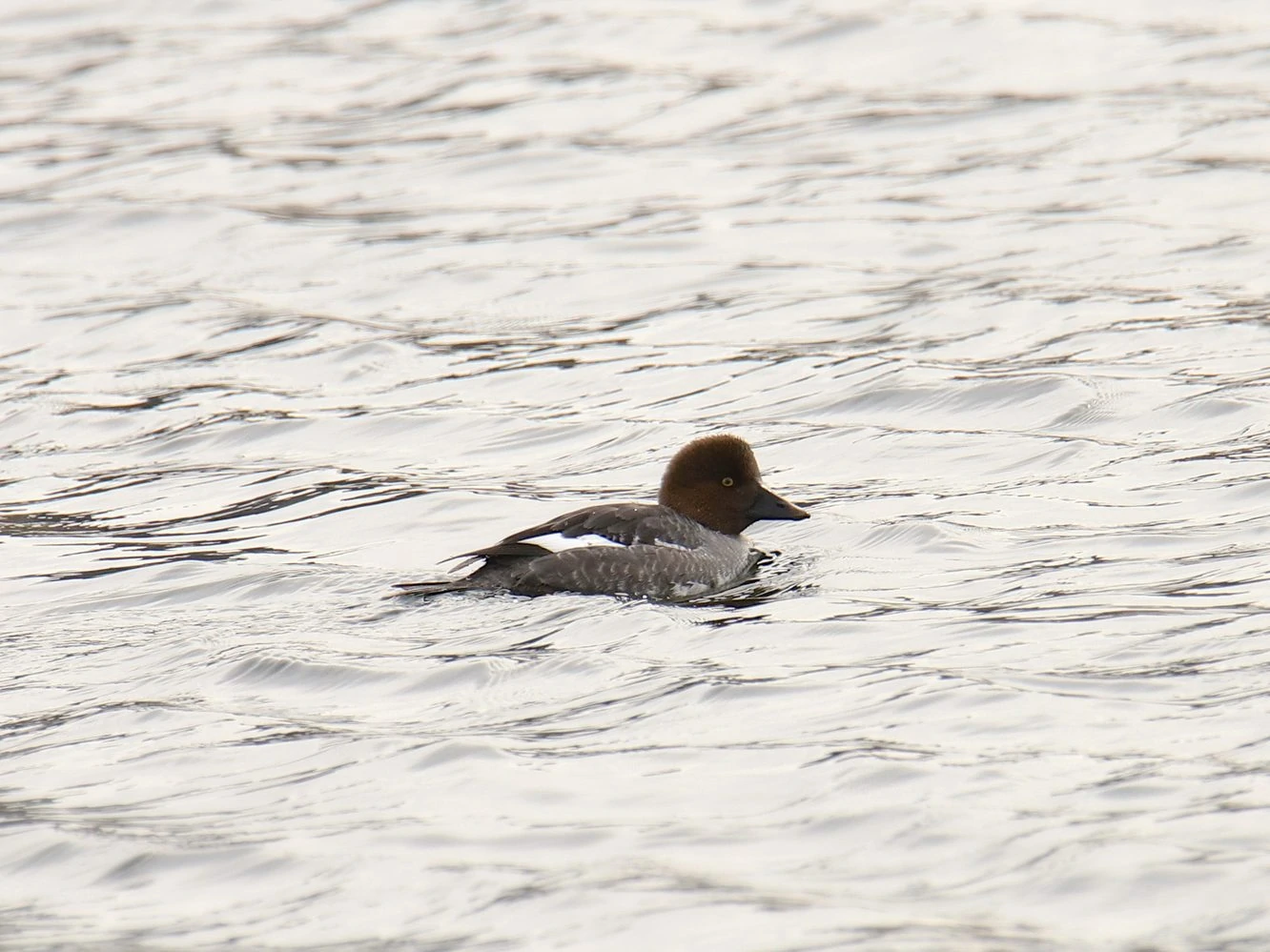
Common Goldeneyes are mainly spotted in the United States in winter from November to May and occur in 6% of winter checklists.
Common Goldeneye males have green heads that are iridescent and can look almost black. They have a white spot under their yellow eyes. They have white bodies and sides and black backs.
Female Common Goldeneyes are grayish-brown with brown heads. Both males and females have black bills, but females have a yellow tip.
- Bucephala clangula
- Length: 15.8 – 20.1 in (40 – 51 cm)
- Weight: 21.2 – 45.9 oz (600 – 1300 g)
- Wingspan: 30.3 – 32.7 in (77 – 83 cm)
Common Goldeneyes breed in Canada and Alaska in summer and migrate late to the lower 48 for winter.
You can find Common Goldeneyes in boreal forest lakes during the breeding season and in coastal areas in winter. Common Goldeneyes are diving ducks that feed on crabs, shrimp, crayfish, fish, fish eggs, and insects.
Common Goldeneye Calls: They are quiet ducks, but male Common Goldeneyes make soft calls, and females make harsh alarm calls.
Common Goldeneye Male
Common Goldeneye Alarm call
Nests of Common Goldeneye are in holes in trees, and they use whatever is in there, plus some plucked-down feathers for the nesting material. They lay up to nine eggs which take around thirty days to hatch.
Fun Fact: Common Goldeneyes can fly at speeds of over 40 miles per hour.
33. Red-breasted Merganser
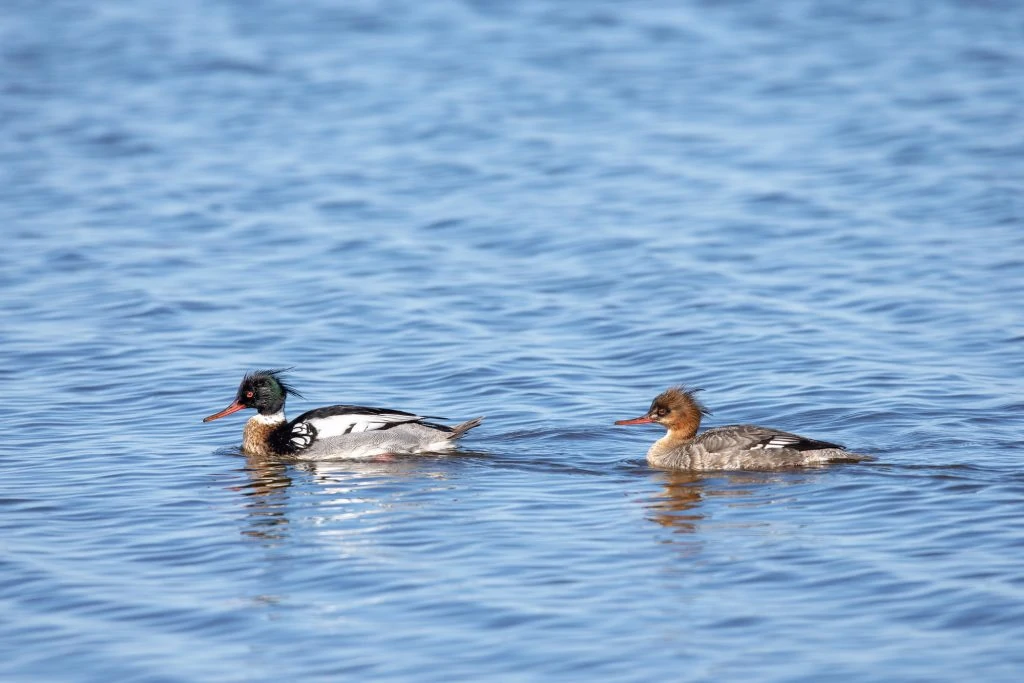
Red-breasted Mergansers breed in Canada, except in the southwest, before migrating to the coasts of the US and Canada. They can be spotted during migration in all US states.
Breeding Male Red-breasted Mergansers are certainly noticeable ducks. Their black, glossy green, ragged, and spiky crests, dark red eyes, and long, serrated orange bills certainly make them stand out among other ducks. They also have a white neck collar, mottled reddish-brown breast, black and white back, and gray flanks.
Females and non-breeding males have reddish-brown spiky crests, red eyes, long, red bills, white throats, and gray bodies.
- Mergus serrator
- Length: 16 – 26 in (41 – 66 cm)
- Weight: 47.61 oz (1349 g)
- Wingspan: 31 – 35 in (79 – 89 cm)
You can find Red-breasted Mergansers in tundra ponds, freshwater lakes and rivers, and brackish and saltwater wetlands, usually near the coast during the breeding season. In winter, they may also be found in the ocean.
Red-breasted mergansers normally dive when foraging for food and will pursue their prey underwater until they catch them. They will occasionally cooperate with other groups and herd schools of fish into shallow waters to make them easier to catch. Aside from fish, they also eat crustaceans, insects, and amphibians.
Red-breasted Merganser call: They are quiet birds, but they make calls during courtship or when alarmed.
Male Red-breasted Merganser
Female Red-breasted Merganser
Nests of Red-breasted Mergansers are often found on the ground, in a shallow depression, near the water. Females usually line them with plants and down feathers. Females lay five to sixteen eggs but may lay them in other females’ nests. The incubation period may run from twenty-nine to thirty-five days and is mostly done by the female.
Fun Fact: Red-breasted Mergansers don’t acquire their breeding feathers until they are two years old.
34. Surf Scoter
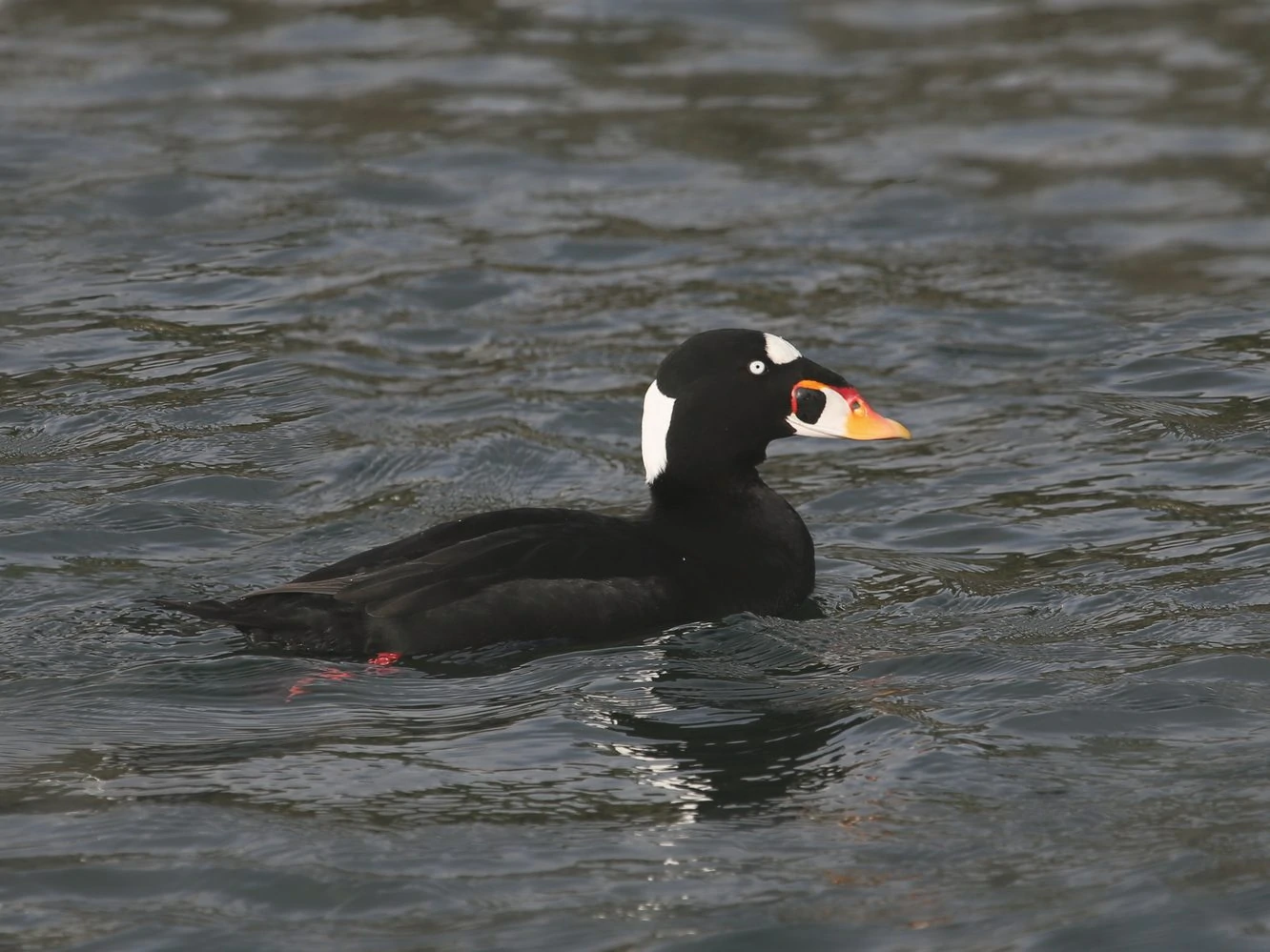
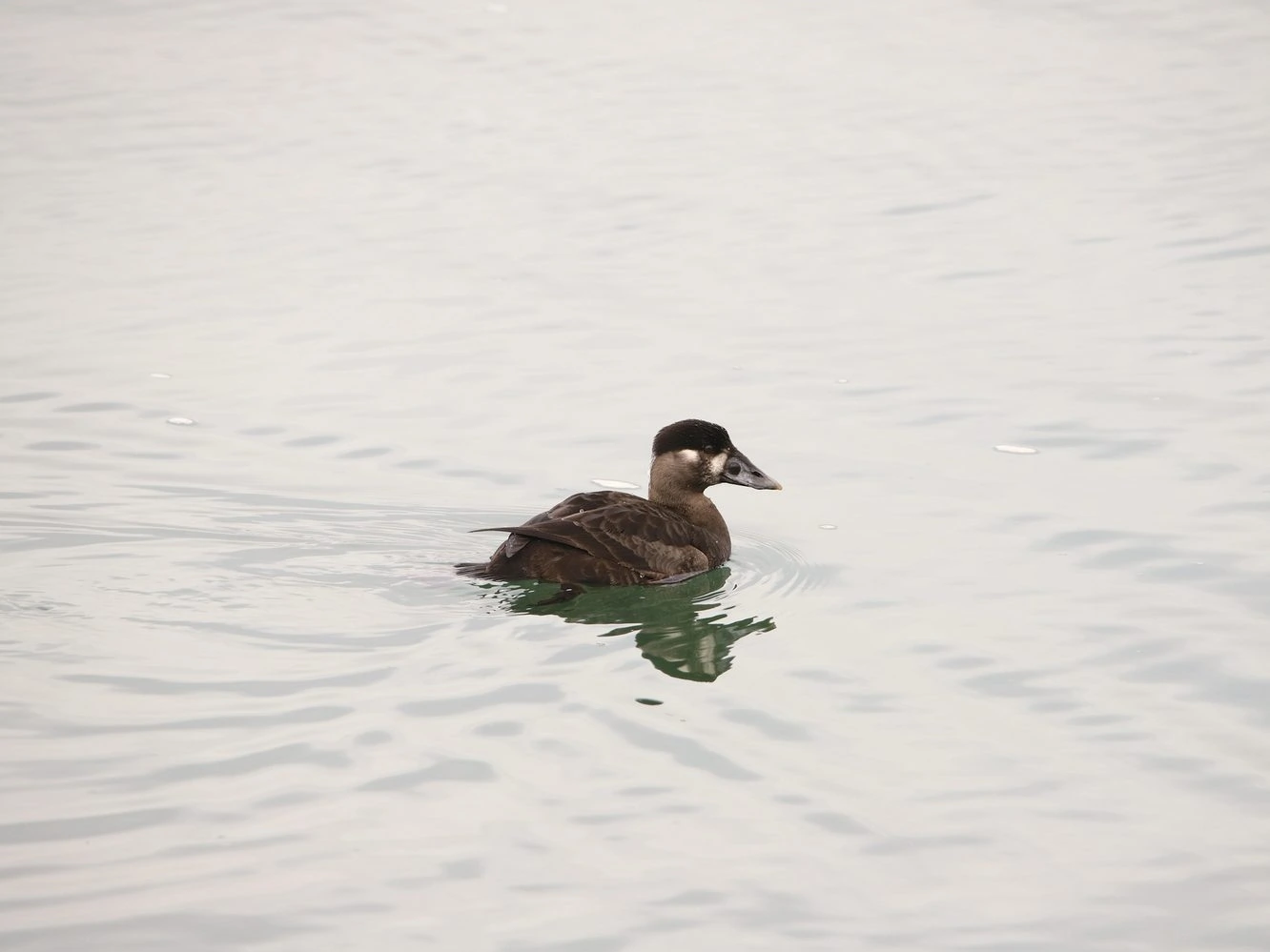
Surf Scoters are best spotted along the coasts of the United States during winter, but they can also be spotted during migration across the rest of the country.
Male Surf Scoters are medium-sized birds that are sometimes called “old skunk-head coot” because of the distinct white patches on their forehead and nape that stand out against their black, velvety feathers.
Aside from these distinctive features, male surf scoters also have a large orange bill with white, red, and yellow patterns. At the base of the bill is a large, black spot. Their eyes are white.
Female Surf Scoters are mostly dark gray, but they have the white patch at the base of their bill and near the back of their eyes. They have the same bill as the male, except that theirs is smaller and dark gray.
Juveniles are brownish in color, have black eyes, and have the same coloring and shape of the bill as the males.
- Melanitta perspicillata
- Length: 17 – 21 in (43 – 53 cm)
- Weight: 35.27 oz (1000 g)
- Wingspan: 30 – 36 in (76 – 91 cm)
Surf Scoters breed in northern Canada and Alaska before migrating to the US coasts and Canadian coast.
You can find Surf Scoters in forests near freshwater lakes during the breeding season. During their molting season, they prefer shallow bays, inlets, and estuaries, places that have a good source of food and lesser threats of predation. But, they are most likely on the ocean during winter.
Surf Scoters mostly get their food by diving underwater. They also adapt their foraging attempts depending on the abundance of food. For instance, they will feed on Pacific Herring eggs during their spawning since there is less effort but more food supply. During the breeding period, they will find freshwater invertebrates and crustaceans.
Surf Scoter calls:
Nests of Surf Scoters are usually well-concealed, built on the ground, under thick brush or low tree branches, and not always near water. The female digs a bowl-shaped depression on the ground and lines it with grass and down feathers, then lays around five to eight eggs which she incubates for about a month. In dense breeding areas, broods may get mixed up.
Fun Fact: Gulls often try to steal the prey that Surf Scoters catch from diving. That’s why flocks frequently make synchronized dives and surfacing to make it difficult for other birds to steal from them.
35. Long-tailed Duck
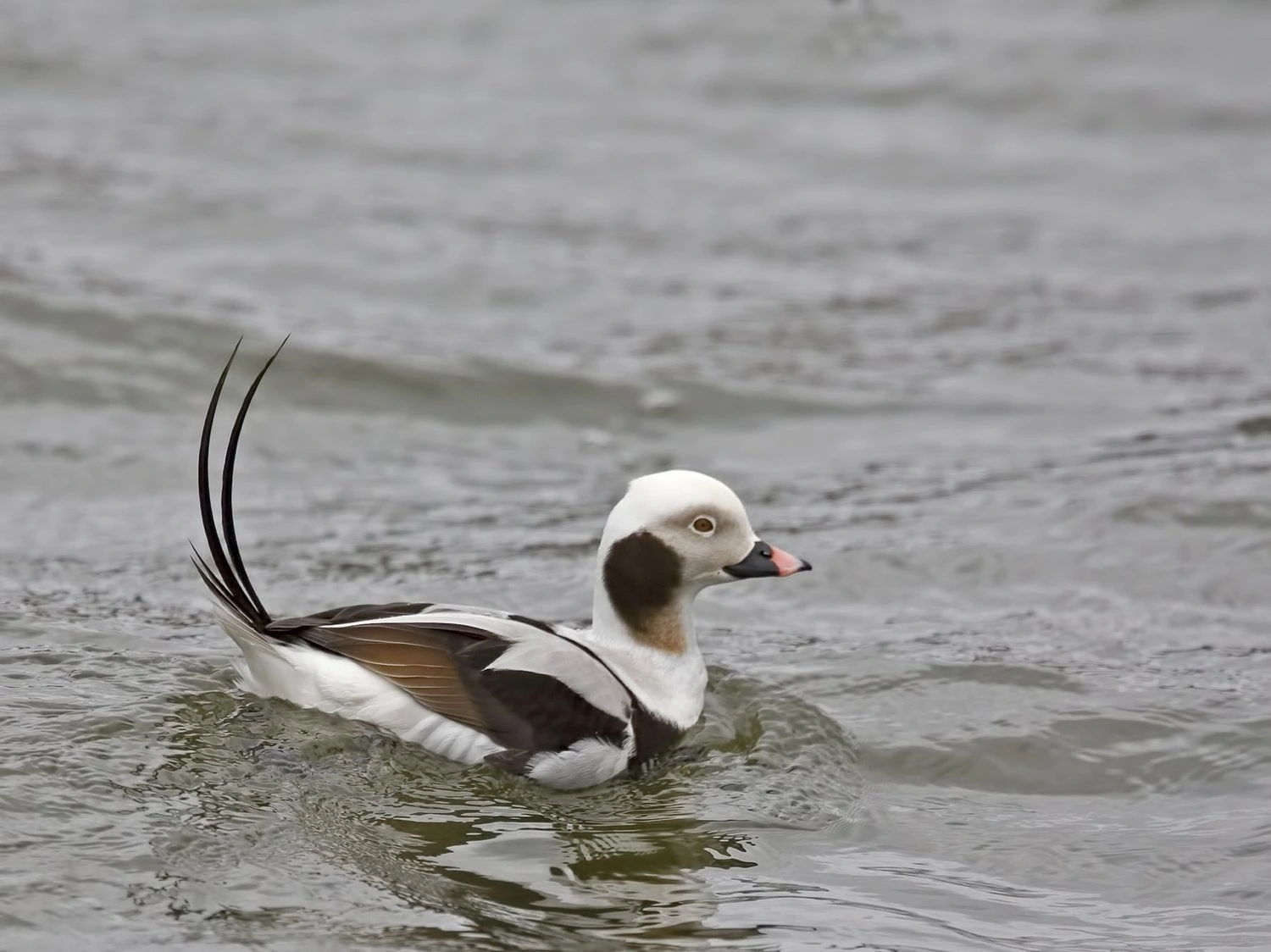
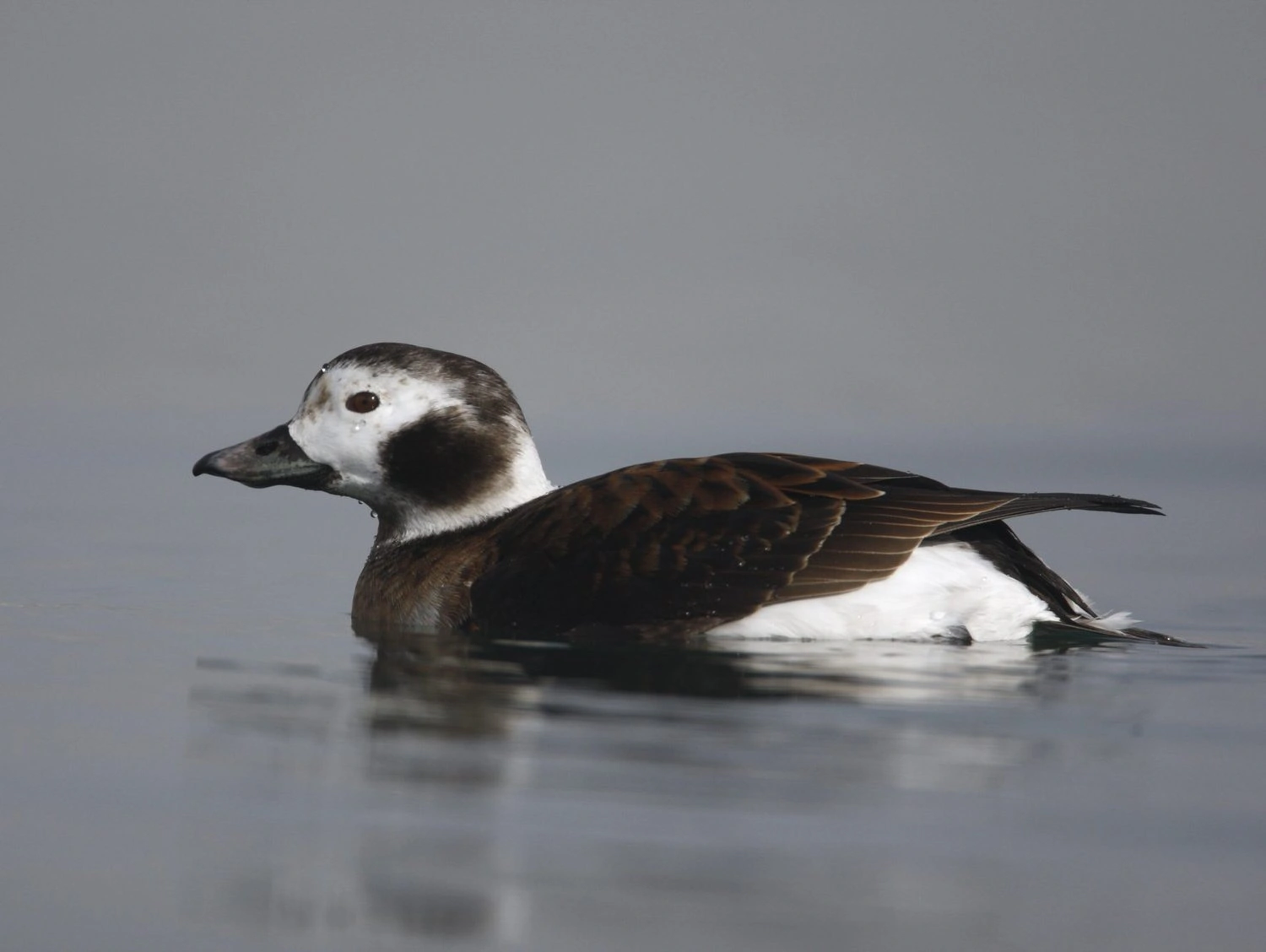
Long-tailed Ducks are vulnerable species in the United States, but they can be spotted here mainly during winter, from November to April.
The Long-tailed Duck is a small diving duck that has rather obvious slender, long and black tail feathers, hence the name. What’s interesting about the Long-Tailed Duck is that its coloring reverses between breeding (summer) and non-breeding (winter) seasons.
Adult non-breeding males have white crowns, foreheads, necks, backs, sides, and bellies. They have a gray mask and a dark cheek patch, a pink band across their black bill, and black breasts and wings with white shoulder blades. Their tails are long and black.
Their coloring reverses during the breeding season or in summer. Everything that was white is now dark-colored. Their crown, foreheads, necks, backs, sides, and bellies are now dark. Their cheek patch is now white, and the band on their dark bill is now gray.
Adult non-breeding females have dark crowns, white heads with a dark patch on the cheek, and gray bills. They have white necks and bellies. They have brown throats, backs, wings, and a relatively shorter tail. Like the males, their coloring reverses during the breeding season. They become browner overall but with a white patch around the eye and neck.
Juveniles resemble adult non-breeding females, particularly in coloring and with a shorter tail. But they have a darker patch on the cheek and a yellow-orange band on the gray bill like the adult males.
- Clangula hyemalis
- Length: 15 – 22 in (38 – 56 cm)
- Weight: 31.74 oz (900 g)
- Wingspan: 26 – 31 in (66 – 79 cm)
Long-tailed Ducks breed in the far north of Canada and Alaska and across northern Europe and northern Asia. In winter, they migrate south to the US, and those in Europe and Asia move south in these regions.
You can find Long-Tailed Ducks in many coastal water habitats. They are often in bays, harbors, fjords, estuaries, straits, and mudflats. During the breeding season, you can find them along ocean coasts and large freshwater lakes. They are known to join large flocks in areas with extensive sea ice.
Long-tailed Ducks usually dive for mollusks, crustaceans, and small fish in the oceans during winter. They are known to dive as deep as 200 feet to reach zooplankton which is usually at the bottom of water columns. They use their wings to propel them through the water. On the tundra, during summer, they mostly eat insects, fish eggs, and plants.
Long-tailed Duck calls:
Male Long-tailed Duck
Female Long-tailed Duck
Nests of Long-tailed Ducks are usually shallow depressions on the ground made by females. They are grouped together in small, tight clusters with other females’ nests. The first egg is covered with a layer of grasses, and with the addition of a second egg, the females add their own down to the nest.
Females can lay anywhere from six to nine eggs. They alone incubate the eggs for up to twenty-nine days. Males leave for their post-breeding molting site. The young are able to feed when they hatch.
Fun Fact: The Long-tailed Duck used to be known as “oldsquaw.”
36. Common Eider
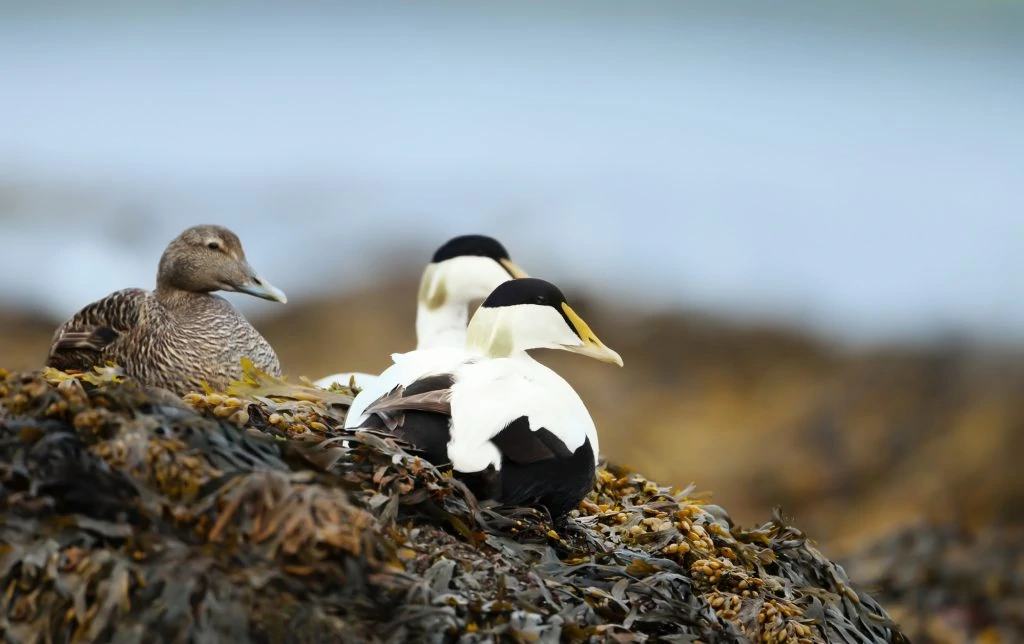
Common Eiders are near-threatened species in the United States, but they can be spotted in the east of the country all year, and along the coasts during winter.
Common Eiders are large sea ducks with sloping foreheads. Breeding males generally have white cheeks and backs, black caps, sides, and bellies, and pistachio-colored napes (back of the neck).
Females are reddish-brown all-over with black barring on their breasts, backs, and wings. Juveniles and non-breeding males are chocolate brown with varying degrees of white coloring on their breasts and backs.
- Somateria mollisima
- Length: 23 – 27 in (58 – 69 cm)
- Weight: 78.4 oz (2222 g)
- Wingspan: 35 – 42 in (89 – 107 cm)
Common Eiders have six subspecies, four of which breed in North America and have slight differences between them.
Common Eiders breed in Canada and Alaska and parts of northern Europe and Asia. Some remain in those areas in winter all year, but others migrate south.
You can find Common Eiders in marine or saltwater habitats that are near rocky coastlines. During the breeding season, you can find them in large colonies on coastal islands, islets, and shorelines with vegetation, shrubs, and stunted trees.
In winter, they settle in locations with rocky seafloors to easily forage for mollusks.
Common Eiders mainly eat mollusks, crustaceans, marine worms, and fish eggs. They forage at low tides and pry these mussels from rocks underwater with their strong, chisel-like bills.
They are able to swallow the mussels whole despite their shells. When eating crabs, they only eat the bodies and remove all of their legs and claws prior to eating.
Common Eider calls:
Male Common Eider
Female Common Eider
Nests of Common Eiders are made by the females by creating a depression on the ground with their feet and belly. They usually choose a site that’s sheltered and mostly used in previous years.
They lay three to eight eggs and line the nest with their own down after laying the third egg. When they have to leave the nest, they cover the eggs with the down. The females incubate the eggs for about twenty-four to twenty-six days, with the males staying close for protection.
Fun Fact: The Common Eider is also called St. Cuthbert’s Duck or Cuddy’s Duck because they were one of the first birds ever to gain protection laws as established by Saint Cuthbert in the year 676.
37. White-winged Scoter
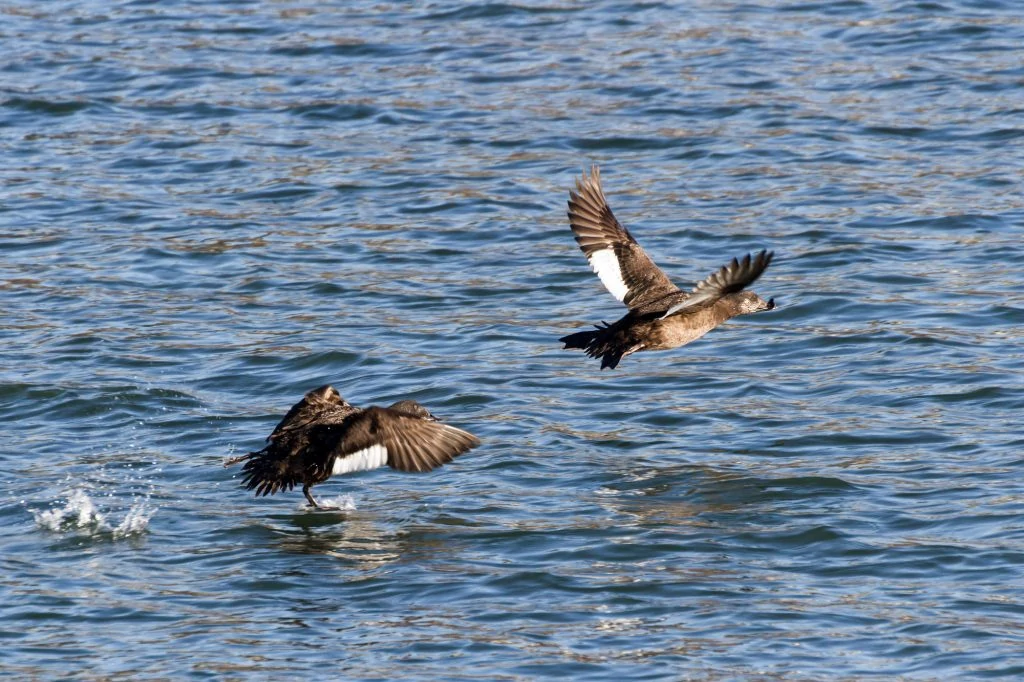
White-winged Scoters spend winter in the United States and are mainly spotted from September to April.
White-winged Scoters are the largest of the North American Scoters. They’re easily distinguishable from the other three because of their white wing patch since the other two Scoters have totally black wings.
Male White-winged Scoters also have the distinct white, reverse comma marking around the eye, earning them the nickname “Viking Horn.” Their orange-tipped bill is short and less bulbous than other Scoters, but it does have a large, dark knob at its base. Their bodies are mostly black.
Female and Juvenile White-winged Scoters are similar. They are both dark brown with white patches in front and behind their eyes. They have dark gray bills with a smaller knob at the base.
- Melanitta deglandi
- Length: 19 – 24 in (48 – 61 cm)
- Weight: 62.4 oz (1768 g)
- Wingspan: 33 – 41 in (84 – 104 cm)
White-winged Scoters breed in western Canada and Alaska before migrating for winter to the US and Canadian coasts.
You can find White-winged Scoters in northern forests near freshwater lakes and wetlands during their breeding season. During the winter, they prefer the open ocean and coastal environments, particularly bays and inlets.
White-winged Scoters are experts in diving deep underwater, capable of holding their breath while wrestling with shellfish from underwater rocks.
They usually forage in large flocks and prefer to forage from the bottom, but they will also take prey from the surface of the water. In freshwater habitats, they feed on mollusks, crustaceans, small fish, and aquatic insects.
White-winged Scoter call:
Nests of White-winged Scoters are shallow depressions on the ground, mostly concealed under a thick bush or a crevice and close to the water. They are built with plant material and lined with down.
The female lays eight to ten eggs and incubates them for twenty-five days to a month. The young leave the nest after hatching and can already feed themselves. The female takes care of them for about three more weeks.
Fun Fact: Female White-winged Scoters return to the nesting area where they were hatched. This behavior is called “Natal Philopatry.”
38. Black Scoter
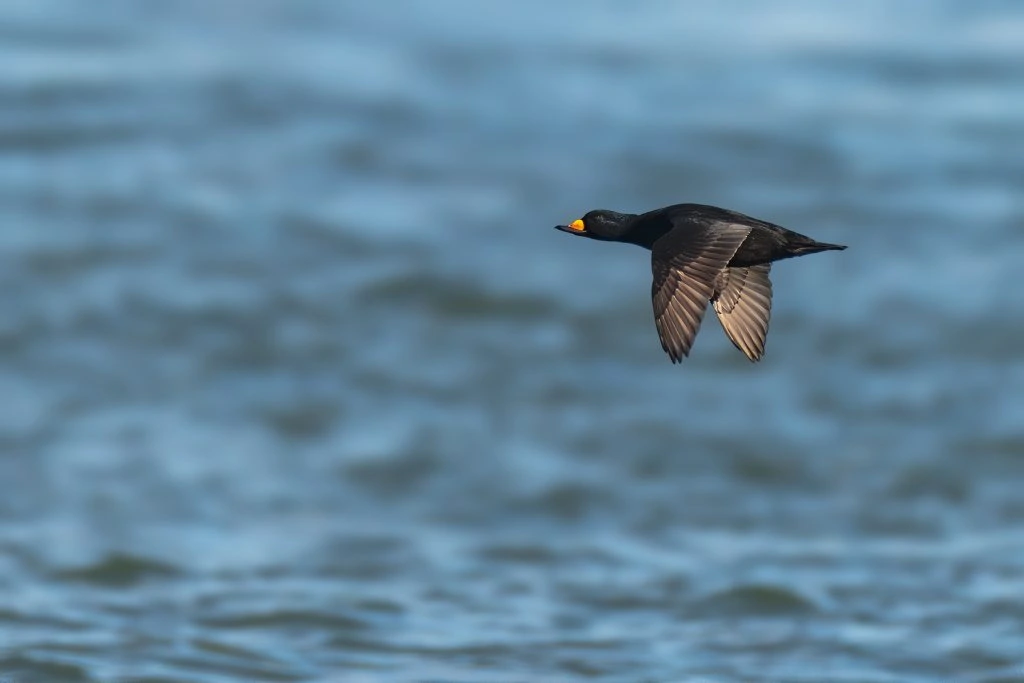
Black Scoters are near-threatened species in the United States, but they are spotted here mainly in winter from October to mid-April.
The Black Scoter is also called American Scoter. Male Black Scoters are aptly named because their whole bodies are velvety black, with the exception of a bright yellow patch at the base of their bills.
Female Black Scoters aren’t black at all. They are brownish overall, with the lower half of their head paler than the rest of the body. Their cap is dark brown, and their bill is black.
Juveniles are a combination of both males and females. Their coloring and dark cap are like the females, but they also have the yellow knob at the base of their bill like the males.
- Melanitta americana
- Length: 17 – 21 in (43 – 53 cm)
- Weight: 387.4 oz (1088 g)
- Wingspan: 30 – 35 in (76 – 89 cm)
Black Scoters breed in Canada and Alaska before migrating to coastal areas of the United States.
You can find Black Scoters primarily in saltwater, particularly along rocky coastlines, during winter, or when migrating. They usually form large winter flocks with other scoter species. During the nesting period, they move to more sheltered habitats like ponds and small lakes with vegetation on the edges.
Black Scoters dive for shellfish and mollusks in oceans and bay coasts. They may occasionally eat crabs and shrimp, and other marine vegetation on top of shellfish and mollusks. When they’re in freshwater, they eat a lot of insects and their larvae, fish eggs, and other vegetation.
Black Scoter calls: They are noisy birds that are easily identified in winter with the males’ descending whistle.
Nests of Black Scoters are usually hidden in a rock crevice or on the ground sheltered by grass clumps. They are usually within a hundred feet of the water. The female makes a depression on the ground or on grass and lines it with her own feathers.
She will lay around eight to nine eggs and incubates them for about twenty-eight days. She will tend to them for about three weeks, after which they have to fend for themselves.
Fun Fact: Tens of thousands of Black Scoters migrate south together, creating a fantastic spectacle.
39. Harlequin Duck
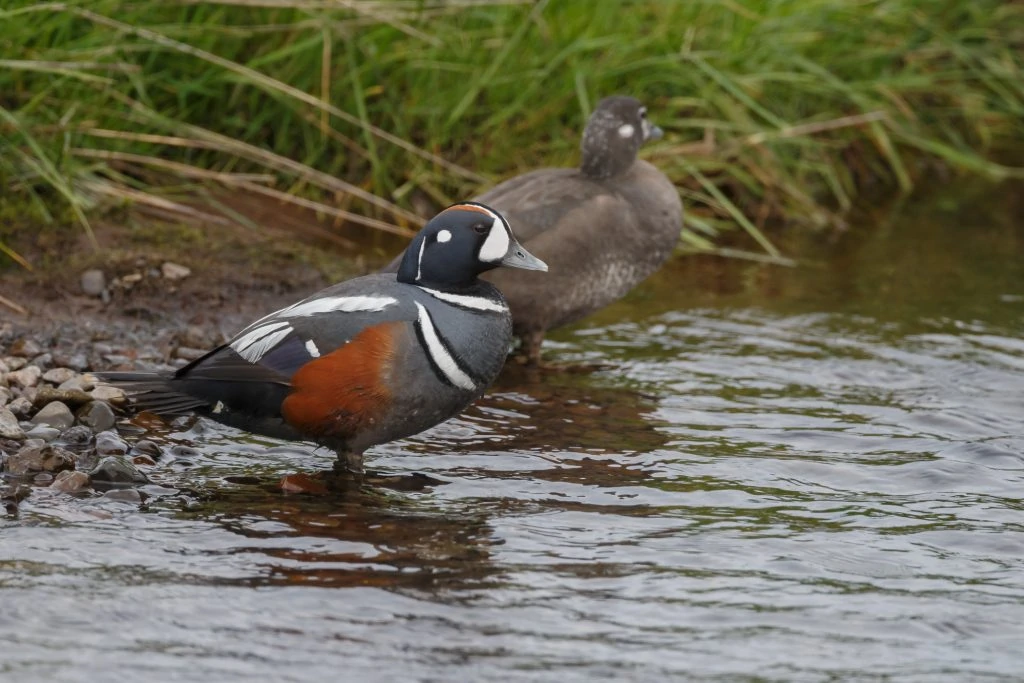
Harlequin Ducks are mainly spotted during winter in the northeast of the United States, especially along the coasts.
Harlequin Ducks are small, extremely striking sea ducks. They are instantly recognizable because of their unique multi-color and multi-patterned features. Breeding males are more colorful than females.
They have a slate blue color on their head, neck, and body and reddish sides and crowns. Black-bordered white stripes line their chest, neck, and head, and a white dot behind their eyes. They also have white markings on their back.
Non-breeding males have brown bodies but the facial markings of breeding males.
Females are generally brown all over with three recognizable white markings on their heads – a small patch on top of the eye, another small patch in front of their bill, and a small dot behind the eye.
- Histrionicus histrionicus
- Length: 15 – 21 in (38 – 53 cm)
- Weight: 24 oz (680 g)
- Wingspan: 26 – 28 in (66 – 71 cm)
Harlequin Ducks breed in eastern and western Canada near the coasts and Alaska before migrating short distances to the Canadian coasts and the coasts of northeastern US states.
You can find Harlequin Ducks in fast-moving mountain streams and rivers and pounding surf and white water during the summer. In winter, you can find them on rocky, wave-lashed coasts, wherever there are turbulent waters.
Harlequin Ducks are excellent swimmers and divers used to their harsh surroundings. They easily swim through tough currents and dive for food underwater. In the process, they may get dashed against the rocks because of the turbulent waves. They eat mollusks and crustaceans, small fish, and marine worms. They also eat aquatic insects that they find on the bottom of rivers.
Harlequin Duck Song:
Nests of Harlequin Ducks are often found on the ground near the water. They may be concealed in a tree cavity, a tree stump, or a rock crevice. They are usually just a shallow depression made of grasses, twigs, and weeds and lined with down. The female lays three to ten eggs that she has to incubate for about a month.
Fun Fact: Harlequin ducks are sometimes called the “Sea Mouse” because of their mouse-like squeaks. They are also sometimes referred to as “painted ducks” because of their attractive colors.
40. Barrow’s Goldeneye
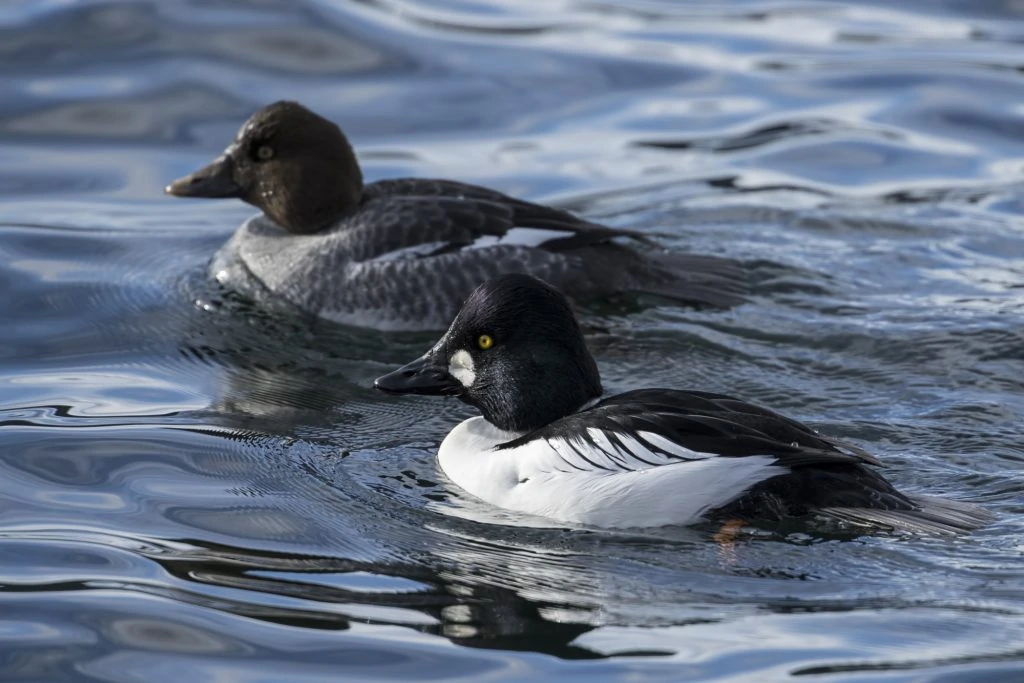
Barrow’s Goldeneyes are recognized as regularly occurring in the United States. They are spotted during the breeding season in Alaska and migrate to the northwest of the country for winter.
Barrow’s Goldeneyes are medium-sized ducks that are commonly mistaken for Common Goldeneyes because they have very similar features. Male Barrow’s Goldeneyes have black heads with a glossy purplish sheen. They have a white crescent-like patch behind their black bill.
They have golden yellow eyes and white chests and bellies. Their top half is black with distinct white shoulder bars.
Female Barrow’s Goldeneyes have gray bodies, a white collar around their necks, dark brown heads, yellow-orange bills, and the typical golden yellow eyes. They also have white wing patches like the males.
Juveniles are similar to females, except they have a faint white crescent mark of the adult males.
- Bucephala islandica
- Length: 16 – 20 in (41 – 51 cm)
- Weight: 38.4 oz (1088 g)
- Wingspan: 30 – 32 in (76 – 81 cm)
Barrow’s Goldeneye breed in western Canada, Alaska, and a few areas of eastern Canada near the coast before migrating to northwestern US states and the west coast of Canada.
You can find Barrow’s Goldeneyes in small mountain lakes and small ponds with nearby mature trees with nesting cavities. During migration, they stop at estuaries, bays, and inlets. In winter, you’ll find them along rocky ocean coasts or inland lakes.
During the breeding season, Barrow’s Goldeneyes favor aquatic insects and, in fact, will head to habitats that have no insect-eating fish around so they won’t have any competition for this type of prey. In winter, they will feast on crustaceans, mollusks, and small fish.
Barrow’s Goldeneye call:
Nests of Barrow’s Goldeneyes are usually in cavities in cliffs and trees, or they use old woodpecker holes. They may nest on the ground under a bush if there are no available cavities. The female lays six to twelve eggs and incubates them for about a month.
When they hatch, the female leads their young to where the food is so they can feed themselves. Sometimes, broods mix with other broods, particularly if the female leaves early or when broods are part of a territorial dispute among females.
Attracting Barrow’s Goldeneyes to your backyard is possible if you put up nest boxes for them before the breeding season.
Fun Fact: In Iceland, around Lake My’vatn, local residents always have nest boxes around their homes and barns for Barrow’s Goldeneyes. It has been a long-standing tradition for the people in this area to host these ducks.
41. King Eider
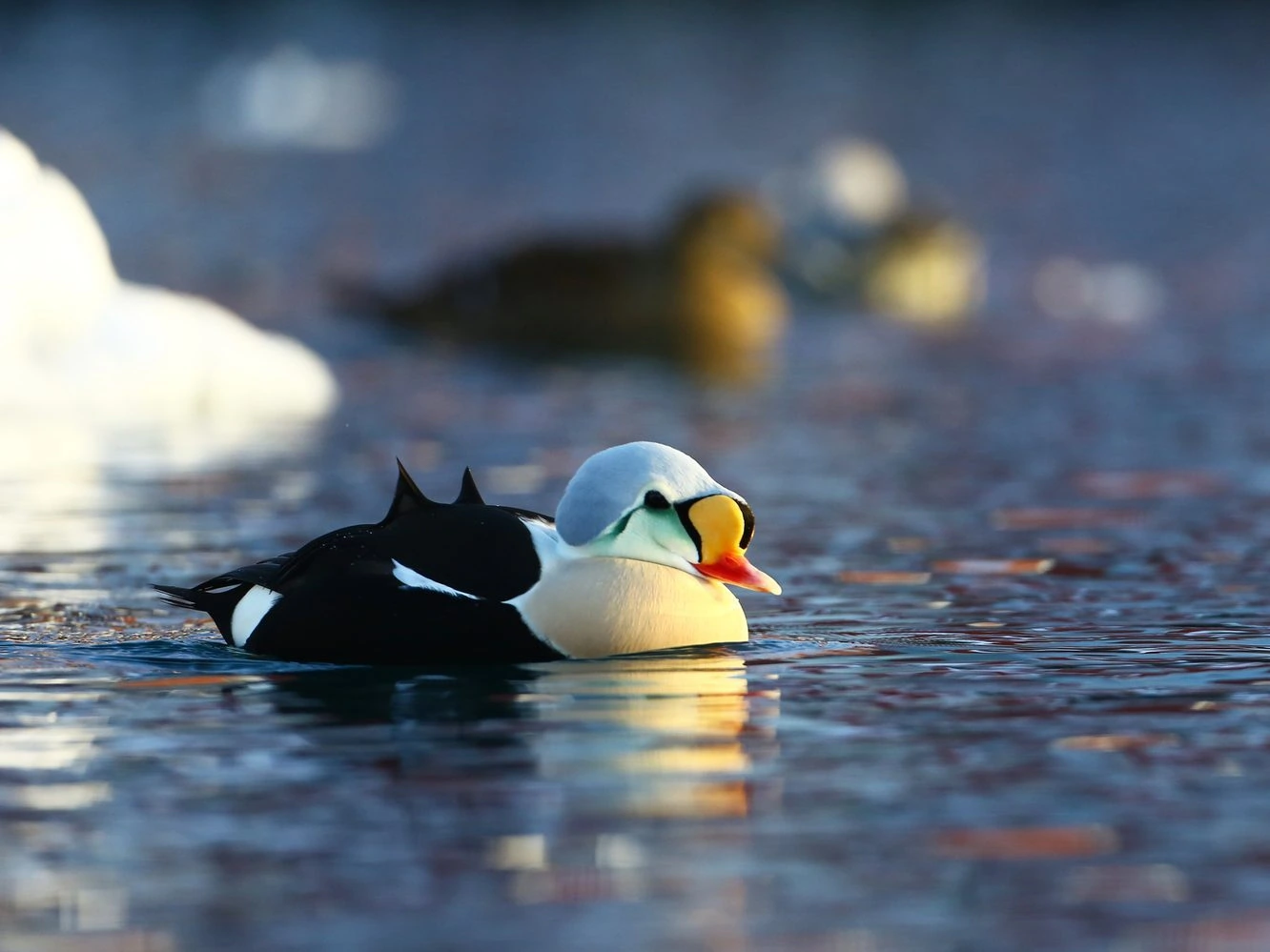
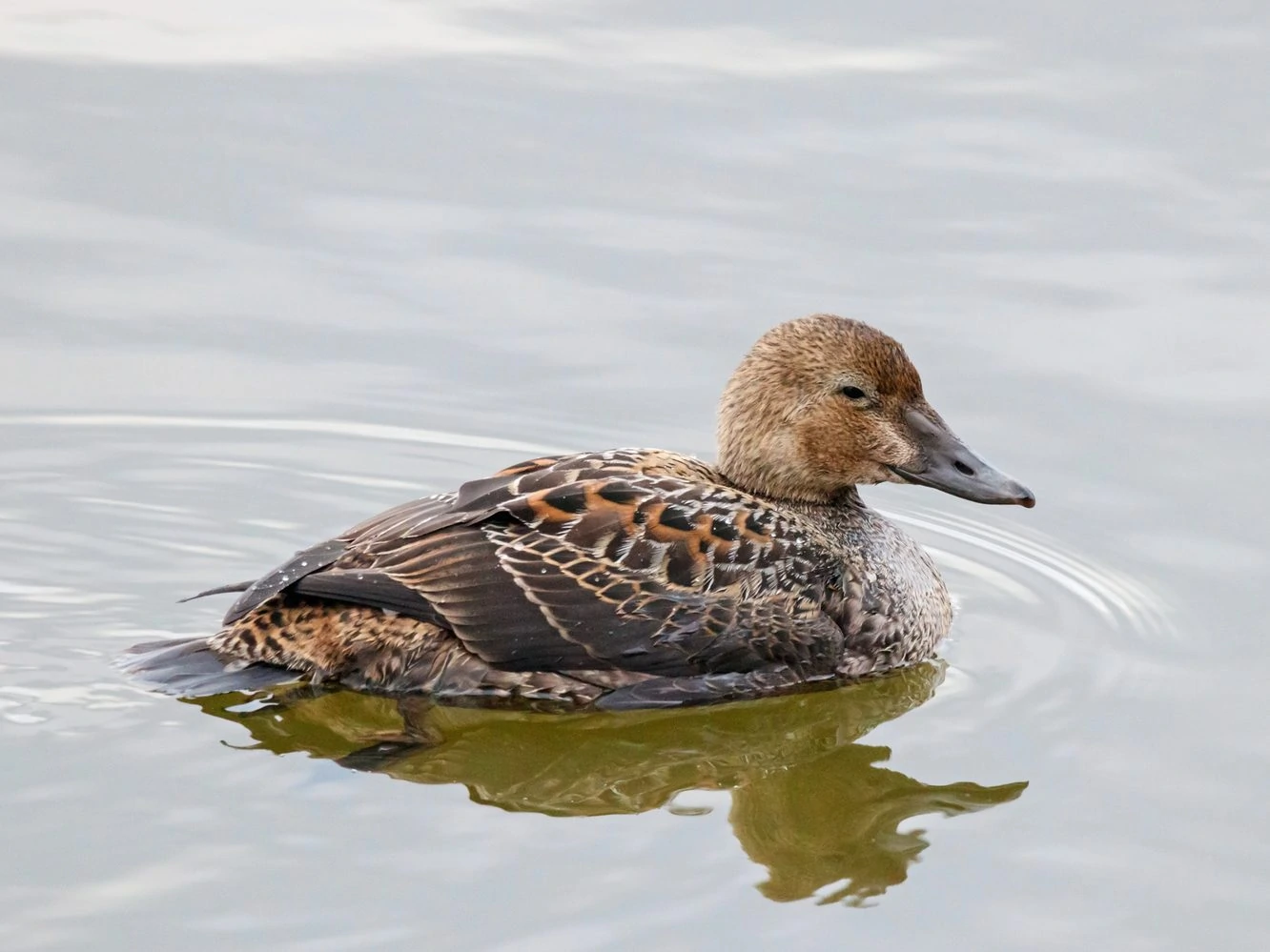
King Eiders are not very common in the United States, but they can be spotted in the northeast of the country during winter, especially along the coast.
Male King Eiders are large ducks that are often easily identifiable because of their multi-colored heads and distinct orange knob with a black outline above their short red bills.
Their crown and nape are pale-blue, but their face is greenish. Their chests are white, and their wings, bellies, and back are black. They have white patches on their wings and on the base of the tail.
Female King Eiders, or Queen Eiders, as they’re commonly called, are brown in color all around. The feathers on her back and flanks have distinct, intricate chevron patterns, while the nape and chest have fine streaky lines. Her bill is black, and her cheek and neck are plain brown.
Juveniles are dark brown like the females but have a white chest and orange bill like the males.
- Somateria spectabilis
- Length: 18 – 25 in (46 – 64 cm)
- Weight: 59.2 oz (1678 g)
- Wingspan: 35 – 40 in (89 – 102 cm)
King Eiders breed in coastal northern Canada before migrating for winter to the south coast of Alaska and the east coast of Canada, and the coasts of northeastern US states.
You can find King Eiders, usually near water and in barren tundra habitats, and they prefer rocky coasts and the open seas. They will usually mix with other wintering birds in coastal waters and can form flocks exceeding 100,000 birds. During the breeding season, they are seen in and around freshwater lakes and ponds.
When in the open sea, King Eiders dive deeply, reaching the bottom to feed off on the organisms they find there. They may also pick off prey that are on the underside of sea ice. When in lakes and ponds, they usually stay on the surface of the water, straining the water for mollusks, crustaceans, aquatic insects, and algae.
King Eider call:
Male King eider
Female King Eider
Nests of King Eiders are built by the female on the ground near water. They are usually “scrape nests”, or hollowed-out ground lined with grass and feathers from the female herself. She lays two to seven eggs that she incubates for twenty-two to twenty-three days.
Fun Fact: Spring creates an awe-inspiring migration of hundreds of thousands of King Eiders to their arctic nesting grounds.
42. Steller’s Eider
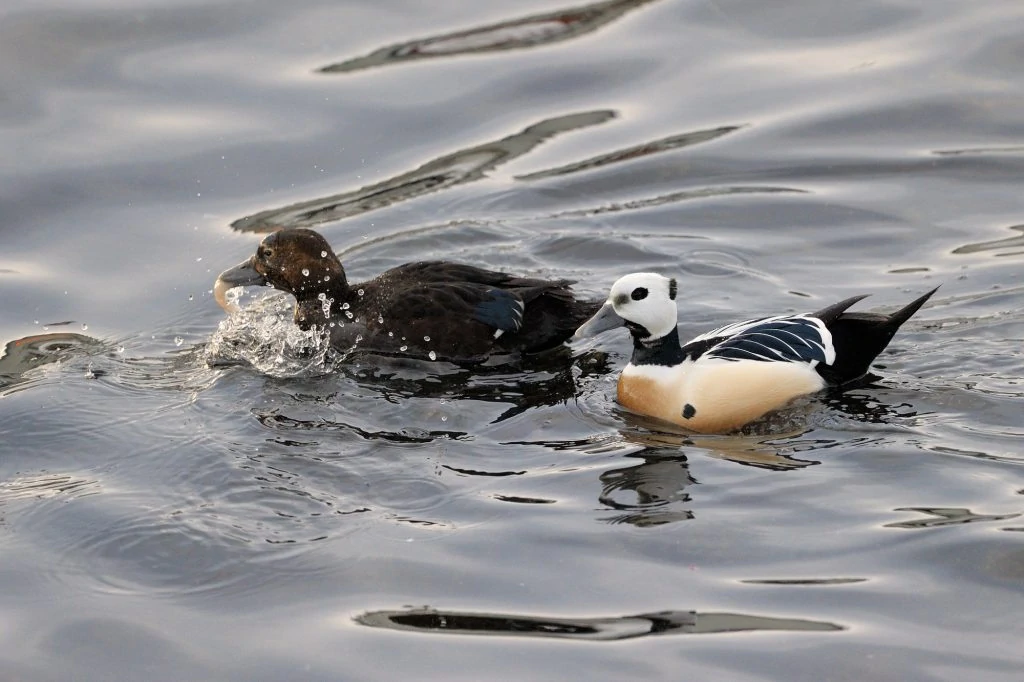
Steller’s Eiders are vulnerable species in the United States, but they can be spotted mainly in Alaska.
Breeding Adult Male Steller’s Eiders have an interesting coloring and pattern. They are buffy underneath and black and white on the back and head. Their bills, legs, and feet are blue-gray.
Adult Females are dark brown with a light white eyering. Non-breeding males resemble the females, but they are light brown. They both have the same blue-black bordered white secondary flight feathers and white underwings.
- Polysticta stelleri
- Length: 17 – 19 in (43 – 48 cm)
- Weight: 27.2 oz (771 g)
- Wingspan: 28 – 30 in (71 – 76 cm)
You can find Steller’s Eiders in very limited habitats. They’re birds of the coastlines of Alaska and Eastern Russia, and they mostly stay in coastal bays and lagoons during winter and when molting. Look for them around tidal flats when molting because that’s where they stay when they rest, as they’re flightless at this time. During nesting season, they stay in coastal tundra with sedge marshes and freshwater ponds.
Steller’s Eiders usually stay on the surface of the water when they forage. Sometimes, they stay close to shore and catch crustaceans, worms, mollusks, and mussels. On breeding grounds, they feast on beetles, small crustaceans, seeds of grasses, sedges, and other plants. They may occasionally dive into deeper water to take prey from the water column and the sea floor.
Stellar’s Eider calls:
Stellar’s Eiders breed in northern Alaska and spend the winter in southern Alaska. They also are found in northern Eurasia.
Nests of Steller’s Eiders are mostly found on raised ridges or hummocks around marshy tundra surrounded by moss, lichen, grasses, and near water.
The female is responsible for building the nest using grasses, sedges, moss, and weeds. She may add her own down feathers when she has laid the third egg. She lays from five to ten eggs that hatch after twenty-six days.
Fun Fact: The Inupiat Eskimos call Steller’s Eider “the bird that sat in the campfire” because of the males burnt orange color of its belly.
43. Spectacled Eider
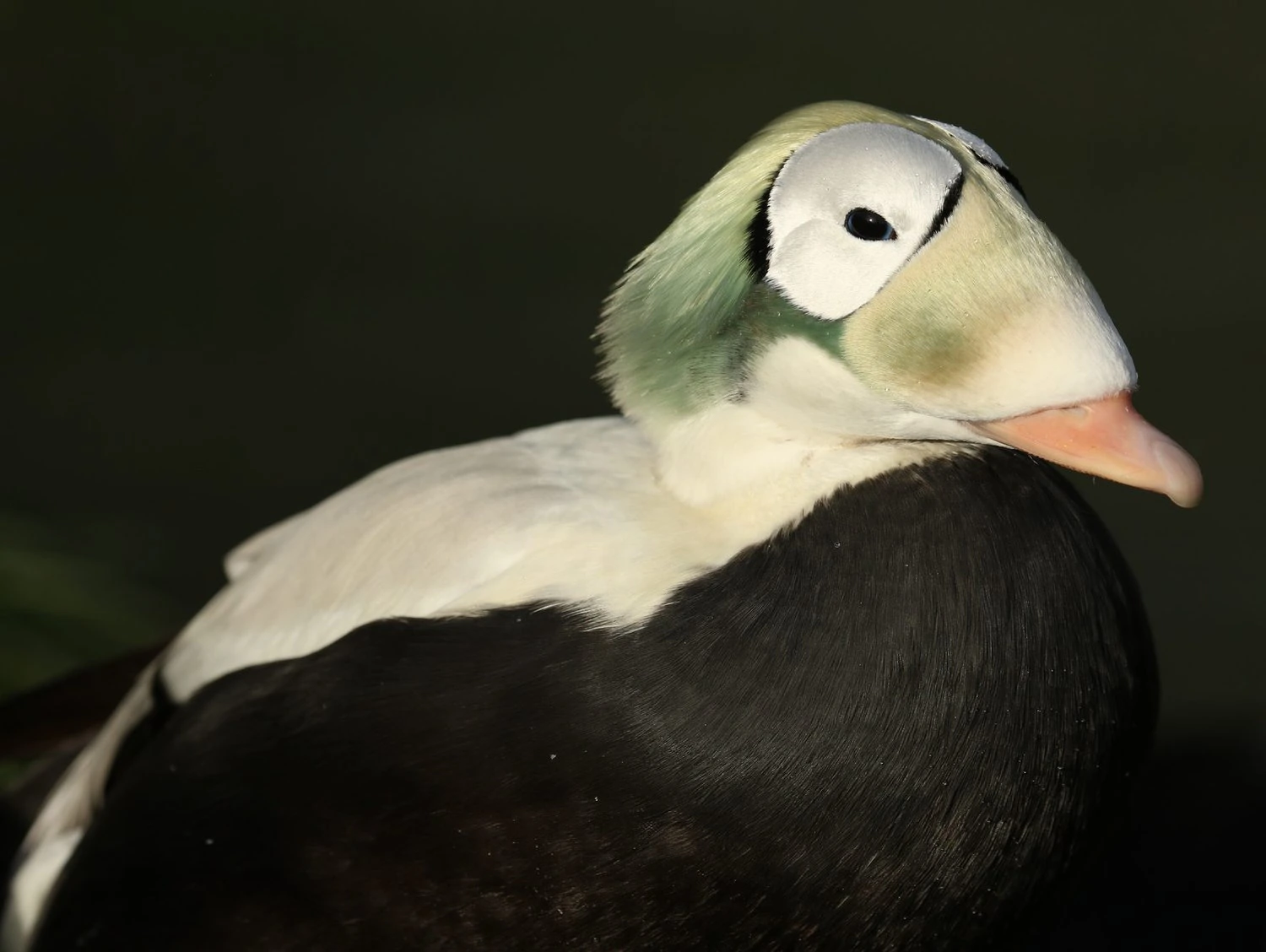
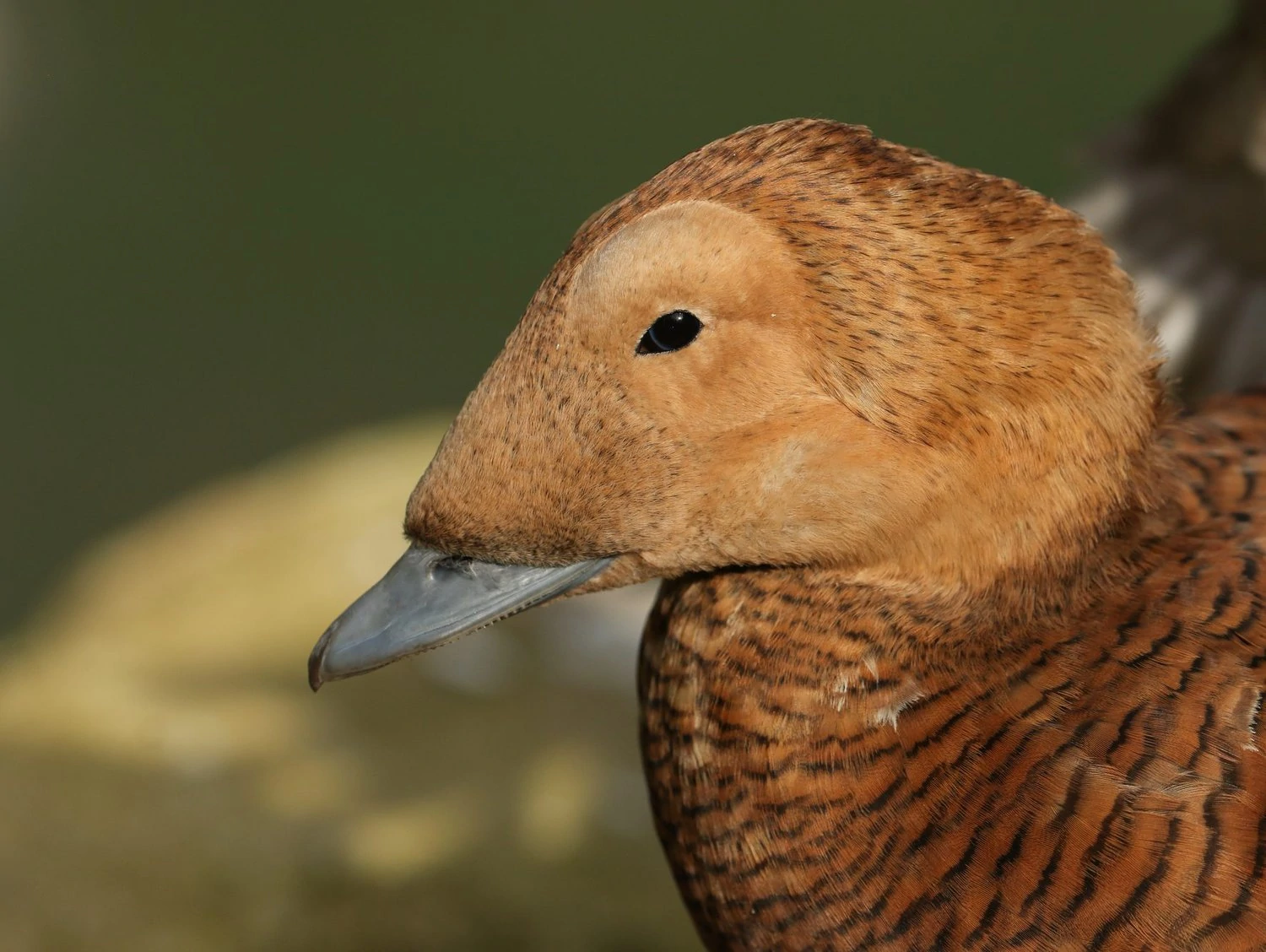
Spectacled Eiders are near-threatened species in the United States, and they have only been spotted in Alaska.
Spectacled Eiders are small ducks that are recognizable for their unique “spectacled” faces. Males have a more prominent “goggles” feature on their white faces. The goggles outline their eye area in black. They have greenish feathers at the back of their heads, and their bills are bright orange with white feathers extending up to the tip. Their upperparts are white, and their underparts are black.
Females and juveniles have light brown heads and brown bodies with even darker barrings everywhere. The “googles” or “spectacles” aren’t as prominent but are still slightly visible on the face. They also have dark bills.
- Somateria fischeri
- Length: 20 – 23 in (51 – 58 cm)
- Weight: 51.2 oz (1451 g)
- Wingspan: 35 – 36 in (89 – 91 cm)
Spectacled Eiders breed in Alaska and eastern Russia and winter in the Bering Sea.
You can find Spectacled Eiders along the open seas, coasts, and tundra (treeless plains in the Arctic) habitats. Their nesting sites are in small islands in lakes, particularly with grasses and marshes near the water’s edge. During the winter, they move to large breaks in the sea ice or polynyas.
In breeding grounds, Spectacled Eiders feast on a lot of insects, plants, and seeds. They will also dive to catch shrimp, snails, and clams. There are also plenty of mosses and sedges to eat. When they’re at sea, they feed on mollusk, clams, snails, and barnacles deep underwater.
Spectacled Eider calls:
Nests of Spectacled Eiders are usually found on small islands, pond shorelines, and hummocks (raised ridges). The female builds the nest with plant materials and her own downy feathers as lining. She will lay between three to six eggs which she solely incubates for about twenty-four days. When the eggs hatch, chicks are led to the water to find their own food.
Fun Fact: The Spectacled Eider molts at sea.
44. Smew
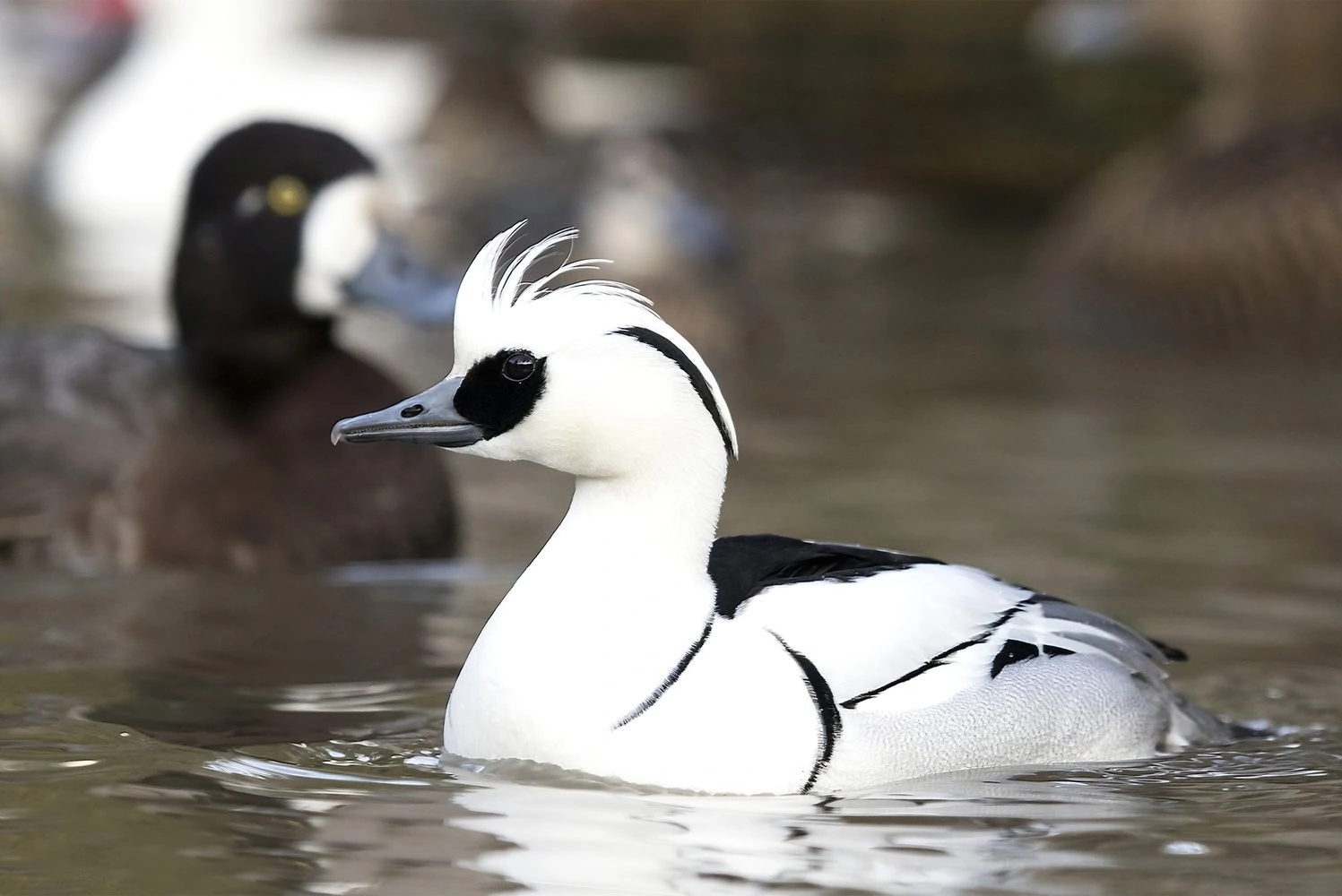
Smews are considered rare or accidental species in the United States, but there have been a few sightings in the country.
Smews are the only living members of the genus Mergellus. Male Smews are stunning since their feathers look like cracked ice. They are white overall, with a white crest and black patches and ‘veins.’
Female Smews look nothing like the males and may even be mistaken for ruddy ducks. They have reddish heads with a white patch at the base of their hooked and serrated bills, white throats, dark gray backs, and lighter gray breasts and bellies with a scaled pattern.
- Mergellus albellus
- Length: 14.5 – 17 in (37 – 43 cm)
- Weight: 22.4 oz (635 g)
- Wingspan: 24 – 26 in (61 – 66 cm)
Smews are usually found in Eurasia, but they wander into North America.
You can find Smews around fish-rich lakes and slow-moving rivers. During the breeding season, Smews will head to forests with pine trees that are near the same water regions.
Smews dive and pursue their prey underwater, such as insects and small fish.
Smew Call:
Nests of Smews are normally found in tree holes or tree cavities, such as old woodpecker nests. The female will simply line the interior with down and lay anywhere from six to nine eggs. She will incubate them for about a month.
Fun Fact: The term “smew” has been used since the 17th Century, but no one actually knows how it came to be. It was most likely derived from “smee,” a dialectal term for “wild duck.”
Other Ducks (3 Species)
Whistling ducks and Shelducks are called ducks, but they are now considered to be between ducks and geese and are in different subfamilies than the dabbling ducks or diving ducks.
Whistling ducks were once called tree ducks due to their habit of perching in trees. Shelducks are large waterfowl that are often found feeding on land.
45. Black-bellied Whistling-Duck
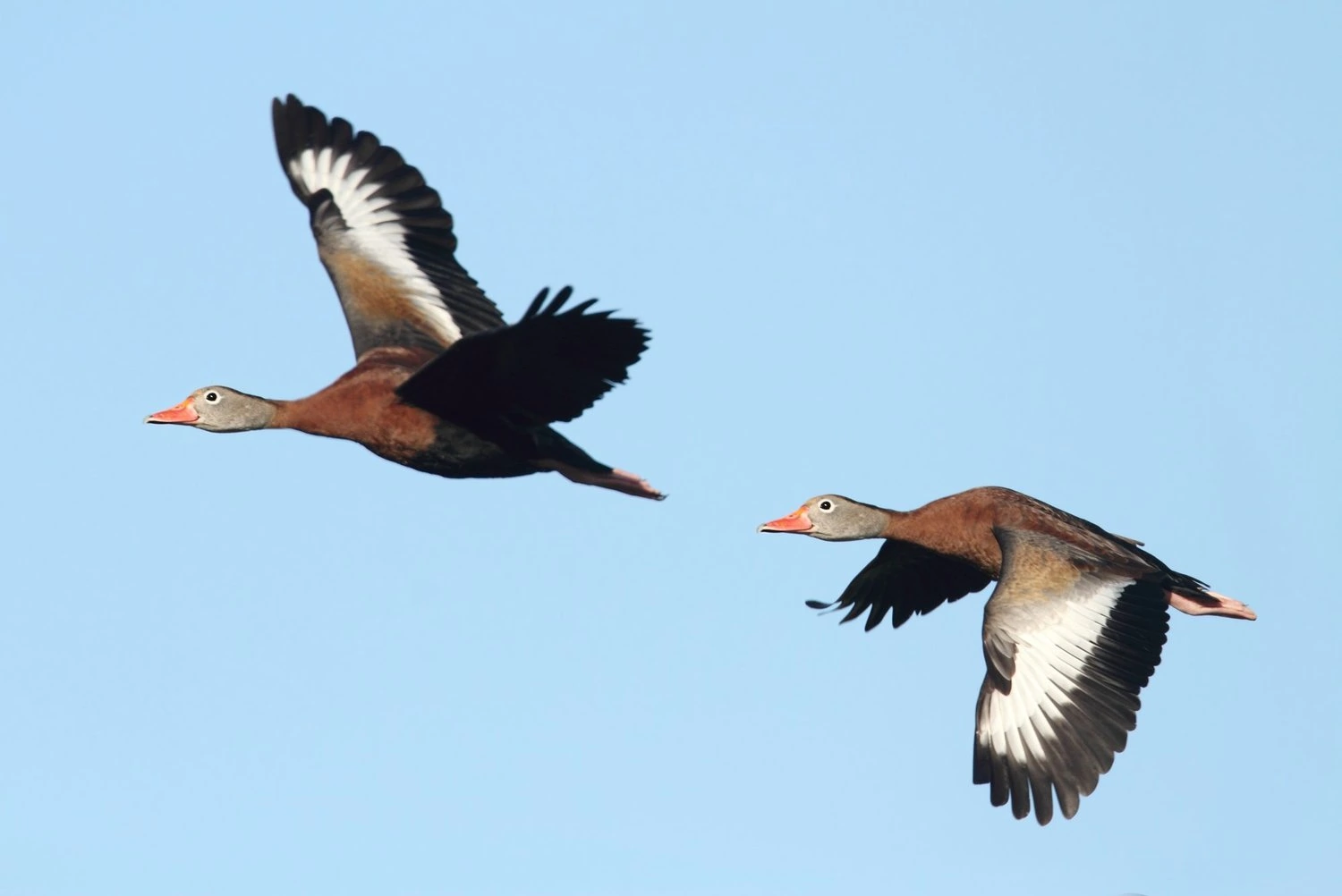
Black-bellied Whistling-Ducks are spotted all year in the United States, especially in the southeast of the country, from April to August.
Black-bellied Whistling Ducks are medium to large-sized ducks. They are quite recognizable with their bright red bill, gray face and throat, reddish-brown neck, breast and back, and pink legs. Their white wing patch is easily seen during flight. Juveniles have gray coloring on their bills and underneath their body.
- Dendrocygna autumnalis
- Length: 18 – 21 in (46 – 53 cm)
- Weight: 28.8 oz (816 g)
- Wingspan: 34 – 36 in (86 – 91 cm)
Black-bellied Whistling ducks are only found in a few areas of southern states near the Mexican border. They predominantly live all year in Mexico, Central America, and South America.
You can find Black-bellied Whistling Ducks near shallow freshwater ponds and lakes, golf courses, farmlands, and marshes.
Black-bellied Whistling Ducks roam their favorite food spots at night. They mostly eat seeds from grasses and grain from cultivated lands. They will eat insects and other water creatures when they find them, usually by scouring through the shallow water’s surface.
Black-bellied Whistling-Duck call:
Black-bellied Whistling-Duck – group calls
Black-bellied Whistling-Duck – individual
Nests of Black-bellied Whistling Ducks can be found in hollows of trees or on the ground. Since they are comfortable around humans, they may also, on occasion, build nests in abandoned buildings or nest boxes.
The female can lay as many as sixteen eggs. Both parents take turns incubating the eggs for as many as twenty-eight days. The young are capable of flight at around fifty-six days, but they don’t leave their parents until after one hundred and fifty days.
Fun Fact: They were formerly called Black-bellied Tree Ducks as they’re known for perching in trees.
46. Fulvous Whistling-Duck
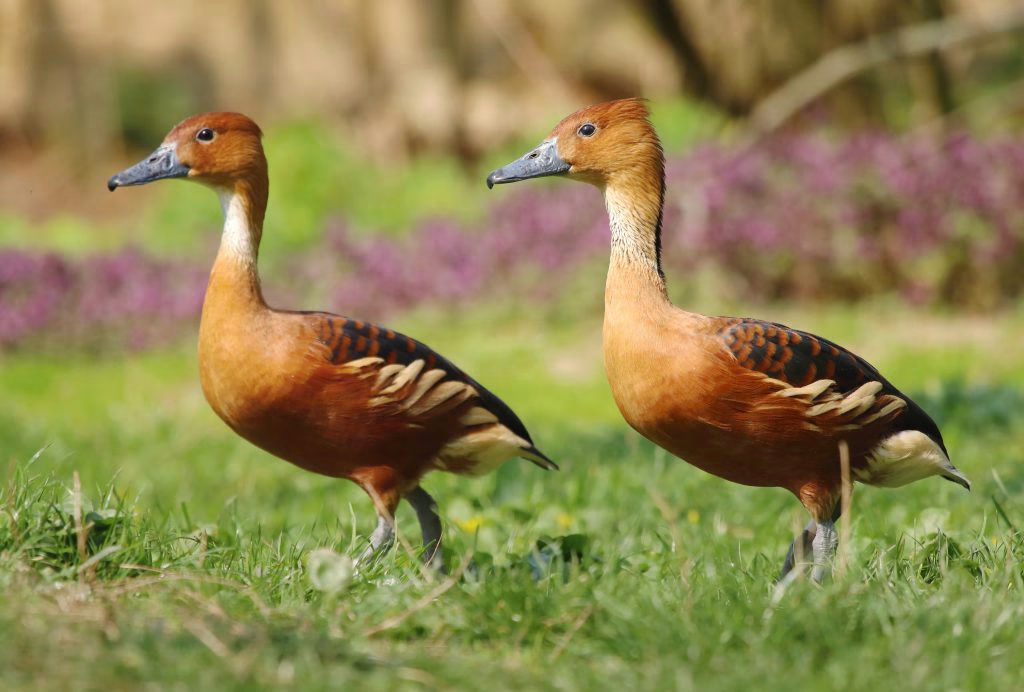
Fulvous Whistling-Ducks are not very common in the United States, but there have been sightings in the east of the country all year.
Fulvous Whistling-Ducks get their name from their reddish-yellow coloring. They are large birds that have long necks and huge legs. Their whole body is mostly reddish, with the exception of their blue-gray bill and legs.
They also have a white tail and dark brown wings. When in flight, their white bottom appears like a “U,” a striking contrast to the dark brown underside of the wings.
- Dendrocygna bicolor
- Length: 18 -21 in (45 – 53 cm)
- Weight: 25.6 oz (726 g)
- Wingspan: 36 in (91 cm)
Fulvous Whistling-Ducks are year-round residents of Florida, the coasts of Mexico, and the Caribbean. They also spend the breeding season in some southern US states.
You can find Fulvous Whistling-Ducks in places with shallow waters, like marshes and ponds. In winter, it’s possible to see them around mangrove swamps and coastal lagoons.
Fulvous Whistling-Ducks are group feeders. During the day, they often dip their head and neck in shallow water for aquatic plants, rice, and seeds. They can even dive into deep water in search of food. At night, they move with large flocks of other whistling ducks.
Fulvous Whistling-Duck call:
Nests of Fulvous Whistling-Ducks are made with plant stems and leaves. They are found on the ground, on water, or in tree cavities. Females lay between twelve to fourteen eggs per nest, but other females can also lay their eggs in someone else’s nest!
Both parents take turns incubating the eggs for about a month. Once they hatch, they can leave the nest after a day, but it takes around nine weeks for them to learn how to fly.
Fun Fact: Fulvous Whistling-Ducks are impatient and lay their eggs in their nest even when it’s not completely built. Sometimes, this results in losing some of the eggs.
47. Common Shelduck
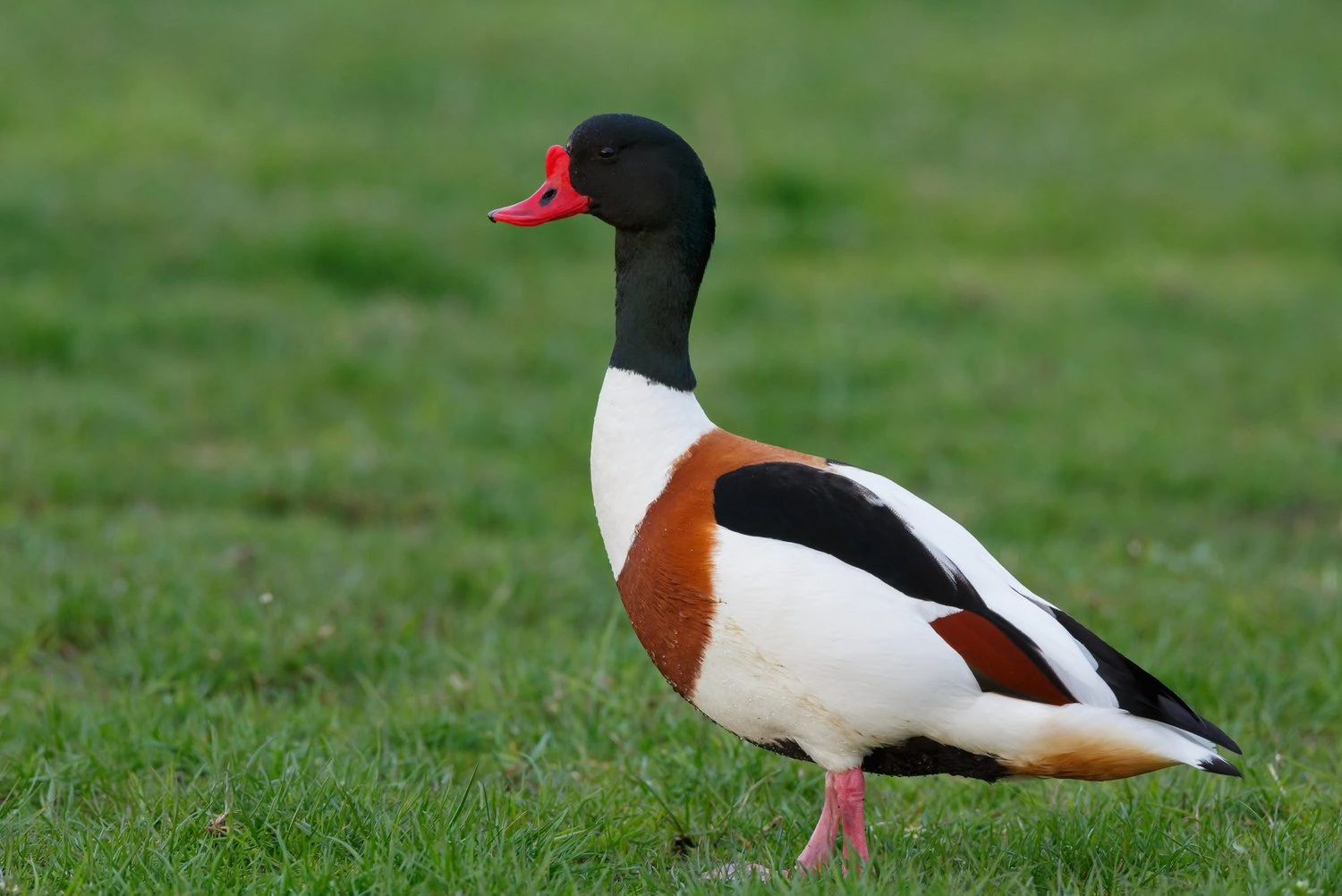
Common Shelducks are extremely rare in the United States and are considered accidental species, and there have been some recorded sightings in the east of the country.
Male Common Shelducks are easy to spot. They have striking dark green (almost black) heads with bright, reddish-pink bills that have a large knob at the base. Their bodies are white with a reddish-brown band around their breasts and patches of black on their sides and bellies. Females have the same but duller coloring and pattern as males.
- Tadorna tadorna
- Length: 25 in (63.5 cm)
- Weight: 35.2 oz (997 g)
- Wingspan: 39 in (100 cm)
Common Shelducks are usually found in Eurasia and North Africa, but they are sometimes spotted in North America.
You can find Common Shelducks in marshes and estuaries. They are also commonly found in coastal areas and inland waters like lakes and rivers.
Common Shelducks often feed on invertebrates, small shellfish, and aquatic snails. Mollusks, crustaceans, and insects are their staple food. They are known to feed at night.
Common Shelduck Call:
Nests of Common Shelducks are usually in enclosed spaces, like artificial structures, hollows of trees, haystacks, and gnarled roots. They are also known to use the burrows of animals like rabbits or badgers.
The female lays eight to ten eggs, but the nest may contain more when other females dump their own eggs in. The incubation period lasts a month, and when the young hatch, some of them join a “nursery” of other young and are taken care of by other adults in the flock.
Fun Fact: Common Shelducks sometimes stomp their feet on the sand or mud to rattle the snails buried under and bring them to the surface.
How To Identify Ducks
There are a few identifying features to help you identify ducks more quickly as they are often at a distance or in flight.
Beak shape
Some ducks have distinctive beaks, such as shovelers, canvasbacks, and mergansers. So get to know these ducks first to narrow down or discount the species.
White Patches
Ducks are often only seen from a distance and may be mixed with other species, and the lighting conditions may not be great. So how do you learn to recognize one of these many species?
The best way to identify ducks, especially when they are at a distance, is to get to know ‘where is the white.’ The white patches on ducks stand out and help you to identify which duck you have spotted more quickly.
Calls
Some ducks have distinctive calls and not just your general ‘quack’, so get to know some calls by listening to the calls in each of the summaries below.
Heads and Tails
Some ducks have crests or unusual head shapes, such as wood ducks or mergansers, so get to know these.
Not all ducks have short tails, some have long or curled tails, such as pintails, long-tailed ducks, and ruddy ducks.
Ducks By Season
Checklists for the state are a great resource to find out which birds are commonly spotted. These lists show which ducks are most commonly recorded on checklists for the United States on ebird in summer and winter.
Ducks in the United States in Summer:
Mallard 20.6%
Wood Duck 7.2%
Blue-winged Teal 2.7%
Gadwall 2.6%
Northern Shoveler 1.9%
Ruddy Duck 1.7%
Common Merganser 1.4%
Cinnamon Teal 1.4%
Green-winged Teal 1.3%
Black-bellied Whistling-Duck 1.1%
Hooded Merganser 1.0%
American Wigeon 1.0%
Bufflehead 0.9%
Redhead 0.9%
Ring-necked Duck 0.9%
Lesser Scaup 0.8%
Northern Pintail 0.8%
American Black Duck 0.8%
Red-breasted Merganser 0.7%
Common Eider 0.6%
Mottled Duck 0.5%
Surf Scoter 0.4%
Greater Scaup 0.4%
Falcated Duck 0.4%
Canvasback 0.3%
Common Goldeneye 0.3%
Long-tailed Duck 0.3%
Harlequin Duck 0.2%
White-winged Scoter 0.2%
Black Scoter 0.2%
Barrow’s Goldeneye 0.2%
Muscovy Duck 0.1%
Fulvous Whistling-Duck 0.1%
Mexican Duck 0.1%
King Eider 0.1%
Eurasian Wigeon <0.1%
Spectacled Eider <0.1%
Steller’s Eider <0.1%
Tufted Duck <0.1%
Garganey <0.1%
Mandarin Duck <0.1%
Smew <0.1%
Masked Duck <0.1%
Common Pochard <0.1%
White-cheeked Pintail <0.1%
Common Shelduck <0.1%
Baikal Teal <0.1%
Ducks in the United States in Winter:
Mallard 20.8%
Bufflehead 10.4%
Common Goldeneye 6.6%
Hooded Merganser 6.5%
Gadwall 6.3%
Ring-necked Duck 5.9%
Northern Shoveler 5.9%
American Wigeon 5.7%
Common Merganser 5.5%
Ruddy Duck 5.2%
Green-winged Teal 4.5%
Red-breasted Merganser 4.3%
Lesser Scaup 4.3%
American Black Duck 4.1%
Northern Pintail 3.7%
Redhead 2.6%
Canvasback 2.3%
Greater Scaup 2.1%
Surf Scoter 2.0%
Wood Duck 1.9%
Blue-winged Teal 1.7%
Long-tailed Duck 1.6%
White-winged Scoter 1.1%
Cinnamon Teal 1.1%
Mottled Duck 1.1%
Common Eider 1.1%
Black Scoter 0.9%
Black-bellied Whistling-Duck 0.6%
Barrow’s Goldeneye 0.6%
Harlequin Duck 0.5%
Eurasian Wigeon 0.4%
Muscovy Duck 0.3%
Mexican Duck 0.1%
Fulvous Whistling-Duck 0.1%
King Eider 0.1%
Tufted Duck <0.1%
Mandarin Duck <0.1%
Steller’s Eider <0.1%
Garganey <0.1%
Falcated Duck <0.1%
White-cheeked Pintail <0.1%
Masked Duck <0.1%
Common Pochard <0.1%
Smew <0.1%
Baikal Teal <0.1%
Common Shelduck <0.1%
Spectacled Eider <0.1%

